Sony Group MEXN4000BT Bluetooth Audio System User Manual MEX N4000BT
Sony Corporation Bluetooth Audio System MEX N4000BT
(Short term Confidential)Users Manual
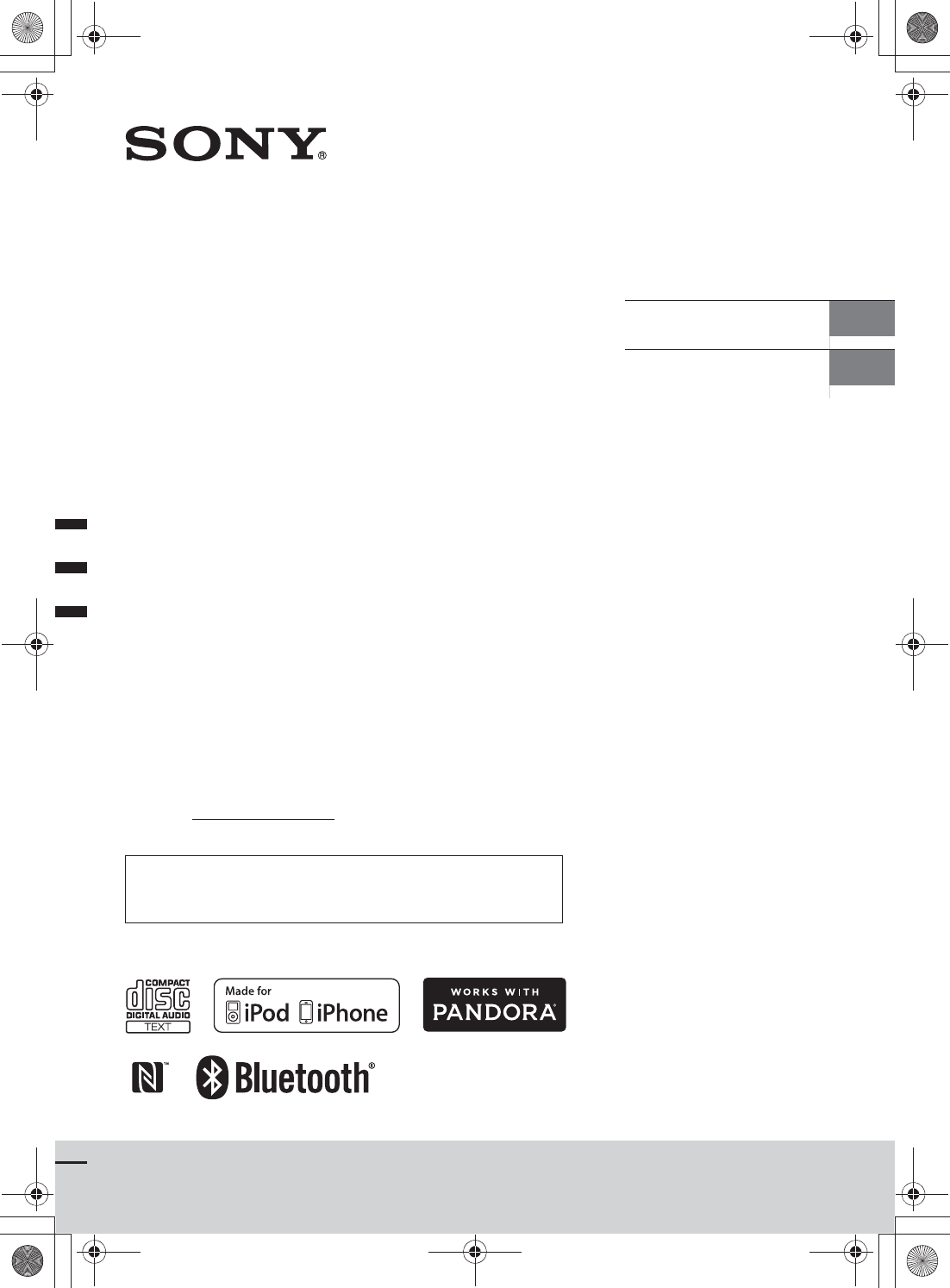
F:\yoshida\1115\4489688111\4489688111MEXN4000BTUC\01GB-MEXN4000BTUC\010COV.fm masterpage: Cover
MEX-N4000BT
4-489-688-11(1)
MEX-N4000BT
4-489-688-11(1)
Bluetooth®
Audio System
Owner’s Record
The model and serial numbers are located on the bottom of the
unit.
Record the serial number in the space provided below.
Refer to these numbers whenever you call upon your Sony dealer
regarding this product.
Model No. MEX-N4000BT
Serial No.
Operating Instructions GB
Manual de instrucciones ES
To cancel the demonstration (DEMO) display, see page 16.
Para cancelar la pantalla de demostración (DEMO), consulte la
página 18.
010COV.book Page 1 Friday, November 15, 2013 11:49 AM

2GB
F:\yoshida\1115\4489688111\4489688111MEXN4000BTUC\01GB-MEXN4000BTUC\020INT.fm masterpage: Left
MEX-N4000BT
4-489-688-11(1)
Warning
This equipment has been tested and found to
comply with the limits for a Class B digital device,
pursuant to Part 15 of the FCC Rules.
These limits are designed to provide reasonable
protection against harmful interference in a
residential installation. This equipment generates,
uses, and can radiate radio frequency energy and, if
not installed and used in accordance with the
instructions, may cause harmful interference to
radio communications.
However, there is no guarantee that interference
will not occur in a particular installation. If this
equipment does cause harmful interference to
radio or television reception, which can be
determined by turning the equipment off and on,
the user is encouraged to try to correct the
interference by one or more of the following
measures:
ˋReorient or relocate the receiving antenna.
ˋIncrease the separation between the equipment
and receiver.
ˋConnect the equipment into an outlet on a circuit
different from that to which the receiver is
connected.
ˋConsult the dealer or an experienced radio/TV
technician for help.
You are cautioned that any changes or
modifications not expressly approved in this
manual could void your authority to operate this
equipment.
This device complies with Part 15 of the FCC Rules.
Operation is subject to the following two
conditions: (1) this device may not cause harmful
interference, and (2) this device must accept any
interference received, including interference that
may cause undesired operation.
This transmitter must not be co-located or operated
in conjunction with any other antenna or
transmitter.
This equipment complies with FCC radiation
exposure limits set forth for an uncontrolled
environment and meets the FCC radio frequency
(RF) Exposure Guidelines. This equipment has very
low levels of RF energy that it deemed to comply
without maximum permissive exposure evaluation
(MPE). But it is desirable that it should be installed
and operated keeping the radiator at least 20 cm or
more away from person's body (excluding
extremities: hands, wrists, feet and ankles).
CAUTION
The use of optical instruments with this product will
increase eye hazard.
For the State of California, USA only
Perchlorate Material – special handling may apply,
See
www.dtsc.ca.gov/hazardouswaste/perchlorate
Perchlorate Material: Lithium battery contains
perchlorate
Note on the lithium battery
Do not expose the battery to excessive heat such as
direct sunlight, fire or the like.
Be sure to install this unit in the dashboard of the
car for safety.
For installation and connections, see the
supplied installation/connections manual.
Warning if your car’s ignition has no ACC
position
Be sure to set the AUTO OFF function (page 17).
The unit will shut off completely and
automatically in the set time after the unit is
turned off, which prevents battery drain. If you
do not set the AUTO OFF function, press and hold
OFF until the display disappears each time you
turn the ignition off.
010COV.book Page 2 Friday, November 15, 2013 11:49 AM

3GB
F:\yoshida\1115\4489688111\4489688111MEXN4000BTUC\01GB-MEXN4000BTUC\020INT.fm masterpage: Right
MEX-N4000BT
4-489-688-11(1)
Caution
IN NO EVENT SHALL SONY BE LIABLE FOR ANY
INCIDENTAL, INDIRECT OR CONSEQUENTIAL
DAMAGES OR OTHER DAMAGES INCLUDING,
WITHOUT LIMITATION, LOSS OF PROFITS, LOSS OF
REVENUE, LOSS OF DATA, LOSS OF USE OF THE
PRODUCT OR ANY ASSOCIATED EQUIPMENT,
DOWNTIME, AND PURCHASER’S TIME RELATED TO
OR ARISING OUT OF THE USE OF THIS PRODUCT, ITS
HARDWARE AND/OR ITS SOFTWARE.
IMPORTANT NOTICE!
Safe and efficient use
Changes or modifications to this unit not expressly
approved by Sony may void the user’s authority to
operate the equipment.
Please check for exceptions, due to national
requirement or limitations, in usage of BLUETOOTH
equipment before using this product.
Driving
Check the laws and regulations on the use of
cellular phones and handsfree equipment in the
areas where you drive.
Always give full attention to driving and pull off the
road and park before making or answering a call if
driving conditions so require.
Connecting to other devices
When connecting to any other device, please read
its user guide for detailed safety instructions.
Radio frequency exposure
RF signals may affect improperly installed or
inadequately shielded electronic systems in cars,
such as electronic fuel injection systems, electronic
antiskid (antilock) braking systems, electronic
speed control systems or air bag systems. For
installation or service of this device, please consult
with the manufacturer or its representative of your
car. Faulty installation or service may be dangerous
and may invalidate any warranty that may apply to
this device.
Consult with the manufacturer of your car to ensure
that the use of your cellular phone in the car will not
affect its electronic system.
Check regularly that all wireless device equipment
in your car is mounted and operating properly.
Emergency calls
This BLUETOOTH car handsfree and the electronic
device connected to the handsfree operate using
radio signals, cellular, and landline networks as well
as user-programmed function, which cannot
guarantee connection under all conditions.
Therefore do not rely solely upon any electronic
device for essential communications (such as
medical emergencies).
Remember, in order to make or receive calls, the
handsfree and the electronic device connected to
the handsfree must be switched on in a service area
with adequate cellular signal strength.
Emergency calls may not be possible on all cellular
phone networks or when certain network services
and/or phone features are in use.
Check with your local service provider.
Notes on BLUETOOTH function
010COV.book Page 3 Friday, November 15, 2013 11:49 AM
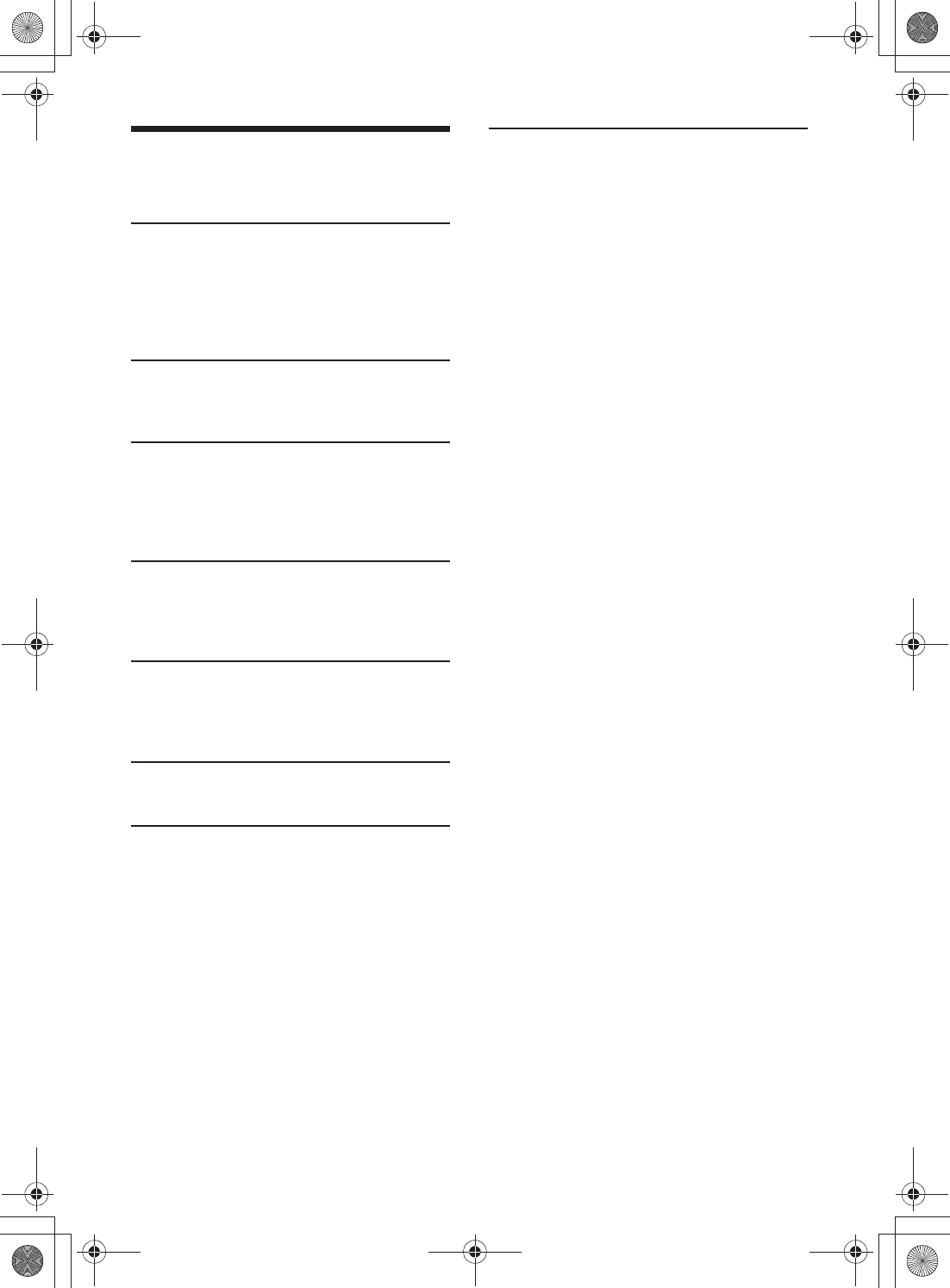
4GB
F:\yoshida\1115\4489688111\4489688111MEXN4000BTUC\01GB-MEXN4000BTUC\030TOC.fm masterpage: Left
MEX-N4000BT
4-489-688-11(1)
Table of Contents
Warning . . . . . . . . . . . . . . . . . . . . . . . . . . . . . . . . . . . 2
Guide to Parts and Controls . . . . . . . . . . . . . . . . . . . 5
Getting Started
Detaching the Front Panel . . . . . . . . . . . . . . . . . . . . 6
Setting the Clock . . . . . . . . . . . . . . . . . . . . . . . . . . . . 6
Preparing a BLUETOOTH Device. . . . . . . . . . . . . . . . 7
Connecting an iPod/USB Device . . . . . . . . . . . . . . . 8
Connecting Other Portable Audio Device . . . . . . . . 9
Listening to the Radio
Listening to the Radio. . . . . . . . . . . . . . . . . . . . . . . . 9
Using Radio Data System (RDS) . . . . . . . . . . . . . . . 10
Playback
Playing a Disc . . . . . . . . . . . . . . . . . . . . . . . . . . . . . 10
Playing an iPod/USB Device. . . . . . . . . . . . . . . . . . 10
Playing a BLUETOOTH Device. . . . . . . . . . . . . . . . . 11
Searching and Playing Tracks. . . . . . . . . . . . . . . . . 11
Listening to Pandora®
Preparing for Pandora®. . . . . . . . . . . . . . . . . . . . . . 12
Streaming Pandora® . . . . . . . . . . . . . . . . . . . . . . . . 12
Available Operations in the Pandora®. . . . . . . . . . 13
Handsfree Calling
Receiving a Call . . . . . . . . . . . . . . . . . . . . . . . . . . . . 13
Making a Call . . . . . . . . . . . . . . . . . . . . . . . . . . . . . . 13
Available Operations during Call . . . . . . . . . . . . . . 14
Useful Functions
App Remote with iPhone/Android Phone . . . . . . 15
Settings
Canceling the DEMO Mode . . . . . . . . . . . . . . . . . . 16
Basic Setting Operation . . . . . . . . . . . . . . . . . . . . . 16
GENERAL Setup . . . . . . . . . . . . . . . . . . . . . . . . . . . . 16
SOUND Setup. . . . . . . . . . . . . . . . . . . . . . . . . . . . . . 17
EQ10 PRESET . . . . . . . . . . . . . . . . . . . . . . . . . . . 17
EQ10 SETTING . . . . . . . . . . . . . . . . . . . . . . . . . . 17
POSITION (listening position). . . . . . . . . . . . . . 17
RB ENH (rear bass enhancer) . . . . . . . . . . . . . . 18
SW DIREC (subwoofer direct connection) . . . . 18
DISPLAY Setup . . . . . . . . . . . . . . . . . . . . . . . . . . . . . 18
BT (BLUETOOTH) Setup . . . . . . . . . . . . . . . . . . . . . . 18
BT INIT (BLUETOOTH initialize) . . . . . . . . . . . . . 19
APP REM (App Remote) Setup . . . . . . . . . . . . . . . . 19
Additional Information
Precautions . . . . . . . . . . . . . . . . . . . . . . . . . . . . . . . 19
Maintenance . . . . . . . . . . . . . . . . . . . . . . . . . . . . . . 21
Specifications . . . . . . . . . . . . . . . . . . . . . . . . . . . . . 22
Troubleshooting . . . . . . . . . . . . . . . . . . . . . . . . . . . 23
010COV.book Page 4 Friday, November 15, 2013 11:49 AM
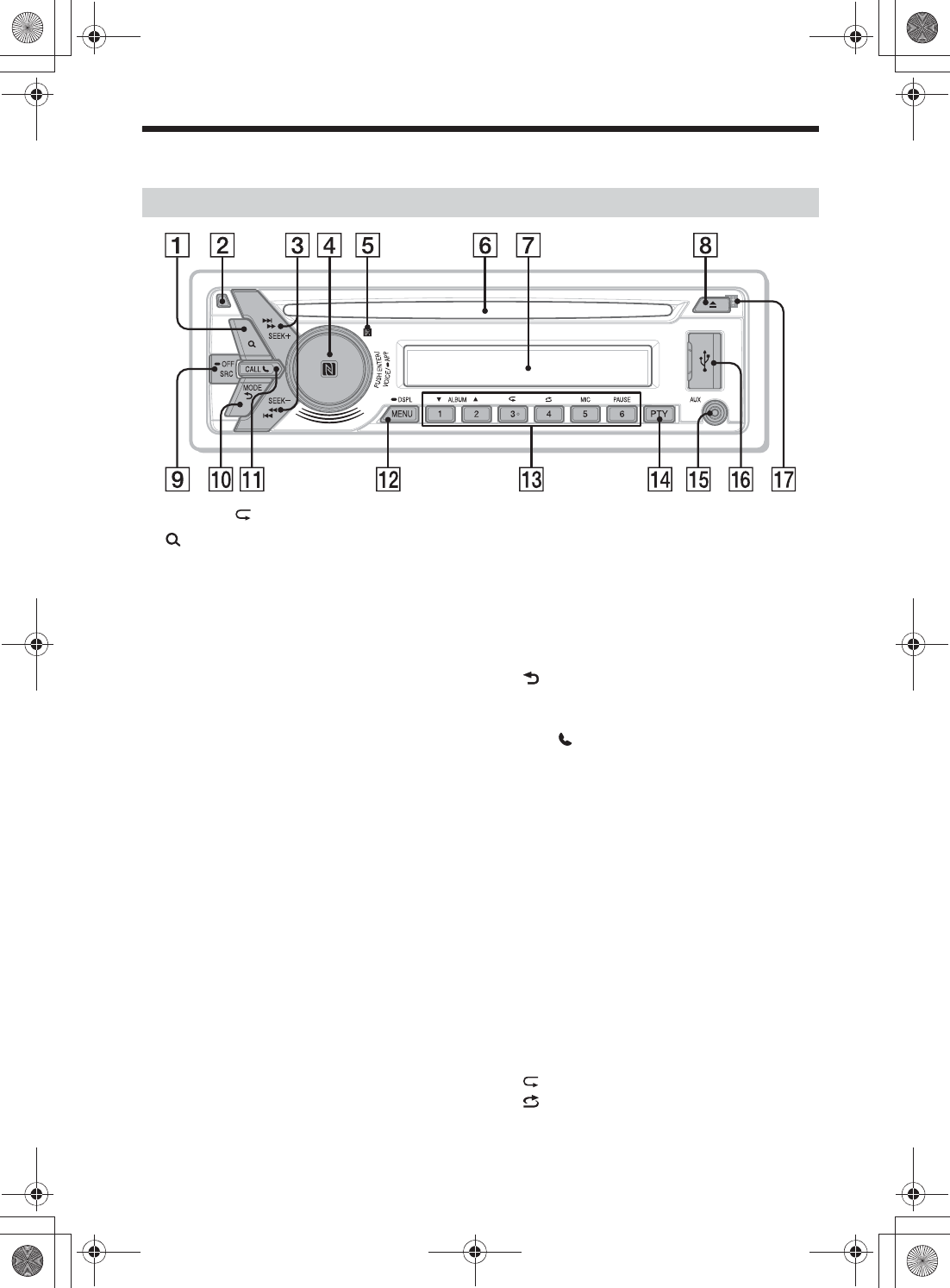
5GB
F:\yoshida\1115\4489688111\4489688111MEXN4000BTUC\01GB-MEXN4000BTUC\040CD.fm masterpage: Right
MEX-N4000BT
4-489-688-11(1)
Guide to Parts and Controls
The number 3/ (repeat) button has a tactile dot.
ȩ (browse) (page 11, 13)
Enter the browse mode during playback.
ȪFront panel release button
ȫSEEK +/–
Tune in radio stations automatically. Press and
hold to tune manually.
Ã/Ñ (prev/next)
ù/ß (fast-reverse/fast-forward)
ȬControl dial
Rotate to adjust the volume.
ENTER
Enter the selected item.
Press SRC, rotate then press to change the
source.
VOICE (page 14)
Activate voice dial.
When the App Remote function is on, the voice
recognition is activated (Android™ phone only).
-APP
Press and hold for more than 2 seconds to
establish App Remote function (connection).
N-Mark
Touch the control dial with Android phone to
make BLUETOOTH connection.
ȭReceptor for the remote commander
ȮDisc slot
ȯDisplay window
Ȱì (disc eject)
ȱSRC (source)
Turn on the power.
Change the source.
-OFF
Press and hold for 1 second to turn off the
power.
Press and hold for more than 2 seconds to turn
off the power and the display.
If the unit is turned off and the display
disappears, it is unable you to operate with the
remote.
Ȳ (back)
Return to the previous display.
MODE (page 9, 11, 13, 14)
ȳCALL
Enter the call menu. Receive/end a call.
Press and hold more than 2 seconds to switch
the BLUETOOTH signal.
ȴMENU
Open the setup menu.
-DSPL (display)
Press and hold, then press to change display
items.
ȵNumber buttons (1 to 6)
Receive stored radio stations. Press and hold to
store stations.
Call a stored phone number. Press and hold to
store a phone number.
ALBUM è/Ă
Skip an album for audio device. Press and hold
to skip albums continuously.
Press Ă to thumbs up, or è to thumbs down in
Pandora® (page 13).
(repeat)
(shuffle)
MIC (page 14)
Main unit
010COV.book Page 5 Friday, November 15, 2013 11:49 AM
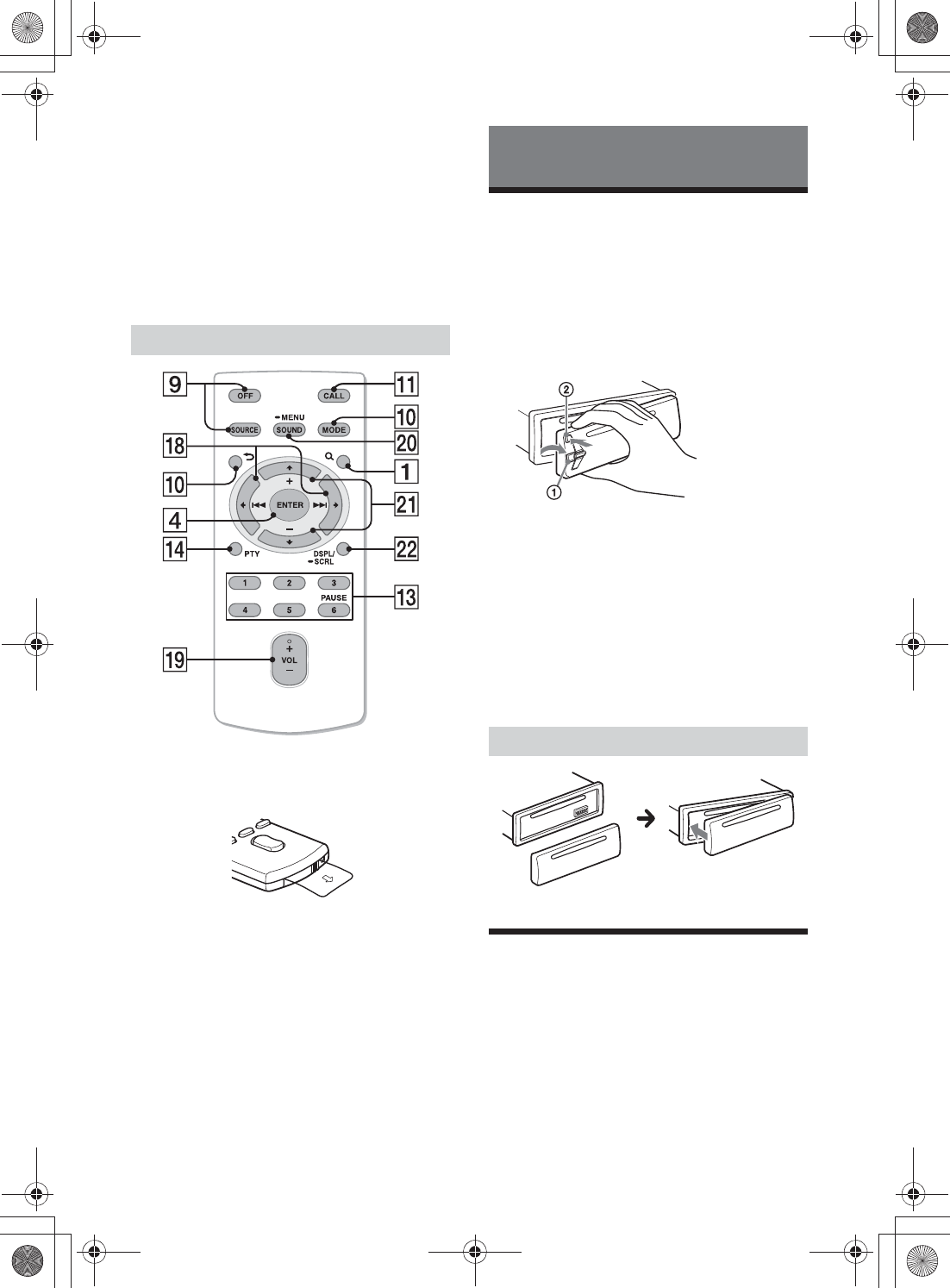
6GB
F:\yoshida\1115\4489688111\4489688111MEXN4000BTUC\01GB-MEXN4000BTUC\040CD.fm masterpage: Left
MEX-N4000BT
4-489-688-11(1)
PAUSE
ȶPTY (program type)
Select PTY in RDS.
ȷAUX input jack
ȸUSB port
ȹMicrophone (on inner panel)
In order for the handsfree function to work
properly, do not cover the microphone with
tape, etc.
The VOL (volume) + button has a tactile dot.
Remove the insulation film before use.
ȺR (Ã)/C (Ñ)
ȻVOL (Volume) +/–
ȼSOUND
Open the SOUND menu directly.
-MENU
Press and hold to open the setup menu.
Ƚa (+)/{ (–)
ȾDSPL (display)/-SCRL(scroll)
Change display items. Press and hold to scroll a
display item.
Detaching the Front Panel
You can detach the front panel of this unit to
prevent theft.
1Press and hold OFF ʓ.
The unit is turned off.
2Press the front panel release button ʔ,
then remove the panel by pulling it
towards you.
Caution alarm
If you turn the ignition switch to the OFF position
without detaching the front panel, the caution
alarm will sound for a few seconds. The alarm will
only sound if the built-in amplifier is used.
Serial numbers
Make sure the serial numbers on the bottom of the
unit and the back of the front panel are matched
correctly. Otherwise you cannot make BLUETOOTH
pairing, connection and disconnection by NFC.
Setting the Clock
1Press MENU, rotate the control dial to
select [GENERAL], then press it.
2Rotate the control dial to select [CLOCK-
ADJ], then press it.
The hour indication flashes.
RM-X231 Remote
Getting Started
Attaching the front panel
010COV.book Page 6 Friday, November 15, 2013 11:49 AM
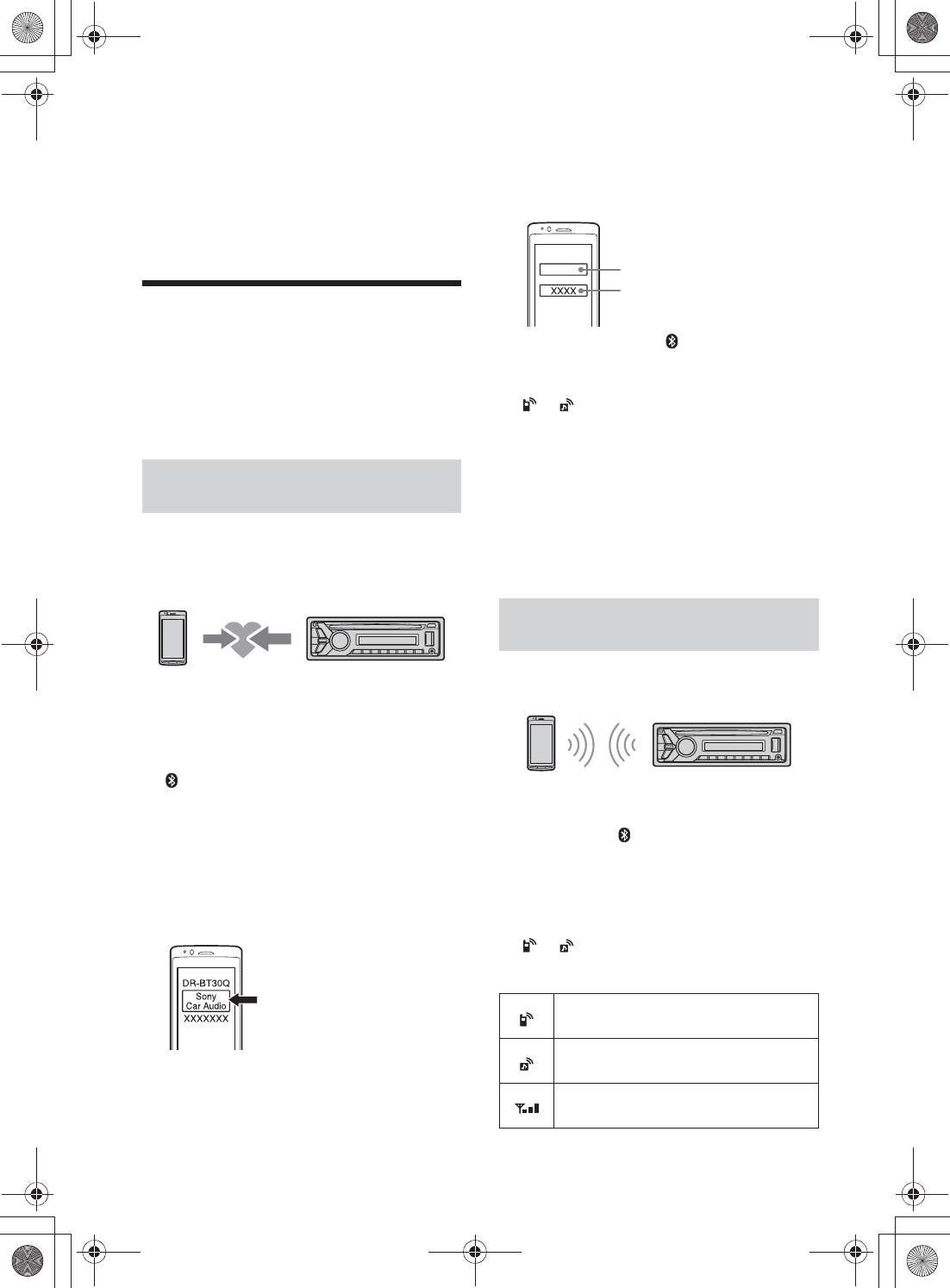
7GB
F:\yoshida\1115\4489688111\4489688111MEXN4000BTUC\01GB-MEXN4000BTUC\040CD.fm masterpage: Right
MEX-N4000BT
4-489-688-11(1)
3Rotate the control dial to set the hour
and minute.
To move the digital indication, press SEEK +/–.
4After setting the minute, press MENU.
The setup is complete and the clock starts.
To display the clock, press DSPL.
Preparing a BLUETOOTH Device
You can enjoy music, or perform handsfree calling,
by connecting a suitable BLUETOOTH device. For
details on connecting, refer to the operating
instructions supplied with the device.
Before connecting the device, turn down the
volume of this unit; otherwise, loud sound may
result.
When connecting a BLUETOOTH device (cellular
phone, audio device, etc.) for the first time, mutual
registration (called “pairing”) is required. Pairing
enables this unit and other devices to recognize
each other.
1Place the BLUETOOTH device within 1 m
(3 ft) of this unit.
2Press CALL, rotate the control dial to
select [PAIRING], then press it.
flashes.
The unit enters pairing standby mode.
3Perform pairing on the BLUETOOTH
device so it detects this unit.
4Select [Sony Car Audio] shown in the
display of the BLUETOOTH device.
If [Sony Car Audio] does not appear, repeat from
step 2.
5If passkey* input is required on the
BLUETOOTH device, input [0000].
* Passkey may be called “Passcode,” “PIN code,”
“PIN number” or “Password,” etc., depending on
the device.
When pairing is made, stays lit.
6Select this unit on the BLUETOOTH device
to establish the BLUETOOTH connection.
or lights up when the connection is
made.
Note
While connecting to a BLUETOOTH device, this unit
cannot be detected from another device. To enable
detection, enter the pairing mode and search for this
unit from another device.
To cancel pairing
Perform step 2 to cancel the pairing mode after this
unit and the BLUETOOTH device are paired.
To use a paired device, connection with this unit is
required. Some paired devices will connect
automatically.
1Press CALL, rotate the control dial to
select [BT SIGNL], then press it.
Make sure that lights up.
2Activate the BLUETOOTH function on the
BLUETOOTH device.
3Operate the BLUETOOTH device to
connect to this unit.
or lights up.
Icons in the display:
Pairing and connecting with a
BLUETOOTH device
Connecting with a paired BLUETOOTH
device
Lights up when a cellular phone is
connected to the unit.
Lights up when an audio device is
connected to the unit.
Indicates the signal strength status of
connected cellular phone.
[0000]
Input passkey
010COV.book Page 7 Friday, November 15, 2013 11:49 AM

8GB
F:\yoshida\1115\4489688111\4489688111MEXN4000BTUC\01GB-MEXN4000BTUC\040CD.fm masterpage: Left
MEX-N4000BT
4-489-688-11(1)
To connect the last-connected device from
this unit
Activate the BLUETOOTH function on the
BLUETOOTH device.
Press SRC.
Select [BT PHONE] or [BT AUDIO].
Press ENTER to connect with the cellular phone, or
PAUSE to connect with the audio device.
Note
While streaming BLUETOOTH audio, you cannot
connect from this unit to the cellular phone. Connect
from the cellular phone to this unit instead.
Tip
With BLUETOOTH signal on: when the ignition is turned
to on, this unit reconnects automatically to the last-
connected cellular phone.
To install the microphone
Installing the microphone (not supplied) will
improve audio quality while talking through this
unit. For details on how to connect the microphone,
refer to the operating instructions supplied with the
microphone.
By touching the control dial on the unit with an
NFC* compatible smartphone, the unit is paired and
connected with the smartphone automatically.
* NFC (Near Field Communication) is a technology
enabling short-range wireless communication
between various devices, such as mobile phones and
IC tags. Thanks to the NFC function, data
communication can be achieved easily just by
touching the relevant symbol or designated location
on NFC compatible devices.
For a smartphone with Android OS 4.0 or lower
installed, downloading the app “NFC Easy Connect”
available at Google Play™ is required. The app may
not be downloadable in some countries/regions.
1Activate the NFC function on the
smartphone.
For details, refer to the operating instructions
supplied with the smartphone.
2Touch the N-Mark part of the unit with
the N-Mark part of the smartphone.
Make sure that lights up on the display of the
unit.
To disconnect by One touch
Touch the N-Mark part of the unit with the N-Mark
part of the smartphone again.
Notes
ˎWhen making the connection, handle the
smartphone carefully to prevent scratches.
ˎOne touch connection is not possible when the unit is
already connected to another NFC compatible device.
In this case, disconnect the other device, and make
connection with the smartphone again.
When an iPhone/iPod with iOS5 or later installed is
connected to the USB port, the unit is paired and
connected with the iPhone/iPod automatically.
To enable BLUETOOTH Auto Pairing, make sure
[AUTO PAIRING] in BT setup is set to [ON] (page 18).
1Activate the BLUETOOTH function on the
iPhone/iPod.
2Connect an iPhone/iPod to the USB port.
Make sure that lights up on the display of the
unit.
Note
BLUETOOTH Auto Pairing is not possible if the unit is
already connected to another BLUETOOTH device. In
this case, disconnect the other device, then connect the
iPhone/iPod again.
Connecting an iPod/USB Device
1Turn down the volume on the unit.
2Connect the iPod/USB device to the unit.
To connect an iPod/iPhone, use the USB
connection cable for iPod (not supplied).
Connecting with a Smartphone by One
touch (NFC)
Connecting with an iPhone/iPod
(BLUETOOTH Auto Pairing)
When connecting iPhone 5
010COV.book Page 8 Friday, November 15, 2013 11:49 AM

9GB
F:\yoshida\1115\4489688111\4489688111MEXN4000BTUC\01GB-MEXN4000BTUC\040CD.fm masterpage: Right
MEX-N4000BT
4-489-688-11(1)
Connecting Other Portable
Audio Device
1Turn off the portable audio device.
2Turn down the volume on the unit.
3Connect the portable audio device to the
AUX input jack (stereo mini jack) on the
unit with a connecting cord (not
supplied)*.
* Be sure to use a straight type plug.
4Press SRC to select [AUX].
To match the volume level of the connected
device to other sources
Start playback of the portable audio device at a
moderate volume, and set your usual listening
volume on the unit.
Press MENU and rotate the control dial.
Select [SOUND] q [AUX VOL] (page 18).
Listening to the Radio
To listen to the radio, press SRC to select [TUNER].
1Press MODE to change the band (FM1,
FM2, FM3, AM1 or AM2).
2Press MENU, rotate the control dial to
select [GENERAL], then press it.
3Rotate the control dial to select [BTM],
then press it.
The unit stores stations in order of frequency on
the number buttons.
1Press MODE to change the band (FM1,
FM2, FM3, AM1 or AM2).
2Perform tuning.
To tune manually
Press and hold SEEK +/– to locate the
approximate frequency, then press SEEK +/–
repeatedly to fine adjust to the desired
frequency.
To tune automatically
Press SEEK +/–.
Scanning stops when the unit receives a station.
Repeat this procedure until the desired station
is received.
1While receiving the station that you want
to store, press and hold a number button
(1 to 6) until [MEM] appears.
1Select the band, then press a number
button (1 to 6).
Listening to the Radio
Storing automatically (BTM)
Tuning
Storing manually
Receiving the stored stations
010COV.book Page 9 Friday, November 15, 2013 11:49 AM

10GB
F:\yoshida\1115\4489688111\4489688111MEXN4000BTUC\01GB-MEXN4000BTUC\040CD.fm masterpage: Left
MEX-N4000BT
4-489-688-11(1)
Using Radio Data System (RDS)
Use PTY to display or search for a desired program
type.
1Press PTY during FM reception.
2Rotate the control dial until the desired
program type appears, then press it.
The unit starts to search for a station
broadcasting the selected program type.
Type of programs
The CT data from the RDS transmission sets the
clock.
1Set [CT-ON] in GENERAL setup (page 17).
Playing a Disc
1Insert the disc (label side up).
Playback starts automatically.
Playing an iPod/USB Device
In these Operating Instructions, “iPod” is used as a
general reference for the iPod functions on an iPod
and iPhone, unless otherwise specified by the text
or illustrations.
For details on the compatibility of your iPod, see
“About iPod” (page 20) or visit the support site on
the back cover.
MSC (Mass Storage Class)-type USB devices (such as
a USB flash drive, digital media player, Android
phone) compliant with the USB standard can be
used.
Depending on the digital media player or Android
phone, setting the USB connection mode to MSC is
required.
Notes
ˎFor details on the compatibility of your USB device,
visit the support site on the back cover.
ˎPlayback of the following MP3/WMA/WAV files is not
supported.
ˋlossless compression files
ˋcopyright-protected files
ˋDRM (Digital Rights Management) files
ˋMulti-channel audio files
1Connect an iPod/USB device to the USB
port (page 8).
Playback starts.
If a device is already connected, to start
playback, press SRC to select [USB] ([IPD]
appears in the display when the iPod is
recognized).
2Adjust the volume on this unit.
To stop playback
Press and hold OFF for 1 second.
Selecting program types (PTY)
NEWS (News), INFORM (Information), SPORTS
(Sports), TALK (Talk), ROCK (Rock), CLS ROCK
(Classic Rock), ADLT HIT (Adult Hits), SOFT RCK (Soft
Rock), TOP 40 (Top 40), COUNTRY (Country),
OLDIES (Oldies), SOFT (Soft), NOSTALGA
(Nostalgia), JAZZ (Jazz), CLASSICL (Classical),
R AND B (Rhythm and Blues), SOFT R B (Soft
Rhythm and Blues), LANGUAGE (Foreign
Language), REL MUSC (Religious Music), REL TALK
(Religious Talk), PERSNLTY (Personality), PUBLIC
(Public), COLLEGE (College), WEATHER (Weather)
Setting clock time (CT)
Playback
010COV.book Page 10 Friday, November 15, 2013 11:49 AM
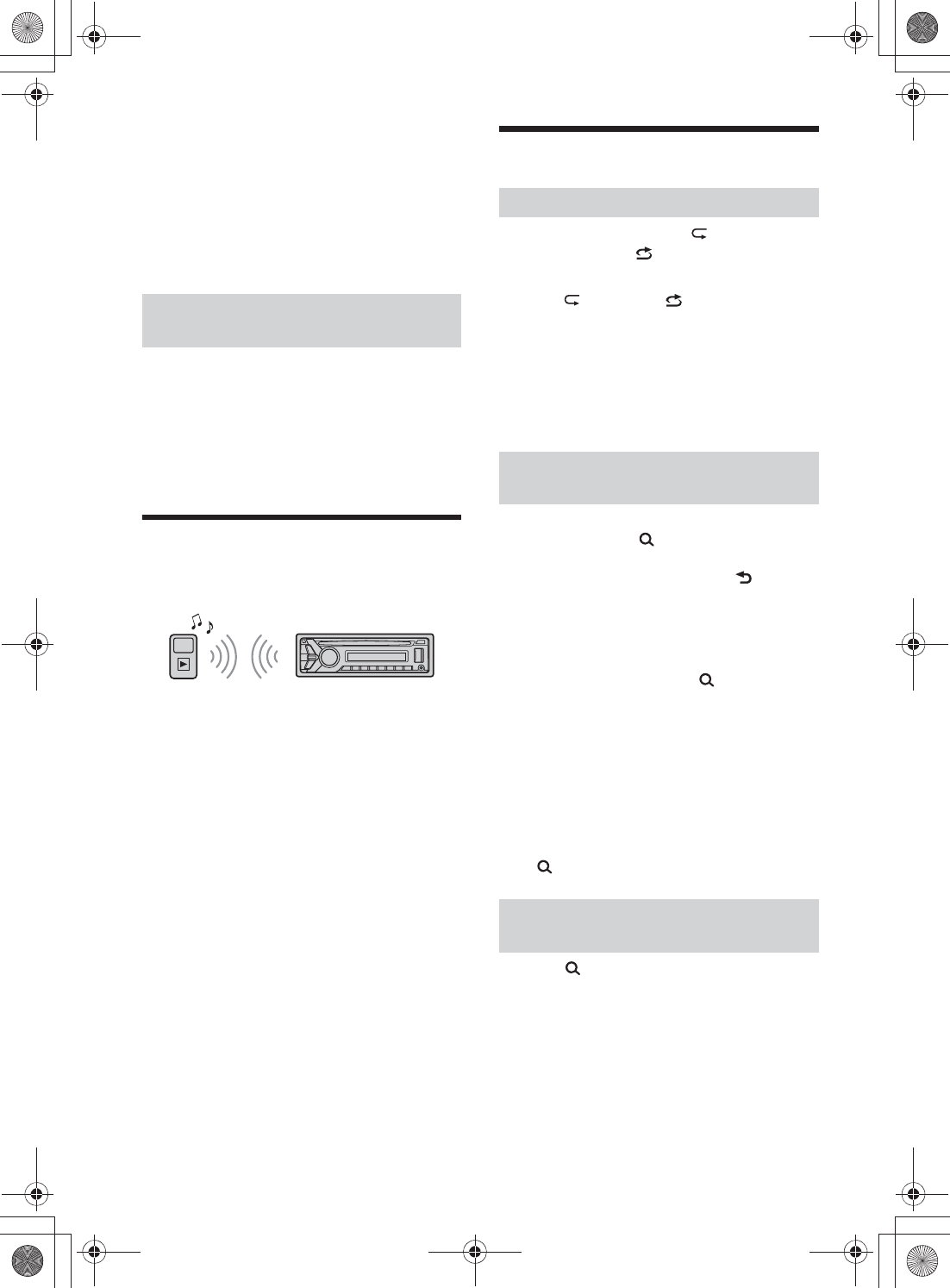
11GB
F:\yoshida\1115\4489688111\4489688111MEXN4000BTUC\01GB-MEXN4000BTUC\040CD.fm masterpage: Right
MEX-N4000BT
4-489-688-11(1)
To remove the device
Stop playback, then remove the device.
Caution for iPhone
When you connect an iPhone via USB, phone call
volume is controlled by the iPhone, not the unit. Do
not inadvertently increase the volume on the unit
during a call, as sudden loud sound may result
when the call ends.
Press and hold MODE during playback until [MODE
IPOD] appears to enable operation by the iPod
directly.
Note that the volume can be adjusted only by the
unit.
To exit passenger control
Press and hold MODE until [MODE AUDIO] appears.
Playing a BLUETOOTH Device
You can play contents on a connected device that
supports BLUETOOTH A2DP (Advanced Audio
Distribution Profile).
1Make BLUETOOTH connection with the
audio device (page 7).
2Press SRC to select [BT AUDIO].
3Operate the audio device to start
playback.
4Adjust the volume on this unit.
Notes
ˎDepending on the audio device, information such as
title, track number/time and playback status may not
be displayed on this unit.
ˎEven if the source is changed on this unit, playback of
the audio device does not stop.
ˎ[BT AUDIO] does not appear in the display while
running the “App Remote” application via the
BLUETOOTH function.
To match the volume level of the BLUETOOTH
device to other sources
Start playback of the BLUETOOTH audio device at a
moderate volume, and set your usual listening
volume on the unit.
Press MENU and rotate the control dial.
Select [SOUND] q [BTA VOL] (page 18).
Searching and Playing Tracks
1During playback, press (repeat) for
Repeat play, or (shuffle) for Shuffle
play.
2Press (repeat) or (shuffle)
repeatedly to select the desired play
mode.
Playback in selected play mode may take time
to start.
Available play modes differ depending on the
selected sound source.
1During CD, USB or BT audio device*1
playback, press (browse)*2 to display
the list of search categories.
When the track list appears, press (back)
repeatedly to display the desired search
category.
*1 Available only for audio devices supporting
AVRCP (Audio Video Remote Control Profile) 1.4
or above.
*2 During USB playback, press (browse) for
more than 2 seconds to directly return to the
beginning of the category list.
2Rotate the control dial to select the
desired search category, then press it to
confirm.
3Repeat step 2 to search the desired track.
Playback starts.
To exit the Quick-BrowZer mode
Press (browse).
1Press (browse).
2Press SEEK +.
3Rotate the control dial to select the item.
The list is jumped in steps of 10% of the total
number of items.
4Press ENTER to return to the Quick-
BrowZer mode.
The selected item appears.
Operating an iPod directly (Passenger
control)
Repeat play and shuffle play
Searching a track by name (Quick-
BrowZer™)
Searching by skipping items
(Jump mode)
010COV.book Page 11 Friday, November 15, 2013 11:49 AM

12GB
F:\yoshida\1115\4489688111\4489688111MEXN4000BTUC\01GB-MEXN4000BTUC\040CD.fm masterpage: Left
MEX-N4000BT
4-489-688-11(1)
5Rotate the control dial to select the
desired item, then press it.
Playback starts.
Pandora® is available to stream music through your
iPhone, Android™ and BlackBerry® phones. You can
control Pandora® on a USB-connected iPhone or
BLUETOOTH connected Android/BlackBerry phone
from this unit.
The Pandora® service is not available in some
countries/regions.
Preparing for Pandora®
1To check for compatible devices, visit the
support site on the back cover.
2Download the latest version of the
Pandora® application from your
smartphone’s app store. A list of
compatible devices can be found at
www.pandora.com/everywhere/mobile
For Android phone only
You cannot control Pandora® via the BLUETOOTH
function while running the “App Remote”
application via BLUETOOTH.
Streaming Pandora®
1Connect this unit with the mobile device.
ˎiPhone via USB (page 8)
ˎAndroid/BlackBerry phone via BLUETOOTH
function (page 7)
2Press SRC to select [PANDORA USB] or
[BT PANDORA].
3Launch Pandora® application on the
mobile device.
4Press PAUSE to start playback.
If the device number appears
Make sure that the same numbers are displayed
(e.g., 123456) in this unit and the mobile device,
then press ENTER on this unit and select [Yes] on
the mobile device.
When activating the BLUETOOTH function
You can adjust the volume level.
Press MENU and rotate the control dial. Select
[SOUND] q [BTA VOL] (page 18).
Listening to Pandora®
010COV.book Page 12 Friday, November 15, 2013 11:49 AM
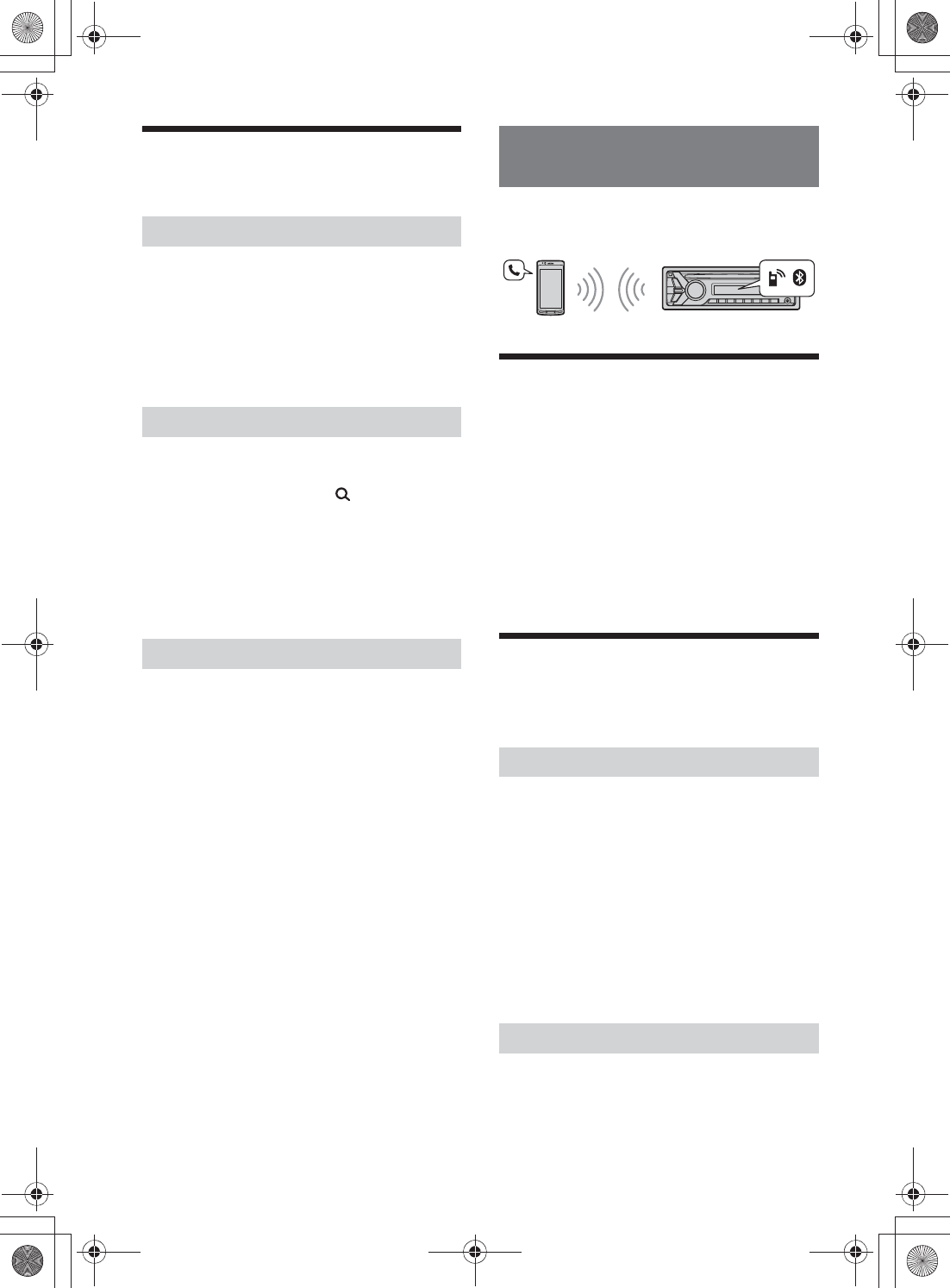
13GB
F:\yoshida\1115\4489688111\4489688111MEXN4000BTUC\01GB-MEXN4000BTUC\040CD.fm masterpage: Right
MEX-N4000BT
4-489-688-11(1)
Available Operations in the
Pandora®
“Thumbs Up” or “Thumbs Down” feedback allows
you to personalize stations.
Thumbs Up
During playback, press Ă.
Thumbs Down
During playback, press è.
The station list allows you to easily select a desired
station.
1During playback, press (browse).
2Press SEEK + to select the sorting order
[BY DATE] or [A TO Z].
3Rotate the control dial to select the
desired station, then press it.
Playback starts.
The track or artist currently being played can be
bookmarked and stored in your Pandora® account.
1During playback, press and hold MODE
until [BOOKMARK] appears.
2Rotate the control dial to select [TRK]
(track) or [ART] (artist), then press it.
To use a cellular phone, connect it with this unit. For
details, see “Preparing a BLUETOOTH Device”
(page 7).
Receiving a Call
1Press CALL when a call is received with a
ringtone.
The phone call starts.
Note
The ringtone and talker’s voice are output only from the
front speakers.
To reject the call
Press and hold OFF for 1 second.
To end the call
Press CALL again.
Making a Call
You can make a call from the phonebook or call
history when a cellular phone supporting PBAP
(Phone Book Access Profile) is connected.
1Press CALL, rotate the control dial to
select [PHONEBOOK], then press it.
2Rotate the control dial to select an initial
from the initial list, then press it.
3Rotate the control dial to select a name
from the name list, then press it.
4Rotate the control dial to select a
number from the number list, then press
it.
The phone call starts.
1Press CALL, rotate the control dial to
select [RECENT CALL], then press it.
A list of the call history appears.
“Thumbs” feedback
Using the station list
Bookmarking
Handsfree Calling
Calling from the phonebook
Calling from the call history
010COV.book Page 13 Friday, November 15, 2013 11:49 AM
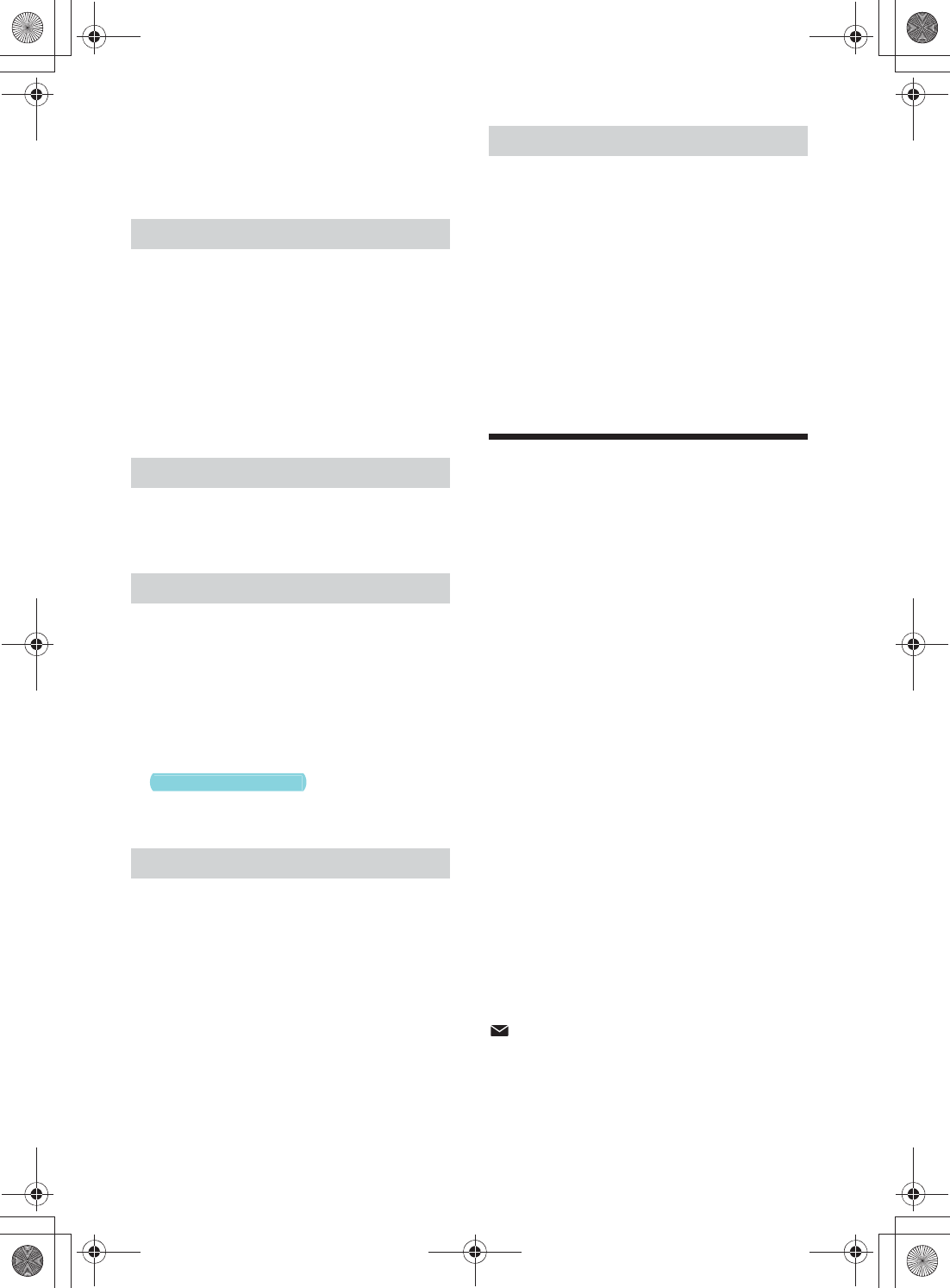
14GB
F:\yoshida\1115\4489688111\4489688111MEXN4000BTUC\01GB-MEXN4000BTUC\040CD.fm masterpage: Left
MEX-N4000BT
4-489-688-11(1)
2Rotate the control dial to select a name
or phone number from the call history,
then press it.
The phone call starts.
1Press CALL, rotate the control dial to
select [DIAL NUMBER], then press it.
2Rotate the control dial to enter the
phone number, and lastly select [ ]
(space), then press ENTER*.
The phone call starts.
* To move the digital indication, press SEEK +/–.
Note
[_] appears instead of [#] on the display.
1Press CALL, rotate the control dial to
select [REDIAL], then press it.
The phone call starts.
You can store up to 6 contacts in the preset dial.
1Select a phone number that you want to
store in the preset dial, from the
phonebook, call history or by inputting
the phone number directly.
The phone number appears in the display of
this unit.
2Press and hold a number button (1 to 6)
until [MEM] appears.
The contact is stored in the selected preset
number.
1Press SRC, rotate the control dial to select
[BT PHONE], then press it.
2Press a number button (1 to 6) to select
the contact you want to call.
3Press ENTER.
The phone call starts.
You can make a call by saying the voice tag stored
in a connected cellular phone that has a voice
dialing function.
1Press CALL, rotate the control dial to
select [VOICE DIAL], then press it.
Alternatively, press ENTER while the App
Remote function is off.
2Say the voice tag stored on the cellular
phone.
Your voice is recognized, and the call is made.
To cancel voice dialing
Press ENTER.
Available Operations during
Call
To preset the volume of the ringtone and
talker’s voice
You can preset the volume level of the ringtone and
talker’s voice.
Adjusting the ringtone volume:
Rotate the control dial while receiving a call.
Adjusting the talker’s voice volume:
Rotate the control dial during a call.
To adjust the volume for the other party (Mic
gain adjustment)
Press MIC.
Adjustable volume levels: [MIC-LOW], [MIC-MID],
[MIC-HI].
To reduce echo and noise (Echo Canceler/
Noise Canceler Mode)
Press and hold MIC.
Settable mode: [EC/NC-1], [EC/NC-2].
To transfer a call
In order to activate/deactivate the appropriate
device (this unit/cellular phone), press MODE or use
your cellular phone.
Note
Depending on the cellular phone, handsfree connection
may be cut off when call transfer is attempted.
To check the status of SMS/email*
flashes when a new SMS/email is received, and
stays lit when there are unread messages.
* Available only for a cellular phone supporting MAP
(Message Access Profile).
Calling by phone number input
Calling by redial
Presetting phone numbers
Calling by preset number
Calling by voice tags
010COV.book Page 14 Friday, November 15, 2013 11:49 AM
until
[
MEM
]
a
pp
ears
.
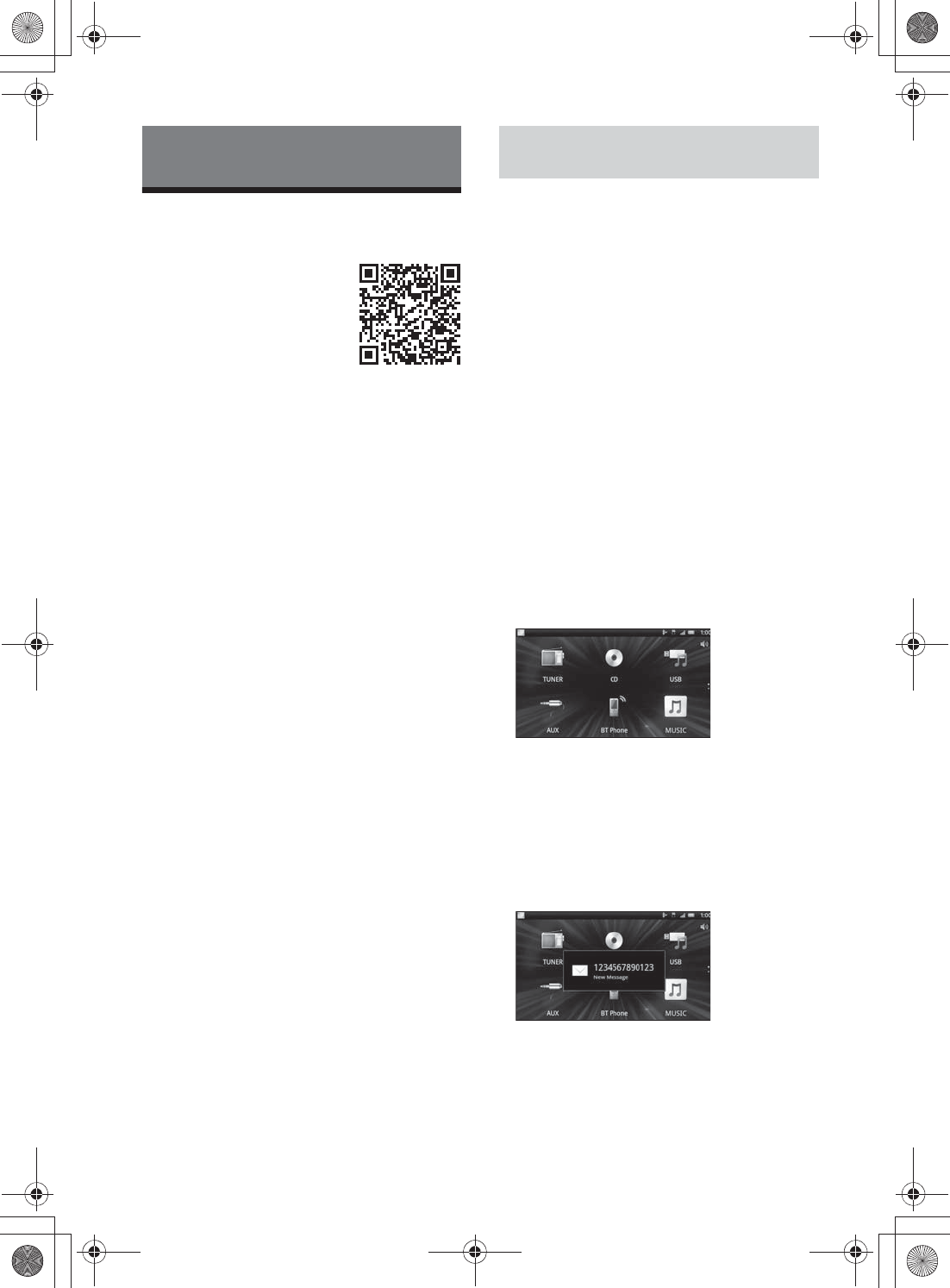
15GB
F:\yoshida\1115\4489688111\4489688111MEXN4000BTUC\01GB-MEXN4000BTUC\040CD.fm masterpage: Right
MEX-N4000BT
4-489-688-11(1)
App Remote with iPhone/
Android Phone
Downloading the “App Remote”
application is required from App
Store for iPhone or from Google
Play for Android phone.
Using the “App Remote”
application, the following
features are available:
ˋOperate the unit to launch and control
compatible applications on iPhone/Android
phone.
ˋOperate iPhone/Android phone with simple
finger gestures to control the source of the unit.
ˋLaunch an application/audio source or search
the keyword on the application by saying a word
or phrase into the microphone (Android phone
only).
ˋRead out incoming text messages, SMS, email,
Twitter, Facebook, Calendar, etc., automatically,
and the text messages, SMS and email can be
replied (Android phone only).
ˋAdjust the sound settings (EQ10, Balance/Fader,
Listening Position) of the unit via iPhone/
Android phone.
Notes
ˎFor your safety, follow your local traffic laws and
regulations, and do not operate the application while
driving.
ˎAvailable operations differ depending on the
applications. For details on available applications,
visit the support site on the back cover.
ˎApp Remote ver. 2.0 via USB is compatible with iOS 5/
iOS 6 installed iPhones.
ˎApp Remote ver. 2.0 via BLUETOOTH is compatible
with Android devices with Android 2.2, 2.3, 3.*, 4.0, 4.1
or 4.2 installed.
ˎVoice recognition function does not work depending
on your smartphone. In that case, go to [Settings] –
select [Voice Recognition].
ˎSMS/E-mail/Notification reading is available for
Android devices with TTS engine installed.
ˎThe “Smart Connect” application, provided by Sony
Mobile Communications, is necessary for Twitter/
Facebook/Calendar, etc., notification read out.
1Connect iPhone to the USB port or
Android phone with the BLUETOOTH
function.
2Launch the “App Remote” application.
3Press and hold APP on the unit for more
than 2 seconds.
Connection to iPhone/Android phone starts.
For details on the operations on iPhone/
Android phone, see the help of the application.
If the device number appears
Make sure that the same numbers are displayed
(e.g., 123456) in this unit and the mobile device,
then press ENTER on this unit and select [Yes] on
the mobile device.
To terminate connection
Press and hold APP.
Selecting the source or application
You can operate the unit to select the desired
source or application on your smartphone.
1Rotate the control dial to select the desired source
or application, then press it.
To select another source or application, press SRC
then rotate the control dial to select the desired
source or application.
Announcement of various information by
voice guide (Android phone only)
When SMS/E-mail, Twitter/Facebook/Calendar
notifications, etc., are received, they are
automatically announced through the car speakers.
For details on settings, refer to the help of the
application.
Useful Functions
Establishing the App Remote
connection
010COV.book Page 15 Friday, November 15, 2013 11:49 AM
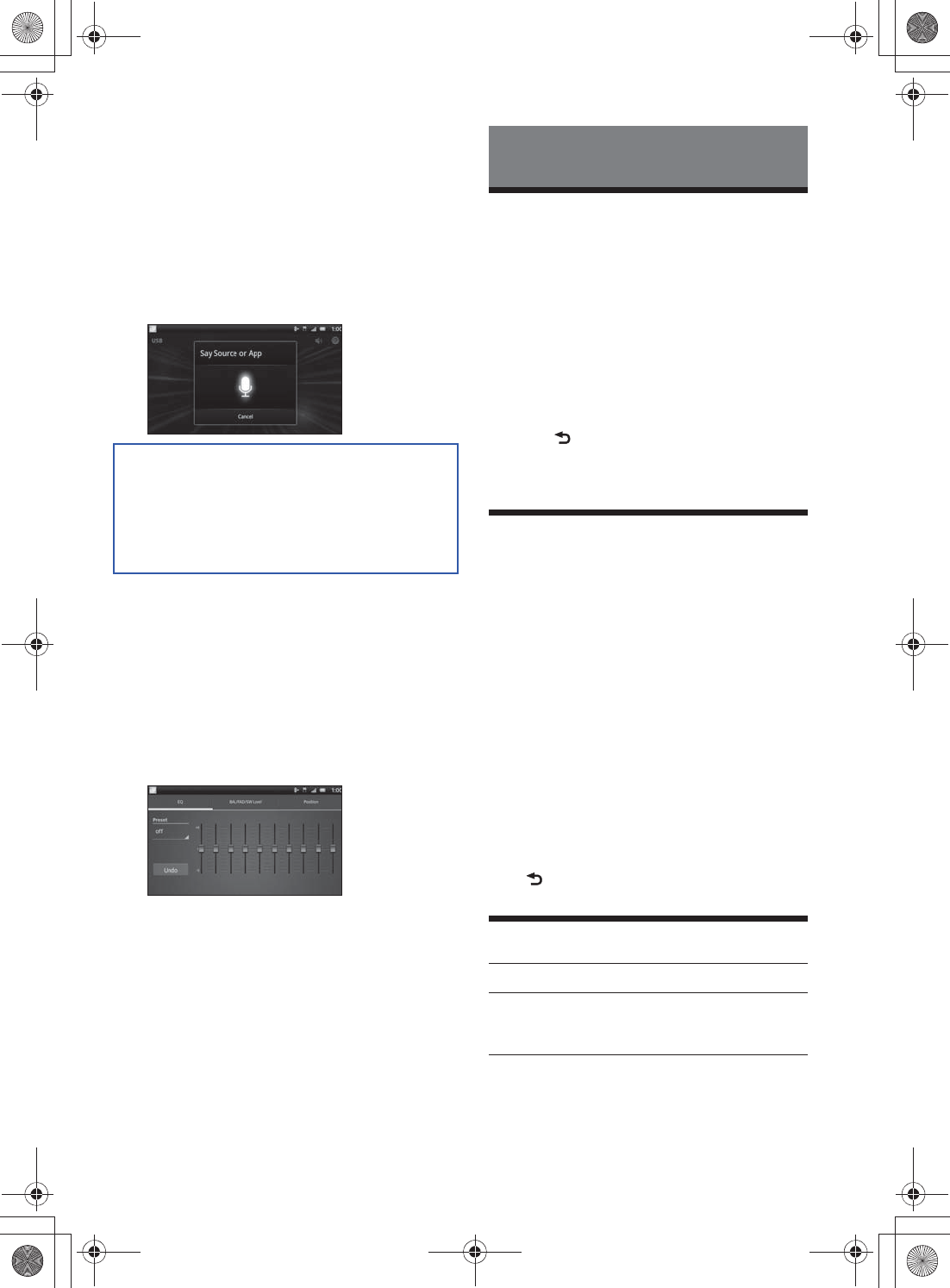
16GB
F:\yoshida\1115\4489688111\4489688111MEXN4000BTUC\01GB-MEXN4000BTUC\040CD.fm masterpage: Left
MEX-N4000BT
4-489-688-11(1)
Activating voice recognition (Android
phone only)
By registering applications, you can control an
application by voice command. For details, refer to
the help of the application.
To activate voice recognition
1Press ENTER to activate voice recognition.
2Say the desired voice command into the
microphone when [Say Source or App] appears on
the Android phone.
Notes
ˎVoice recognition may not be available in some cases.
ˎVoice recognition may not work properly depending
on the performance of the connected Android phone.
ˎOperate under conditions where noise such as engine
sound is minimized during voice recognition.
ˎUsing an external microphone (not supplied) will
improve voice recognition.
When a music or video application is
selected*
Press 1 or 2 to enter HID mode, and press SEEK +/–
to select a playback item, then press ENTER to start
playback.
* Available only for an Android phone supporting
HID (Human Interface Device Profile).
Making sound settings
You can adjust the settings for EQ, BAL/FAD/SW
Level and Position via your smartphone.
For details on settings, refer to the help of the
application.
Canceling the DEMO Mode
You can cancel the demonstration display which
appears while this unit is turned off.
1Press MENU, rotate the control dial to
select [DISPLAY], then press it.
2Rotate the control dial to select [DEMO],
then press it.
3Rotate the control dial to select [DEMO-
OFF], then press it.
The setting is complete.
4Press (back) twice.
The display returns to normal reception/play
mode.
Basic Setting Operation
You can set items in the menu to the following
procedure.
The following items can be set depending on the
source and setting.
1Press MENU.
2Rotate the control dial to select the setup
category, then press it.
Setup categories are follows:
ˎGENERAL setup (page 16)
ˎSOUND setup (page 17)
ˎDISPLAY setup (page 18)
ˎBT (BLUETOOTH) setup (page 18)
ˎAPP REM (App Remote) setup (page 19)
3Rotate the control dial to select the
options, then press it.
To return to the previous display
Press (back).
GENERAL Setup
CLOCK-ADJ (clock adjust) (page 6)
CAUT ALM (caution alarm) (page 6)
Activates the caution alarm: [ON], [OFF].
(Available only when the unit is turned off.)
BEEP
Activates the beep sound: [ON], [OFF].
Settings
010COV.book Page 16 Friday, November 15, 2013 11:49 AM
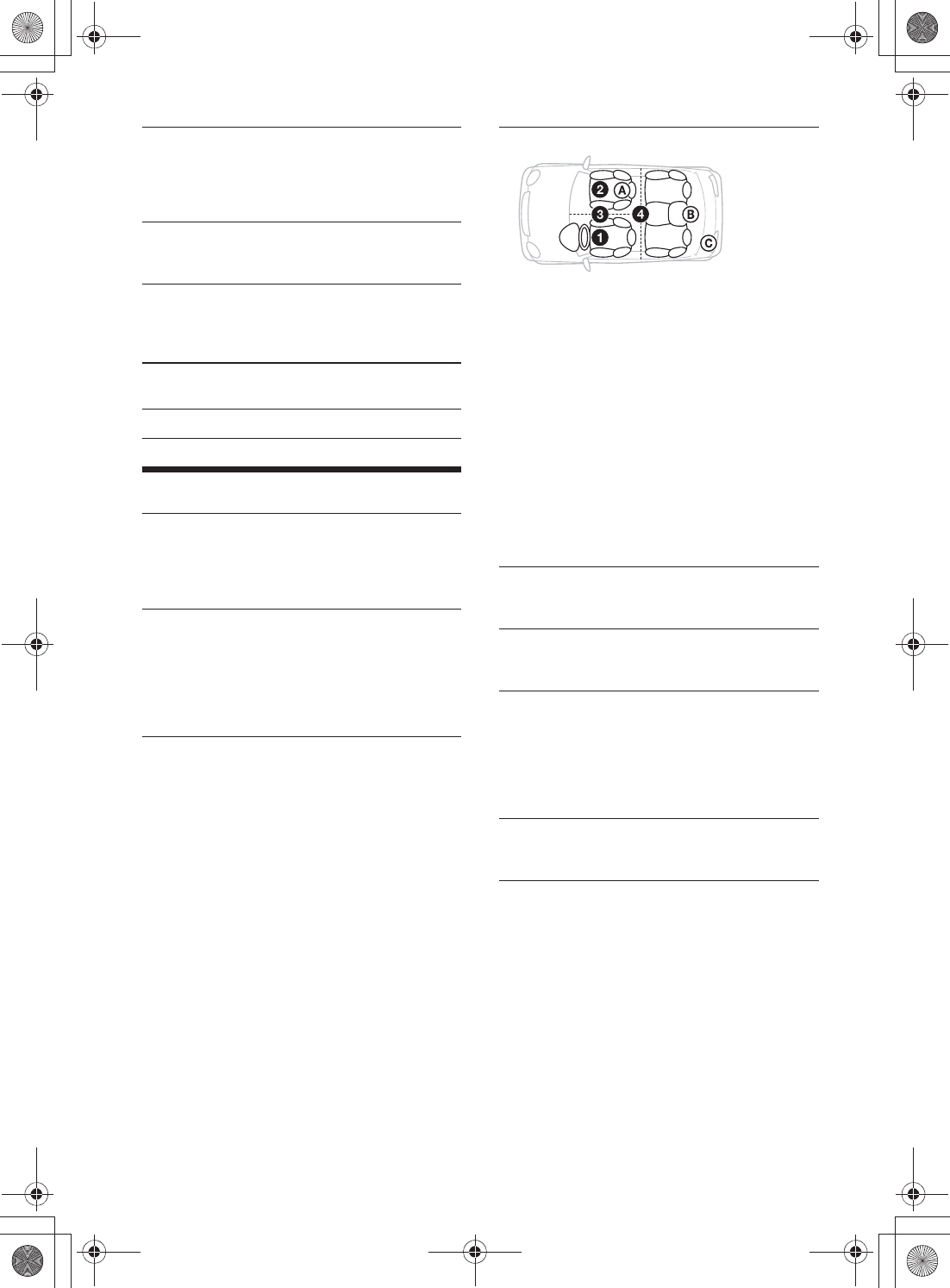
17GB
F:\yoshida\1115\4489688111\4489688111MEXN4000BTUC\01GB-MEXN4000BTUC\040CD.fm masterpage: Right
MEX-N4000BT
4-489-688-11(1)
AUTO OFF
Shuts off automatically after a desired time
when the unit is turned off: [NO], [30S] (30
seconds), [30M] (30 minutes), [60M] (60
minutes).
AUX-A (AUX audio)
Activates the AUX source display: [ON], [OFF].
(Available only when the unit is turned off.)
REAR/SUB
Switches the audio output: [SUB-OUT]
(subwoofer), [REAR-OUT] (power amplifier).
(Available only when the unit is turned off.)
CT (clock time) (page 10)
Activates the CT function: [ON], [OFF].
BTM (page 9)
SOUND Setup
C.AUDIO+ (clear audio+)
Reproduces sound by optimizing the digital
signal with the Sony recommended sound
settings: [ON], [OFF]. (Automatically sets to [OFF]
when [EQ10 PRESET] is changed).
EQ10 PRESET
Selects an equalizer curve from 10 equalizer
curves or off: [R AND B], [ROCK], [POP], [DANCE],
[HIP-HOP], [ELECTRONICA], [JAZZ], [SOUL],
[COUNTRY], [CUSTOM], [OFF].
The equalizer curve setting can be memorized
for each source.
EQ10 SETTING
Sets [CUSTOM] of EQ10.
BASE
Selects a preset equalizer curve as a basis for
further customizing: [BAND1] 32 Hz, [BAND2] 63
Hz, [BAND3] 125 Hz, [BAND4] 250 Hz, [BAND5]
500 Hz, [BAND6] 1 kHz, [BAND7] 2 kHz, [BAND8]
4 kHz, [BAND9] 8 kHz, [BAND10] 16 kHz.
The volume level is adjustable in 1 dB steps,
from -6 dB to +6 dB.
POSITION (listening position)
SET F/R POS (set front/rear position)
Simulates a natural sound field by delaying the
sound output from front/rear speaker to suit
your position.
FRONT L (ɞ): Front left
FRONT R (ɟ): Front right
FRONT (ɠ): Center front
ALL (ɡ): In the center of your car
CUSTOM: Position set by App Remote
OFF: No position set
ADJ POSITION* (adjust position)
Fine-tunes the listening position setting.
Adjustable range: [+3] – [CENTER] – [-3].
SET SW POS* (set subwoofer position)
NEAR (ʭ): Near
NORMAL (ʮ): Normal
FAR (ʯ): Far
BALANCE
Adjusts the sound balance: [RIGHT-15] –
[CENTER] – [LEFT-15].
FADER
Adjusts the relative level: [FRONT-15] – [CENTER]
– [REAR-15].
DSEE (digital sound enhancement engine)
Improves digitally compressed sound by
restoring high frequencies lost in the
compression process.
This setting can be memorized for each source
other than the tuner.
Selects the DSEE mode: [ON], [OFF].
LOUDNESS
Reinforces bass and treble for clear sound at low
volume levels: [ON], [OFF].
AAV (advanced auto volume)
Adjust the playback volume level of all playback
sources to the optimum level: [ON], [OFF].
010COV.book Page 17 Friday, November 15, 2013 11:49 AM
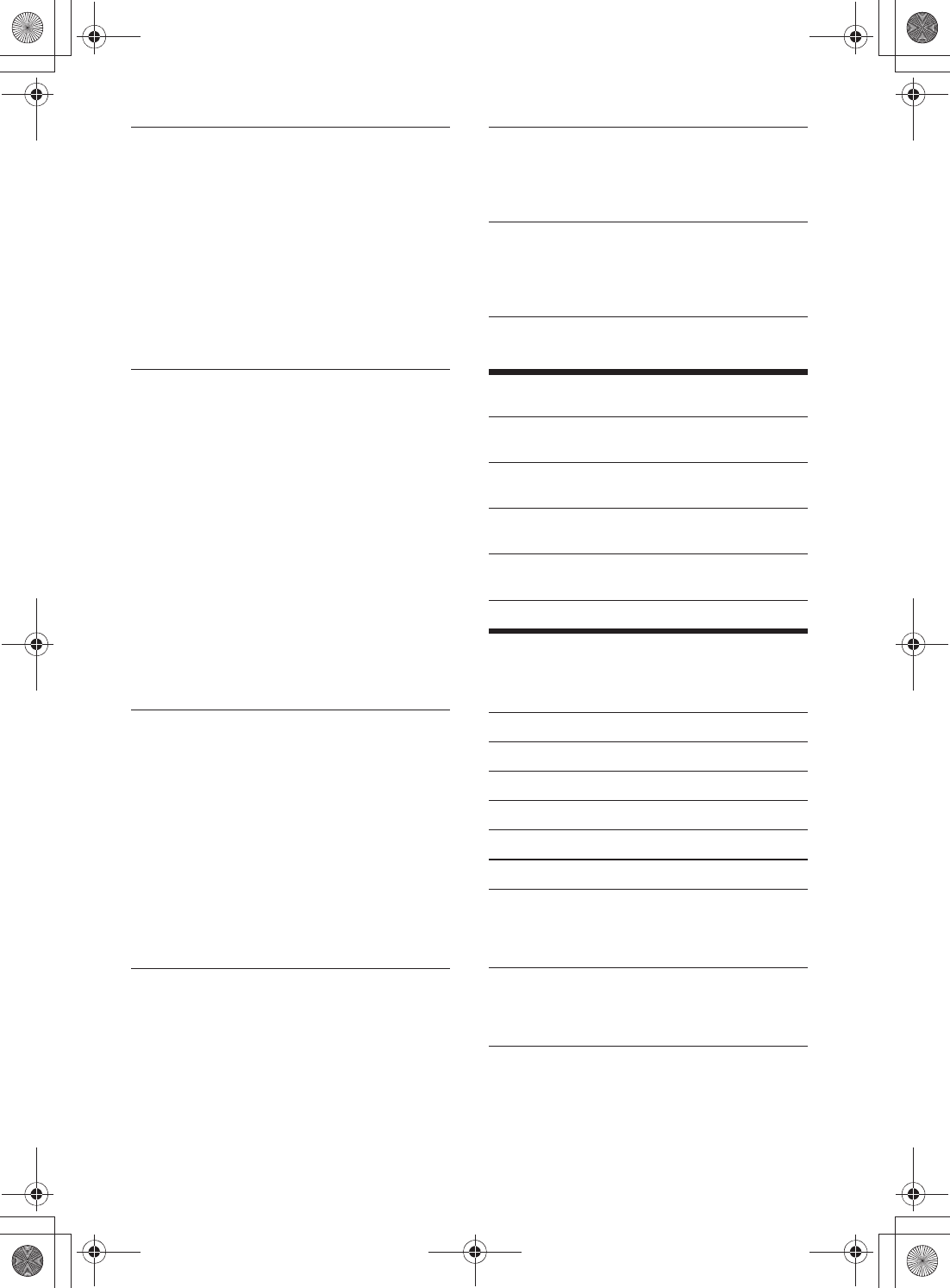
18GB
F:\yoshida\1115\4489688111\4489688111MEXN4000BTUC\01GB-MEXN4000BTUC\040CD.fm masterpage: Left
MEX-N4000BT
4-489-688-11(1)
RB ENH (rear bass enhancer)
Rear Bass Enhancer enhances the bass sound by
applying a low pass filter setting to the rear
speakers. This function allows the rear speakers
to work as a subwoofer if one is not connected.
(Available only when [SW DIREC] is set to [OFF].)
RBE MODE (rear bass enhancer mode)
Selects the rear bass enhancer mode: [1], [2], [3],
[OFF].
LPF FREQ (low pass filter frequency)
Selects the subwoofer cut-off frequency: [50Hz],
[60Hz], [80Hz], [100Hz], [120Hz].
LPF SLOP (low pass filter slope)
Selects the LPF slope: [1], [2], [3].
SW DIREC (subwoofer direct connection)
You can use the subwoofer without a power
amplifier when it is connected to the rear
speaker cord. (Available only when [RBE MODE]
is set to [OFF].)
Be sure to connect a 4 - 8 ohm subwoofer to
either of the rear speaker cords. Do not connect
a speaker to the other rear speaker cord.
SW MODE (subwoofer mode)
Selects the subwoofer mode: [1], [2], [3], [OFF].
SW PHASE (subwoofer phase)
Selects the subwoofer phase: [NORM], [REV].
SW POS* (subwoofer position)
Selects the subwoofer position: [NEAR],
[NORMAL], [FAR].
LPF FREQ (low pass filter frequency)
Selects the subwoofer cut-off frequency: [50Hz],
[60Hz], [80Hz], [100Hz], [120Hz].
LPF SLOP (low pass filter slope)
Selects the LPF slope: [1], [2], [3].
S.WOOFER (subwoofer)
SW LEVEL (subwoofer level)
Adjusts the subwoofer volume level:
[+10 dB] – [0 dB] – [-10 dB].
([ATT] is displayed at the lowest setting.)
SW PHASE (subwoofer phase)
Selects the subwoofer phase: [NORM], [REV].
SW POS* (subwoofer position)
Selects the subwoofer position: [NEAR],
[NORMAL], [FAR].
LPF FREQ (low pass filter frequency)
Selects the subwoofer cut-off frequency: [50Hz],
[60Hz], [80Hz], [100Hz], [120Hz].
LPF SLOP (low pass filter slope)
Selects the LPF slope: [1], [2], [3].
HPF (high pass filter)
HPF FREQ (high pass filter frequency)
Selects the front/rear speaker cut-off frequency:
[OFF], [50Hz], [60Hz], [80Hz], [100Hz], [120Hz].
HPF SLOP (high pass filter slope)
Selects the HPF slope (effective only when [HPF
FREQ] is set to other than [OFF]): [1], [2], [3].
AUX VOL (AUX volume level)
Adjusts the volume level for each connected
auxiliary device: [+18 dB] – [0 dB] – [-8 dB].
This setting negates the need to adjust the
volume level between sources.
BTA VOL (BLUETOOTH audio volume level)
Adjusts the volume level for each connected
BLUETOOTH device: [+6 dB] – [0 dB] – [-6 dB].
This setting negates the need to adjust the
volume level between sources.
* Does not appear when [SET F/R POS] is set to [OFF].
DISPLAY Setup
DEMO (demonstration)
Activates the demonstration: [ON], [OFF].
DIMMER
Changes the display brightness [ON], [OFF].
ILLUM (Illumination)
Changes the illumination color: [1], [2].
AUTO SCR (auto scroll)
Scrolls long items automatically: [ON], [OFF].
BT (BLUETOOTH) Setup
This setup menu can be also opened by pressing
CALL.
PAIRING (page 7)
PHONEBOOK (page 13)
REDIAL (page 14)
RECENT CALL (page 13)
VOICE DIAL (page 14)
DIAL NUMBER (page 14)
RINGTONE
Selects whether this unit or the connected
cellular phone outputs the ringtone: [1] (this
unit), [2] (cellular phone).
AUTO ANS (auto answer)
Sets this unit to answer an incoming call
automatically: [OFF], [1] (about 3 seconds), [2]
(about 10 seconds).
AUTO PAIRING
Start BLUETOOTH pairing automatically when
iOS device version 5.0 or later is connected via
USB: [ON], [OFF].
010COV.book Page 18 Friday, November 15, 2013 11:49 AM
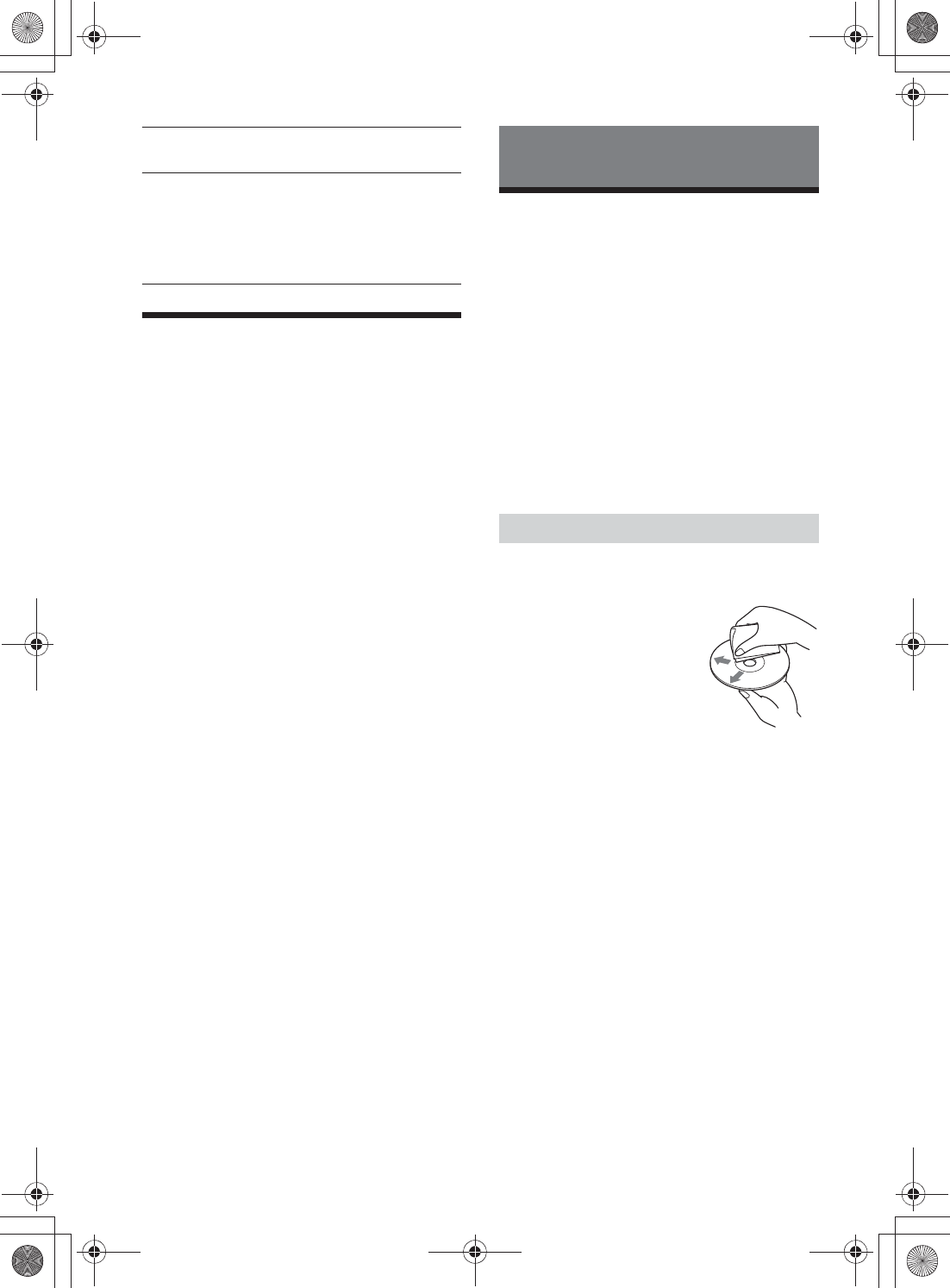
19GB
F:\yoshida\1115\4489688111\4489688111MEXN4000BTUC\01GB-MEXN4000BTUC\040CD.fm masterpage: Right
MEX-N4000BT
4-489-688-11(1)
BT SIGNL (BLUETOOTH signal) (page 7)
Activates the BLUETOOTH function: [ON], [OFF].
BT INIT (BLUETOOTH initialize)
Initializes all the BLUETOOTH related settings
(pairing information, preset number, device
information, etc.).
When disposing the unit, initialize all the
settings.
APP REM (App Remote) Setup
Establish and terminate App Remote function
(connection).
Precautions
ˎCool off the unit beforehand if your car has been
parked in direct sunlight.
ˎDo not leave the front panel or audio devices
brought in inside the car, or it may cause
malfunction due to high temperature in direct
sunlight.
ˎPower antenna (aerial) extends automatically.
Moisture condensation
Should moisture condensation occur inside the
unit, remove the disc and wait for about an hour for
it to dry out; otherwise the unit will not operate
properly.
To maintain high sound quality
Do not splash liquid onto the unit or discs.
ˎDo not expose discs to direct sunlight or heat
sources such as hot air ducts, nor leave it in a car
parked in direct sunlight.
ˎBefore playing, wipe the discs
with a cleaning cloth from the
center out. Do not use
solvents such as benzine,
thinner, commercially
available cleaners.
ˎThis unit is designed to play
back discs that conform to the
Compact Disc (CD) standard.
DualDiscs and some of the music discs encoded
with copyright protection technologies do not
conform to the Compact Disc (CD) standard,
therefore, these discs may not be playable by this
unit.
ˎDiscs that this unit CANNOT play
ˋDiscs with labels, stickers, or sticky tape or
paper attached. Doing so may cause a
malfunction, or may ruin the disc.
ˋDiscs with non-standard shapes (e.g., heart,
square, star). Attempting to do so may damage
the unit.
ˋ8 cm (3 1/4 in) discs.
Notes on CD-R/CD-RW discs
ˎThe maximum number of: (CD-R/CD-RW only)
ˋfolders (albums): 150 (including root folder)
ˋfiles (tracks) and folders: 300 (may less than
300 if folder/file names contain many
characters)
ˋdisplayable characters for a folder/file name: 32
(Joliet)/64 (Romeo)
Additional Information
Notes on discs
010COV.book Page 19 Friday, November 15, 2013 11:49 AM
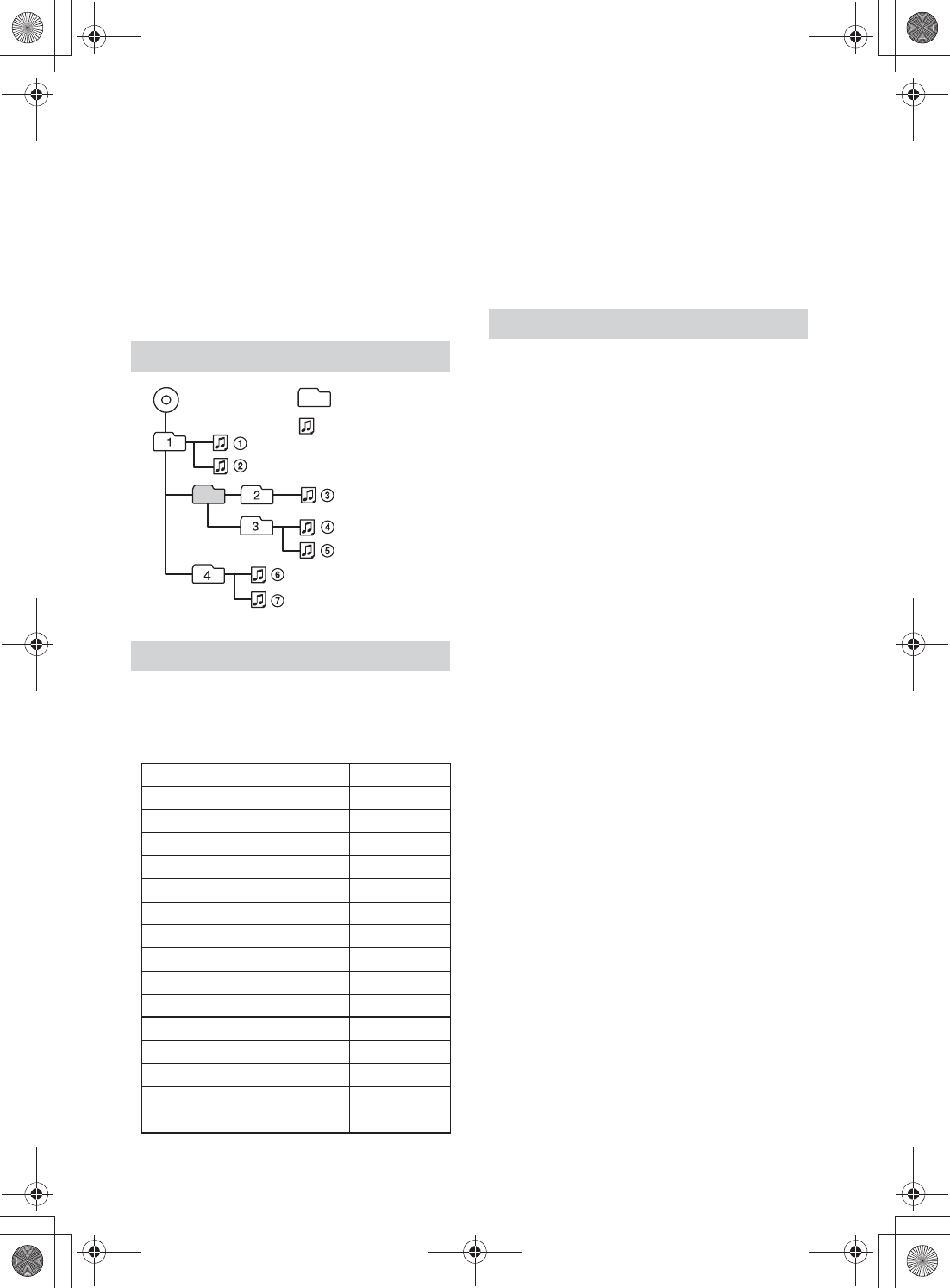
20GB
F:\yoshida\1115\4489688111\4489688111MEXN4000BTUC\01GB-MEXN4000BTUC\040CD.fm masterpage: Left
MEX-N4000BT
4-489-688-11(1)
ˎIf the multi-session disc begins with a CD-DA
session, it is recognized as a CD-DA disc, and
other sessions are not played back.
ˎDiscs that this unit CANNOT play
ˋCD-R/CD-RW of poor recording quality.
ˋCD-R/CD-RW recorded with an incompatible
recording device.
ˋCD-R/CD-RW which is finalized incorrectly.
ˋCD-R/CD-RW other than those recorded in
music CD format or MP3 format conforming to
ISO9660 Level 1/Level 2, Joliet/Romeo or multi-
session.
ˎYou can connect to the following iPod models.
Update your iPod devices to the latest software
before use.
Compatible iPhone/iPod models
ˎ“Made for iPod” and “Made for iPhone” mean that
an electronic accessory has been designed to
connect specifically to iPod or iPhone,
respectively, and has been certified by the
developer to meet Apple performance standards.
Apple is not responsible for the operation of this
device or its compliance with safety and
regulatory standards. Please note that the use of
this accessory with iPod or iPhone may affect
wireless performance.
What is BLUETOOTH technology?
ˎBLUETOOTH wireless technology is a short-range
wireless technology that enables wireless data
communication between digital devices, such as
a cellular phone and a headset. BLUETOOTH
wireless technology operates within a range of
about 10 m (33 ft). Connecting two devices is
common, but some devices can be connected to
multiple devices at the same time.
ˎYou do not need to use a cable for connection
since BLUETOOTH technology is a wireless
technology, neither is it necessary for the devices
to face one another, such is the case with infrared
technology. For example, you can use such a
device in a bag or pocket.
ˎBLUETOOTH technology is an international
standard supported by millions of companies all
over the world, and employed by various
companies worldwide.
On BLUETOOTH communication
ˎBLUETOOTH wireless technology operates within
a range of about 10 m (33 ft).
Maximum communication range may vary
depending on obstacles (person, metal, wall, etc.)
or electromagnetic environment.
ˎThe following conditions may affect the sensitivity
of BLUETOOTH communication.
ˋThere is an obstacle such as a person, metal, or
wall between this unit and BLUETOOTH device.
ˋA device using 2.4 GHz frequency, such as a
wireless LAN device, cordless telephone, or
microwave oven, is in use near this unit.
ˎBecause BLUETOOTH devices and wireless LAN
(IEEE802.11b/g) use the same frequency,
microwave interference may occur and result in
communication speed deterioration, noise, or
invalid connection if this unit is used near a
wireless LAN device. In such as case, perform the
following.
ˋUse this unit at least 10 m (33 ft) away from the
wireless LAN device.
ˋIf this unit is used within 10 m (33 ft) of a
wireless LAN device, turn off the wireless LAN
device.
ˋInstall this unit and BLUETOOTH device as near
to each other as possible.
Playback order of MP3/WMA files
About iPod
Compatible Model USB
iPhone 5 í
iPhone 4S í
iPhone 4 í
iPhone 3GS í
iPhone 3G í
iPod touch (5th generation) í
iPod touch (4th generation) í
iPod touch (3rd generation) í
iPod touch (2nd generation) í
iPod classic í
iPod nano (7th generation) í
iPod nano (6th generation) í
iPod nano (5th generation) í
iPod nano (4th generation) í
iPod nano (3rd generation) í
MP3/WMA Folder (album)
MP3/WMA file (track)
About BLUETOOTH function
010COV.book Page 20 Friday, November 15, 2013 11:49 AM
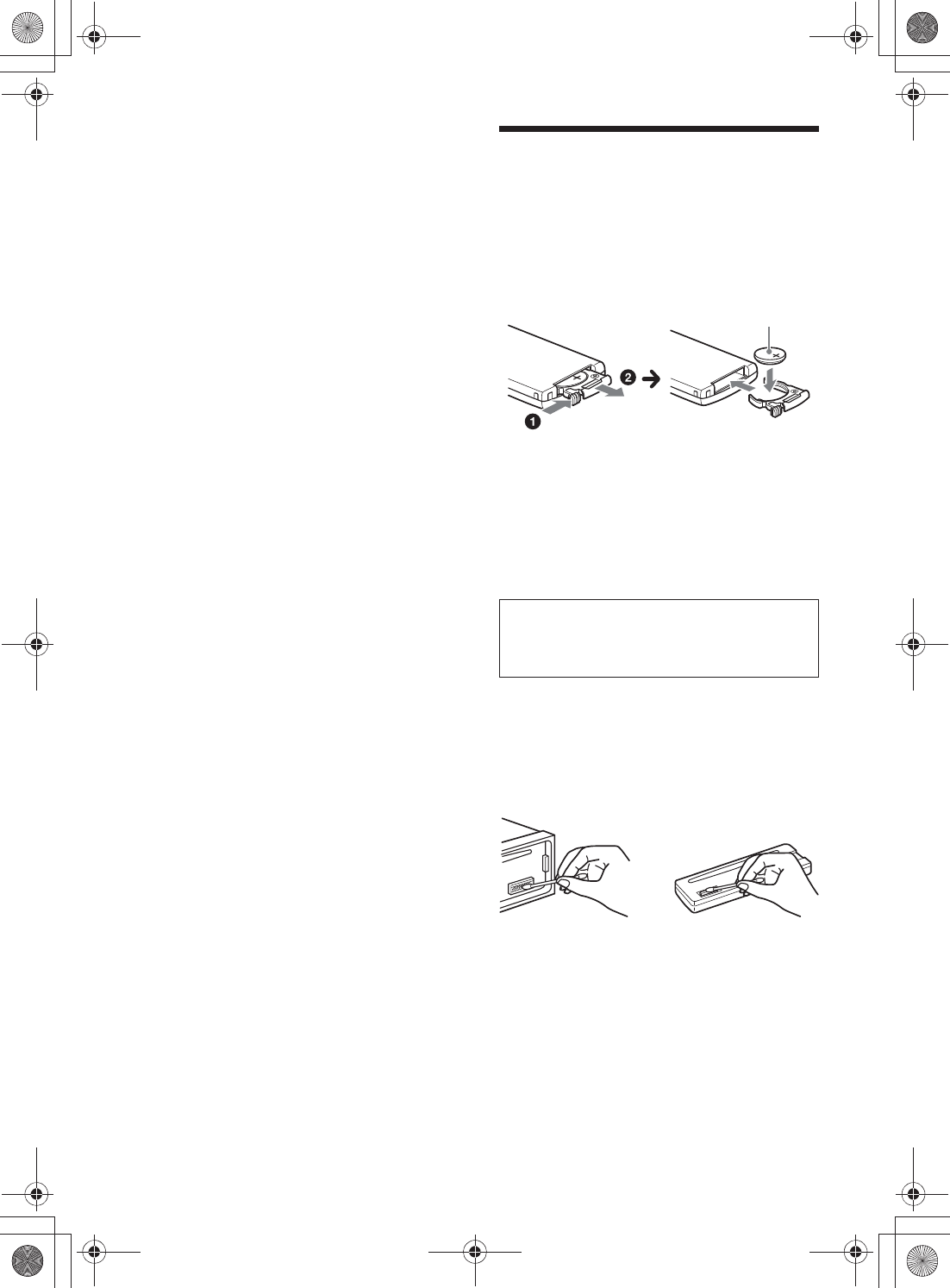
21GB
F:\yoshida\1115\4489688111\4489688111MEXN4000BTUC\01GB-MEXN4000BTUC\040CD.fm masterpage: Right
MEX-N4000BT
4-489-688-11(1)
ˎMicrowaves emitting from a BLUETOOTH device
may affect the operation of electronic medical
devices. Turn off this unit and other BLUETOOTH
devices in the following locations, as it may cause
an accident.
ˋwhere inflammable gas is present, in a hospital,
train, airplane, or petrol station
ˋnear automatic doors or a fire alarm
ˎThis unit supports security capabilities that
comply with the BLUETOOTH standard to provide
a secure connection when the BLUETOOTH
wireless technology is used, but security may not
be enough depending on the setting. Be careful
when communicating using BLUETOOTH wireless
technology.
ˎWe do not take any responsibility for the leakage
of information during BLUETOOTH
communication.
ˎConnection with all BLUETOOTH devices cannot
be guaranteed.
ˋA device featuring BLUETOOTH function is
required to conform to the BLUETOOTH
standard specified by BLUETOOTH SIG, and be
authenticated.
ˋEven if the connected device conforms to the
above mentioned BLUETOOTH standard, some
devices may not be connected or work
correctly, depending on the features or
specifications of the device.
ˋWhile talking on the phone hands free, noise
may occur, depending on the device or
communication environment.
ˎDepending on the device to be connected, it may
require some time to start communication.
Others
ˎUsing the BLUETOOTH device may not function on
cellular phones, depending on radio wave
conditions and location where the equipment is
being used.
ˎIf you experience discomfort after using the
BLUETOOTH device, stop using the BLUETOOTH
device immediately. Should any problem persist,
consult your nearest Sony dealer.
If you have any questions or problems concerning
your unit that are not covered in this manual,
consult your nearest Sony dealer.
Maintenance
Replacing the lithium battery of the remote
commander
When the battery becomes weak, the range of the
remote commander becomes shorter. Replace the
battery with a new CR2025 lithium battery. Use of
any other battery may present a risk of fire or
explosion.
Notes on the lithium battery
ˎKeep the lithium battery out of the reach of children.
Should the battery be swallowed, immediately
consult a doctor.
ˎWipe the battery with a dry cloth to assure a good
contact.
ˎBe sure to observe the correct polarity when installing
the battery.
ˎDo not hold the battery with metallic tweezers,
otherwise a short-circuit may occur.
Cleaning the connectors
The unit may not function properly if the
connectors between the unit and the front panel
are not clean. In order to prevent this, detach the
front panel (page 6) and clean the connectors with
a cotton swab. Do not apply too much force.
Otherwise, the connectors may be damaged.
Notes
ˎFor safety, turn off the ignition before cleaning the
connectors, and remove the key from the ignition
switch.
ˎNever touch the connectors directly with your fingers
or with any metal device.
WARNING
Battery may explode if mistreated.
Do not recharge, disassemble, or dispose of in
fire.
+ side up
010COV.book Page 21 Friday, November 15, 2013 11:49 AM
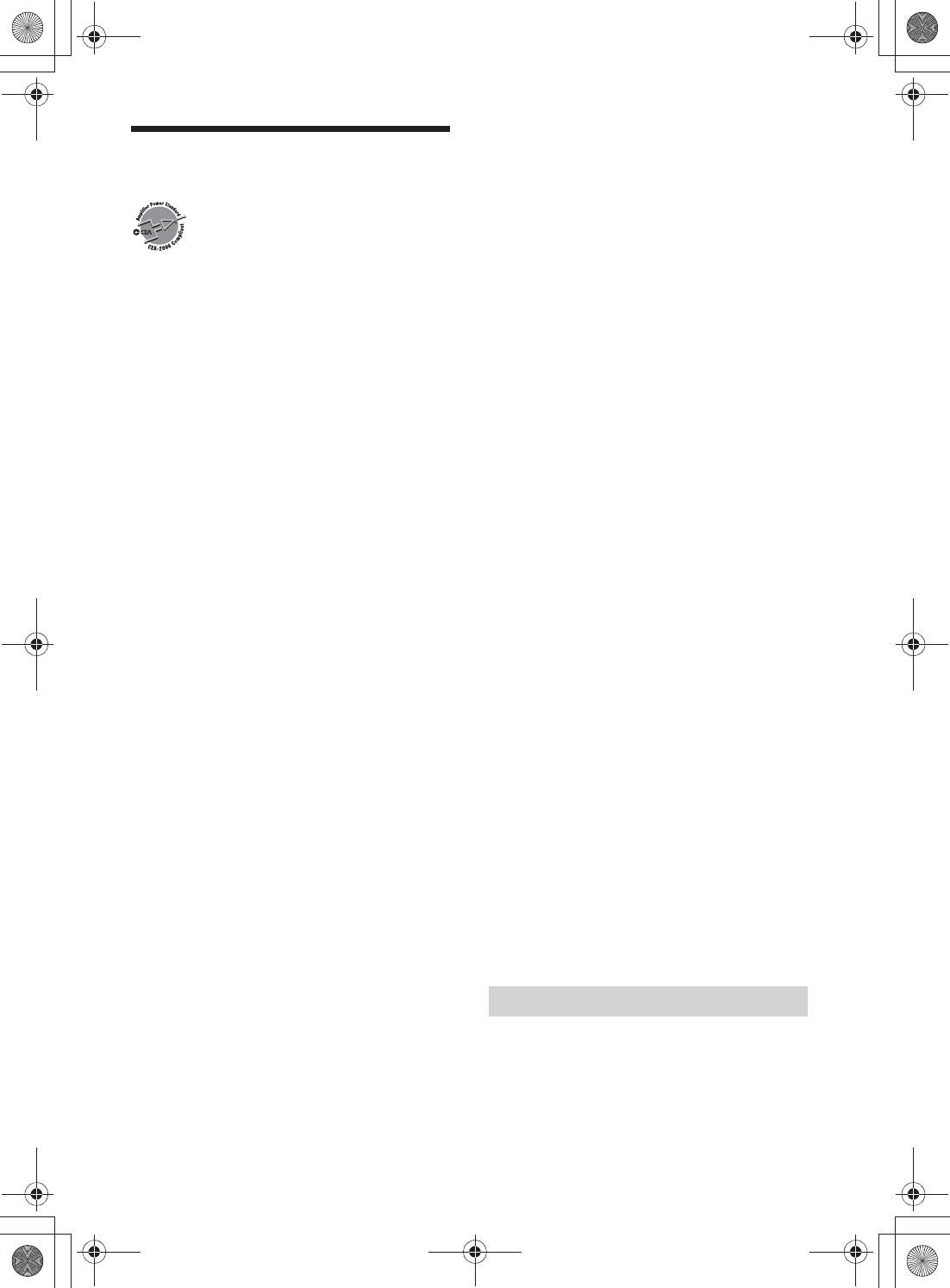
22GB
F:\yoshida\1115\4489688111\4489688111MEXN4000BTUC\01GB-MEXN4000BTUC\040CD.fm masterpage: Left
MEX-N4000BT
4-489-688-11(1)
Specifications
AUDIO POWER SPECIFICATIONS
CEA2006 Standard
Power Output: 17 Watts RMS × 4 at 4
Ohms < 1% THD+N
SN Ratio: 80 dBA
(reference: 1 Watt into 4 Ohms)
Tuner section
FM
Tuning range: 87.5 – 107.9 MHz
Antenna (aerial) terminal:
External antenna (aerial) connector
Intermediate frequency: 25 kHz
Usable sensitivity: 8 dBf
Selectivity: 75 dB at 400 kHz
Signal-to-noise ratio: 80 dB (stereo)
Separation: 50 dB at 1 kHz
Frequency response: 20 – 15,000 Hz
AM
Tuning range: 530 – 1,710 kHz
Antenna (aerial) terminal:
External antenna (aerial) connector
Intermediate frequency:
9,115 kHz or 9,125 kHz/5 kHz
Sensitivity: 26 μV
CD Player section
Signal-to-noise ratio: 120 dB
Frequency response: 10 – 20,000 Hz
Wow and flutter: Below measurable limit
Corresponding codec: MP3 (.mp3) and WMA (.wma)
USB Player section
Interface: USB (High-speed)
Maximum current: 1 A
The maximum number of recognizable tracks:
10,000
Corresponding codec:
MP3 (.mp3), WMA (.wma) and WAV (.wav)
Wireless Communication
Communication System:
BLUETOOTH Standard version 3.1
Output:
BLUETOOTH Standard Power Class 2
(Max. +4 dBm)
Maximum communication range:
Line of sight approx. 10 m (33 ft)*1
Frequency band:
2.4 GHz band (2.4000 – 2.4835 GHz)
Modulation method: FHSS
Compatible BLUETOOTH Profiles*2:
A2DP (Advanced Audio Distribution Profile) 1.3
AVRCP (Audio Video Remote Control Profile) 1.5
HFP (Handsfree Profile) 1.6
PBAP (Phone Book Access Profile)
SPP (Serial Port Profile)
MAP (Message Access Profile)
HID (Human Interface Device Profile)
*1 The actual range will vary depending on factors such
as obstacles between devices, magnetic fields
around a microwave oven, static electricity,
reception sensitivity, antenna (aerial)’s performance,
operating system, software application, etc.
*2 BLUETOOTH standard profiles indicate the purpose
of BLUETOOTH communication between devices.
Power amplifier section
Output: Speaker outputs
Speaker impedance: 4 – 8 ohms
Maximum power output: 55 W × 4 (at 4 ohms)
General
Outputs:
Audio outputs terminal (front, rear/sub
switchable)
Power antenna (aerial)/Power amplifier control
terminal (REM OUT)
Inputs:
Remote controller input terminal
Antenna (aerial) input terminal
MIC input terminal
AUX input jack (stereo mini jack)
USB port
Power requirements: 12 V DC car battery (negative
ground (earth))
Dimensions:
Approx. 178 mm × 50 mm × 177 mm
(7 1/8 in × 2 in × 7 in) (w/h/d)
Mounting dimensions:
Approx. 182 mm × 53 mm × 160 mm
(7 1/4 in × 2 1/8 in × 6 5/16 in) (w/h/d)
Mass: Approx. 1.2 kg (2 lb 11 oz)
Package contents:
Main unit (1)
Remote commander (1): RM-X231
Parts for installation and connections (1 set)
Optional accessories/equipment:
Microphone: XA-MC10
Your dealer may not handle some of the above
listed accessories. Please ask the dealer for detailed
information.
Design and specifications are subject to change
without notice.
The Bluetooth® word mark and logos are registered
trademarks owned by Bluetooth SIG, Inc. and any
use of such marks by Sony Corporation is under
license. Other trademarks and trade names are
those of their respective owners.
Copyrights
010COV.book Page 22 Friday, November 15, 2013 11:49 AM
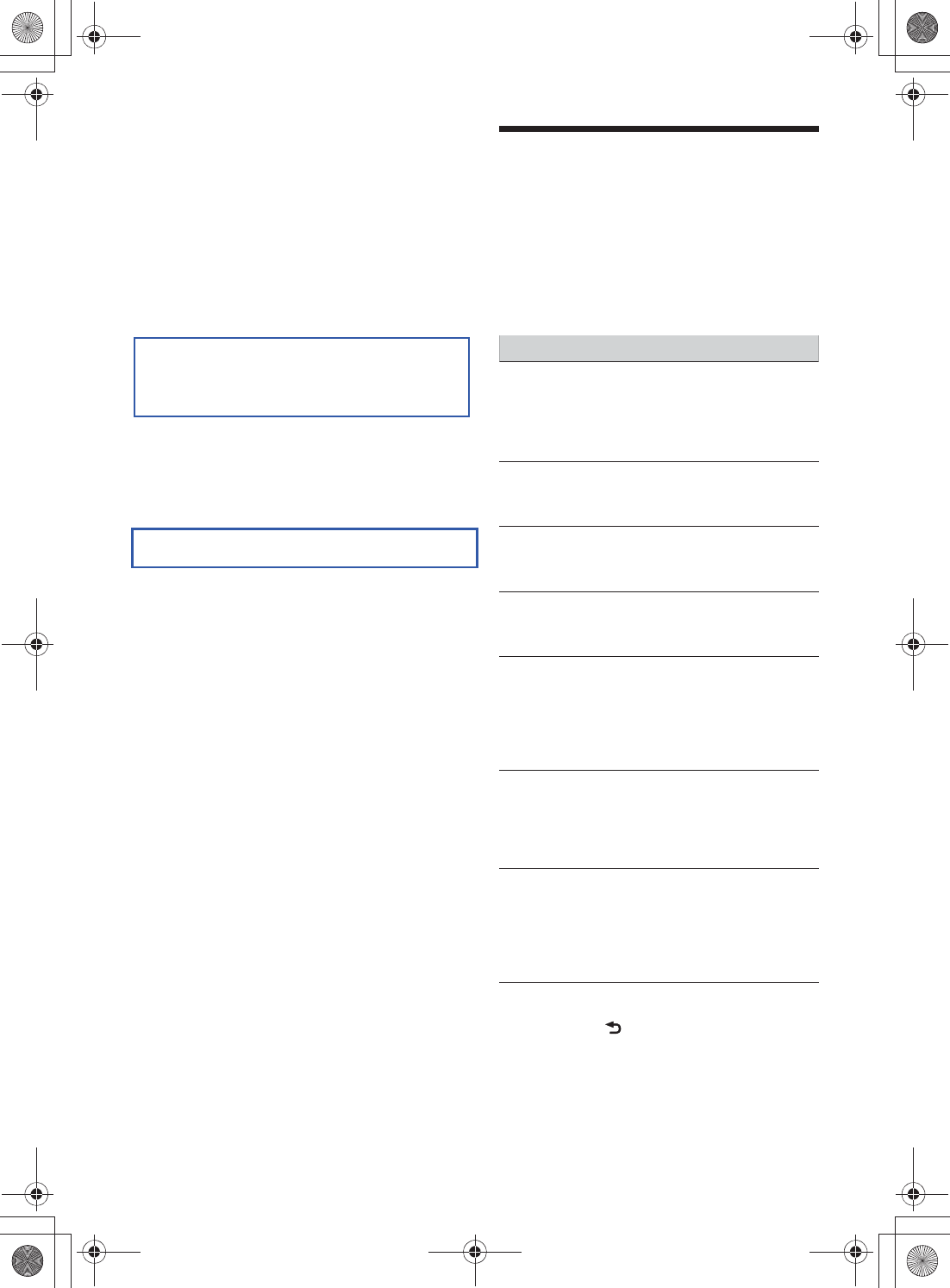
23GB
F:\yoshida\1115\4489688111\4489688111MEXN4000BTUC\01GB-MEXN4000BTUC\040CD.fm masterpage: Right
MEX-N4000BT
4-489-688-11(1)
The N-Mark is a trademark or registered trademark
of NFC Forum, Inc. in the United States and in other
countries.
Windows Media is either a registered trademark or
trademark of Microsoft Corporation in the United
States and/or other countries.
This product is protected by certain intellectual
property rights of Microsoft Corporation. Use or
distribution of such technology outside of this
product is prohibited without a license from
Microsoft or an authorized Microsoft subsidiary.
iPhone, iPod, iPod classic, iPod nano, and iPod
touch are trademarks of Apple Inc., registered in
the U.S. and other countries. App Store is a service
mark of Apple Inc.
MPEG Layer-3 audio coding technology and patents
licensed from Fraunhofer IIS and Thomson.
Pandora, the Pandora logo, and the Pandora trade
dress are trademarks or registered trademarks of
Pandora Media, Inc., used with permission.
Google, Google Play and Android are trademarks of
Google Inc.
BlackBerry® is the property of Research In Motion
Limited and is registered and/or used in the U.S.
and countries around the world. Used under license
from Research In Motion Limited.
Troubleshooting
The following checklist will help you remedy
problems you may encounter with your unit.
Before going through the checklist below, check
the connection and operating procedures.
For details on using the fuse and removing the unit
from the dashboard, refer to the installation/
connections manual supplied with this unit.
If the problem is not solved, visit the support site on
the back cover.
General
No power is being supplied to the unit.
qIf the unit is turned off and the display
disappears, the unit cannot be operated with the
remote commander.
ˋTurn on the unit.
No sound.
qThe position of the fader control [FADER] is not
set for a 2-speaker system.
No beep sound.
qAn optional power amplifier is connected and
you are not using the built-in amplifier.
The contents of the memory have been erased.
qThe power supply lead or battery has been
disconnected or not connected properly.
Stored stations and correct time are erased.
The fuse has blown.
Makes a noise when the position of the ignition
is switched.
qThe leads are not matched correctly with the car’s
accessory power connector.
During playback or reception, the demonstration
mode starts.
qIf no operation is performed for 5 minutes with
[DEMO-ON] set, the demonstration mode starts.
ˋSet [DEMO-OFF] (page 18).
The display disappears from/does not appear in
the display window.
qThe dimmer is set to [DIM-ON] (page 18).
qThe display disappears if you press and hold OFF.
ˋPress OFF on the unit until the display appears.
qThe connectors are dirty (page 21).
The operation buttons do not function.
The disc will not eject.
qPress PTY and (back)/MODE for more than 2
seconds to reset the unit.
The contents stored in memory are erased.
For your safety, do not reset the unit while you
are driving.
010COV.book Page 23 Friday, November 15, 2013 11:49 AM
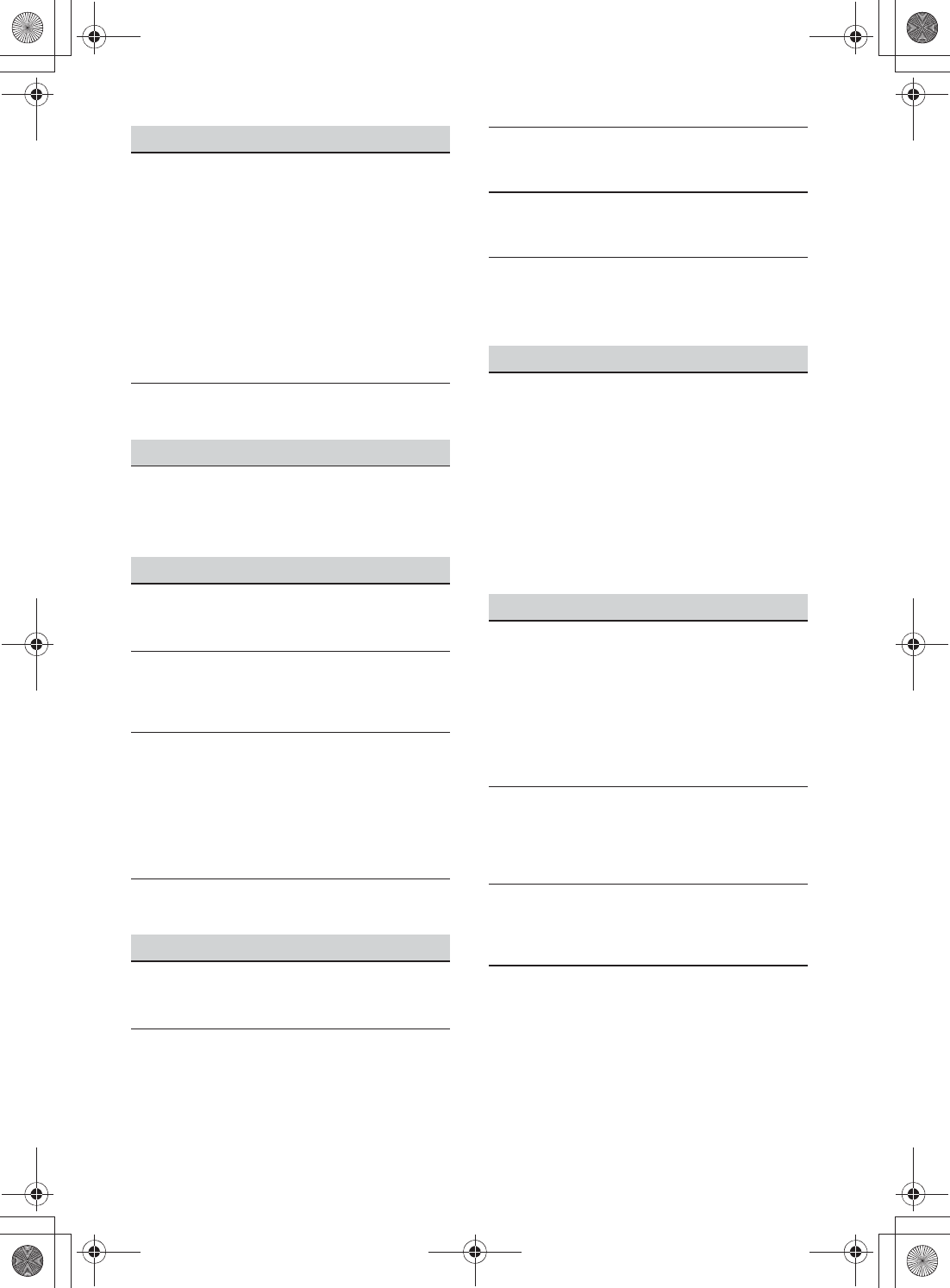
24GB
F:\yoshida\1115\4489688111\4489688111MEXN4000BTUC\01GB-MEXN4000BTUC\040CD.fm masterpage: Left
MEX-N4000BT
4-489-688-11(1)
Radio reception
Stations cannot be received.
The sound is hampered by noises.
qThe connection is not correct.
ˋIf your car has built-in radio antenna (aerial) in
the rear/side glass, connect an REM OUT lead
(blue/white striped) or accessory power supply
lead (red) to the power supply lead of a car’s
antenna (aerial) booster.
ˋCheck the connection of the car antenna
(aerial).
ˋIf the auto antenna (aerial) will not extend,
check the connection of the power antenna
(aerial) control lead.
Preset tuning is not possible.
qThe broadcast signal is too weak.
RDS
PTY displays [- - - - - - - -].
qThe current station is not an RDS station.
qRDS data has not been received.
qThe station does not specify the program type.
CD playback
The disc does not play back.
qDefective or dirty disc.
qThe CD-R/CD-RW is not for audio use (page 19).
MP3/WMA files cannot be played back.
qThe disc is incompatible with the MP3/WMA
format and version. For details on playable discs
and formats, visit the support site.
MP3/WMA files take longer to play back than
others.
qThe following discs take a longer time to start
playback.
ˋA disc recorded with a complicated tree
structure.
ˋA disc recorded in Multi Session.
ˋA disc to which data can be added.
The sound skips.
qDefective or dirty disc.
USB playback
You cannot play back items via a USB hub.
qThis unit cannot recognize USB devices via a USB
hub.
A USB device takes longer to play back.
qThe USB device contains files with a complicated
tree structure.
The sound is intermittent.
qThe sound may be intermittent at a high-bit-rate
of more than 320 kbps.
Pandora® connection is not possible.
qShut down the Pandora® application on the
mobile device, and then launch it again.
Application name is mismatched with the actual
application in App Remote.
qLaunch the application again from the “App
Remote” application.
NFC function
One touch connection (NFC) is not possible.
qIf the smartphone does not respond to the
touching.
ˋCheck that the NFC function of the smartphone
is turned on.
ˋMove the N-Mark part of the smartphone
closer to the N-Mark part on this unit.
ˋIf the smartphone is in a case, remove it.
qNFC receiving sensitivity depends on the device.
If One touch connection with the smartphone
fails several times, make BLUETOOTH connection
manually.
BLUETOOTH function
The connecting device cannot detect this unit.
qBefore the pairing is made, set this unit to pairing
standby mode.
qWhile connected to a BLUETOOTH device, this
unit cannot be detected from another device.
ˋDisconnect the current connection and search
for this unit from another device.
qWhen the device pairing is made, set the
BLUETOOTH signal output to on (page 7).
Connection is not possible.
qThe connection is controlled from one side (this
unit or BLUETOOTH device), but not both.
ˋConnect to this unit from a BLUETOOTH device
or vice versa.
The name of the detected device does not
appear.
qDepending on the status of the other device, it
may not be possible to obtain the name.
No ringtone.
qAdjust the volume by rotating the control dial
while receiving a call.
qDepending on the connecting device, the
ringtone may not be sent properly.
ˋSet [RINGTONE] to [1] (page 18).
qThe front speakers are not connected to the unit.
ˋConnect the front speakers to the unit. The
ringtone is output only from the front speakers.
010COV.book Page 24 Friday, November 15, 2013 11:49 AM
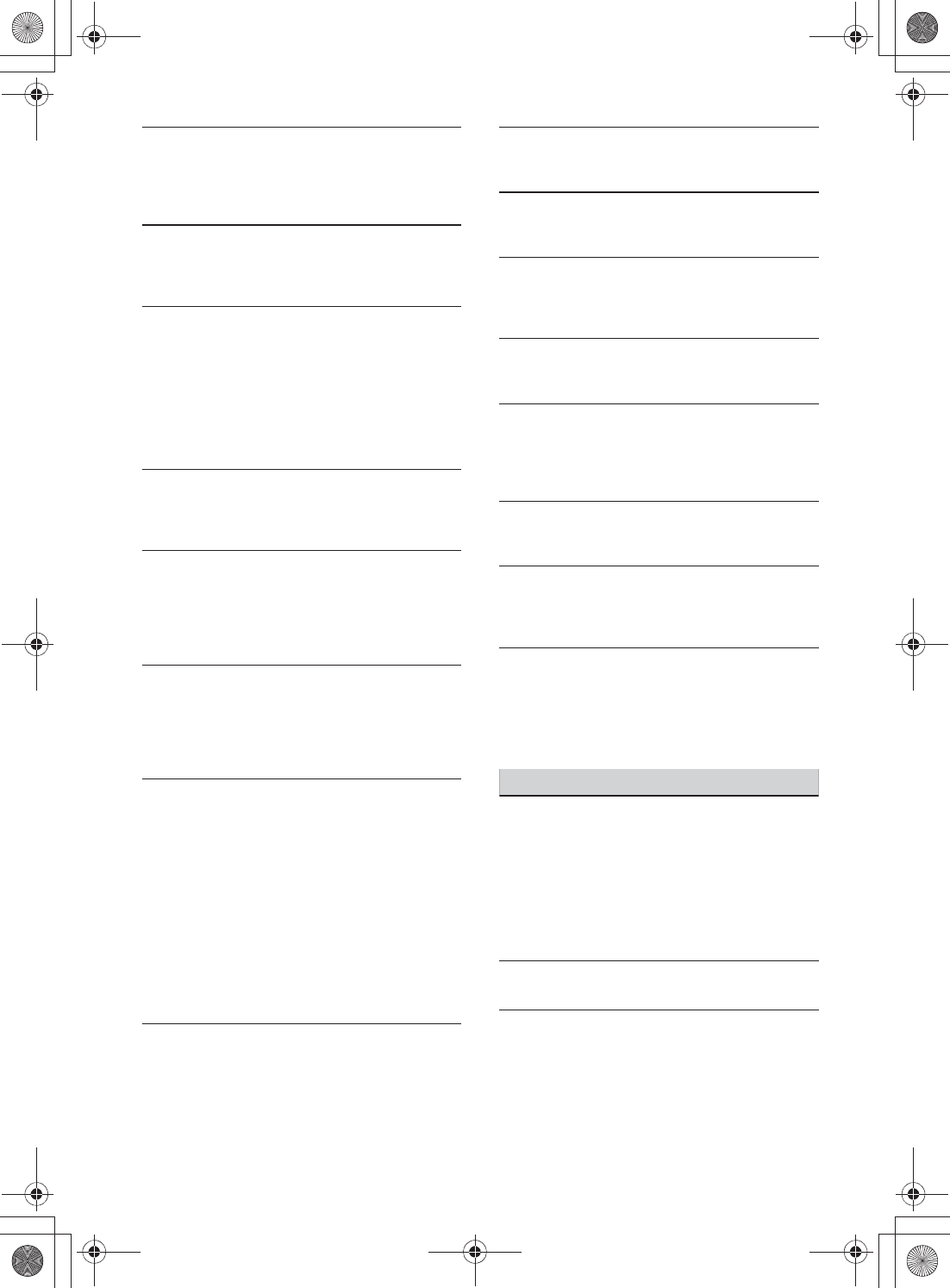
25GB
F:\yoshida\1115\4489688111\4489688111MEXN4000BTUC\01GB-MEXN4000BTUC\040CD.fm masterpage: Right
MEX-N4000BT
4-489-688-11(1)
The talker’s voice cannot be heard.
qThe front speakers are not connected to the unit.
ˋConnect the front speakers to the unit. The
talker’s voice is output only from the front
speakers.
A call partner says that the volume is too low or
high.
qAdjust the volume accordingly using mic gain
adjustment (page 14).
Echo or noise occurs in phone call conversations.
qLower the volume.
qSet EC/NC Mode to [EC/NC-1] or [EC/NC-2]
(page 14).
qIf the ambient noise other than the phone call
sound is loud, try reducing this noise.
E.g.: If a window is open and road noise, etc., is
loud, shut the window. If an air conditioner is
loud, lower the air conditioner.
The phone is not connected.
qWhen BLUETOOTH audio is played, the phone is
not connected even if you press CALL.
ˋConnect from the phone.
The phone sound quality is poor.
qPhone sound quality depends on reception
conditions of cellular phone.
ˋMove your car to a place where you can
enhance the cellular phone’s signal if the
reception is poor.
The volume of the connected audio device is low
(high).
qVolume level will differ depending on the audio
device.
ˋAdjust the volume of the connected audio
device or this unit.
The sound skips during playback of a
BLUETOOTH audio device.
qReduce the distance between the unit and the
BLUETOOTH audio device.
qIf the BLUETOOTH audio device is stored in a case
which interrupts the signal, remove the audio
device from the case during use.
qSeveral BLUETOOTH devices or other devices
which emit radio waves are in use nearby.
ˋTurn off the other devices.
ˋIncrease the distance from the other devices.
qThe playback sound stops momentarily when the
connection between this unit and the cellular
phone is being made. This is not a malfunction.
The connected BLUETOOTH audio device cannot
be controlled.
qCheck that the connected BLUETOOTH audio
device supports AVRCP.
Some functions do not work.
qCheck if the connecting device supports the
functions in question.
A call is answered unintentionally.
qThe connecting phone is set to answer a call
automatically.
Pairing failed due to time out.
qDepending on the connecting device, the time
limit for pairing may be short.
ˋTry completing the pairing within the time.
BLUETOOTH function cannot operate.
qTurn off the unit by pressing OFF for more than 2
seconds, then turn the unit on again.
No sound is output from the car speakers during
handsfree call.
qIf the sound is output from the cellular phone, set
the cellular phone to output the sound from the
car speakers.
Pandora® connection is not possible.
qShut down the Pandora® application on the
mobile device, and then launch again.
Application name is mismatched with the actual
application in App Remote.
qLaunch the application again from the “App
Remote” application.
While running the “App Remote” application via
BLUETOOTH, the display automatically switches
to [BT AUDIO].
qThe “App Remote” application or BLUETOOTH
function has failed.
ˋRun the application again.
Error displays/Messages
ERROR
qThe disc is dirty or inserted upside down.
ˋClean or insert the disc correctly.
qA blank disc has been inserted.
qThe disc cannot play due to a problem.
ˋInsert another disc.
qUSB device was not automatically recognized.
ˋConnect it again.
qPress ì to remove the disc.
HUB NO SUPRT (hubs not supported)
qUSB hub is not supported on this unit.
IPD STOP (iPod stop)
qWhen repeat play is not set, playback of the last
track in album finished.
The music application in the iPod/iPhone is
terminated.
ˋPress PAUSE to start playback again.
010COV.book Page 25 Friday, November 15, 2013 11:49 AM

26GB
F:\yoshida\1115\4489688111\4489688111MEXN4000BTUC\01GB-MEXN4000BTUC\040CD.fm masterpage: Left
MEX-N4000BT
4-489-688-11(1)
NO DEV (no device)
q[USB] is selected as source without a USB device
connected. A USB device or a USB cable has been
disconnected during playback.
ˋBe sure to connect a USB device and USB cable.
NO MUSIC
qThe disc or USB device does not contain a music
file.
ˋInsert a music CD.
ˋConnect a USB device with a music file in it.
OVERLOAD
qUSB device is overloaded.
ˋDisconnect the USB device, then change the
source by pressing SRC.
ˋThe USB device has a fault, or an unsupported
device is connected.
PUSH EJT (push eject)
qThe disc cannot be ejected.
ˋPress ì (eject).
READ
qThe unit is reading all track and album
information on the disc.
ˋWait until reading is complete and playback
starts automatically. Depending on the disc
structure, it may take more than a minute.
USB NO SUPRT (USB not supported)
qThe connected USB device is not supported.
ˋFor details on the compatibility of your USB
device, visit the support site.
[] or []
qDuring reverse or fast-forward, you have reached
the beginning or the end of the disc and you
cannot go any further.
[]
qThe character cannot be displayed.
For BLUETOOTH function:
BT BUSY (BLUETOOTH busy)
qThe phonebook and the call history of the cellular
phone are not accessible from this unit.
ˋWait for a while, and then try again.
ERROR
qBT Initialize failed.
qPhonebook access failed.
qPhonebook content was changed while
accessing the cellular phone.
ˋAccess the phonebook in the cellular phone
again.
MEM FAILURE (memory failure)
qThis unit failed to store the contact in the preset
dial.
ˋMake sure that the number you intend to store
is correct (page 14).
MEMORY BUSY
qThis unit is storing data.
ˋWait until storing has finished.
NO DEV (no device)
qBLUETOOTH audio source is selected without a
BLUETOOTH audio device connected. A
BLUETOOTH audio device has been disconnected
during a call.
ˋBe sure to connect a BLUETOOTH audio device.
qBLUETOOTH phone source is selected without a
cellular phone connected. A cellular phone has
been disconnected during a call.
ˋBe sure to connect a cellular phone.
P EMPTY (preset number empty)
qThe preset dial is empty.
UNKNOWN
qName or phone number cannot be displayed
when browsing phonebook or call history.
WITHHELD
qPhone number is hidden by caller.
For App Remote operation:
APP -------- (application)
qConnection with the application is not made.
ˋEstablish iPhone connection again.
APP DISCNCT (application disconnected)
qApp Remote connection is not made.
ˋEstablish the App Remote connection
(page 15).
APP MENU (application menu)
qButton operation cannot be performed while a
menu on iPhone/Android phone is open.
ˋExit the menu on iPhone/Android phone.
APP NO DEV (application no device)
qThe device with the application installed is not
connected.
ˋConnect the device, then establish iPhone
connection.
APP SOUND (application sound)
qButton operation cannot be performed while a
sound menu on iPhone/Android phone is open.
ˋExit the sound menu on iPhone/Android
phone.
010COV.book Page 26 Friday, November 15, 2013 11:49 AM
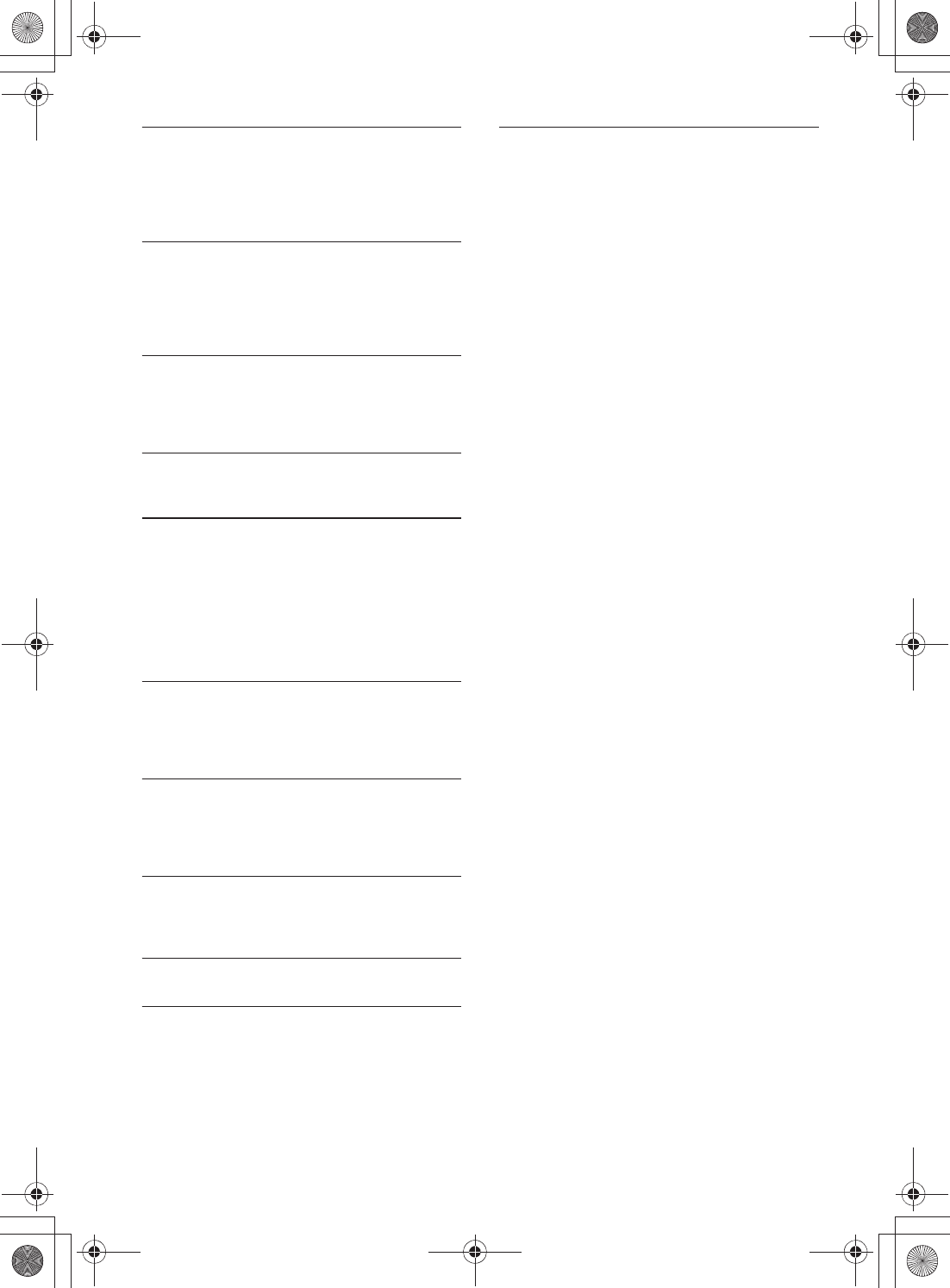
27GB
F:\yoshida\1115\4489688111\4489688111MEXN4000BTUC\01GB-MEXN4000BTUC\040CD.fm masterpage: Right
MEX-N4000BT
4-489-688-11(1)
OPEN APP (open application)
qThe “App Remote” application is not running.
ˋLaunch the iPhone’s application.
For Pandora® operation:
CANNOT SKIP
qSkipping tracks on Pandora® is not allowed.
ˋWait until the commercial ends.
ˋPandora® limits the number of skips allowed on
their service. Wait until the next track begins, or
select another station on the list.
ERROR
q“Thumbs” feedback failed.
ˋTry “Thumbs Up/Down” again.
qBookmarking failed.
ˋTry bookmarking again.
NO STATION
qThere is no station on your Pandora® account.
ˋCreate the station on the mobile device.
NOT ALLOWED
q“Thumbs” feedback is not allowed.
ˋWait until the commercial ends.
ˋSome functions, such as Shared Station, do not
permit feedback. Wait until the next track
begins, or select another station on the list.
qBookmark is not allowed.
ˋWait until the commercial ends.
ˋSelect another track or station, then try it again.
OPEN APP (open application)
When connecting via the USB port.
qPandora® does not launch.
ˋLaunch the Pandora® application on the
iPhone.
OPEN APP (open application), PRESS PAUSE
When connecting via the BLUETOOTH function.
qPandora® does not launch.
ˋLaunch the Pandora® application on the mobile
device, then press PAUSE.
PAN NO SUPRT (Pandora® not supported)
qThe connected device is not supported.
ˋFor details of compatible devices, visit the
support site.
PAN RESTRICT (Pandora® licensing restriction)
qPandora® is not available outside your country.
PLEASE LOGIN, PANDORA APP (Pandora®
application)
qNot logged into your Pandora® account.
ˋDisconnect the device, and log into your
Pandora® account, then connect the device
again.
--:--
qNetwork connection is unstable or lost.
ˋMake the network connection again on the
device.
ˋWait until the network connection is
established.
If these solutions do not help improve the situation,
consult your nearest Sony dealer.
If you take the unit to be repaired because of CD
playback trouble, bring the disc that was used at
the time the problem began.
010COV.book Page 27 Friday, November 15, 2013 11:49 AM
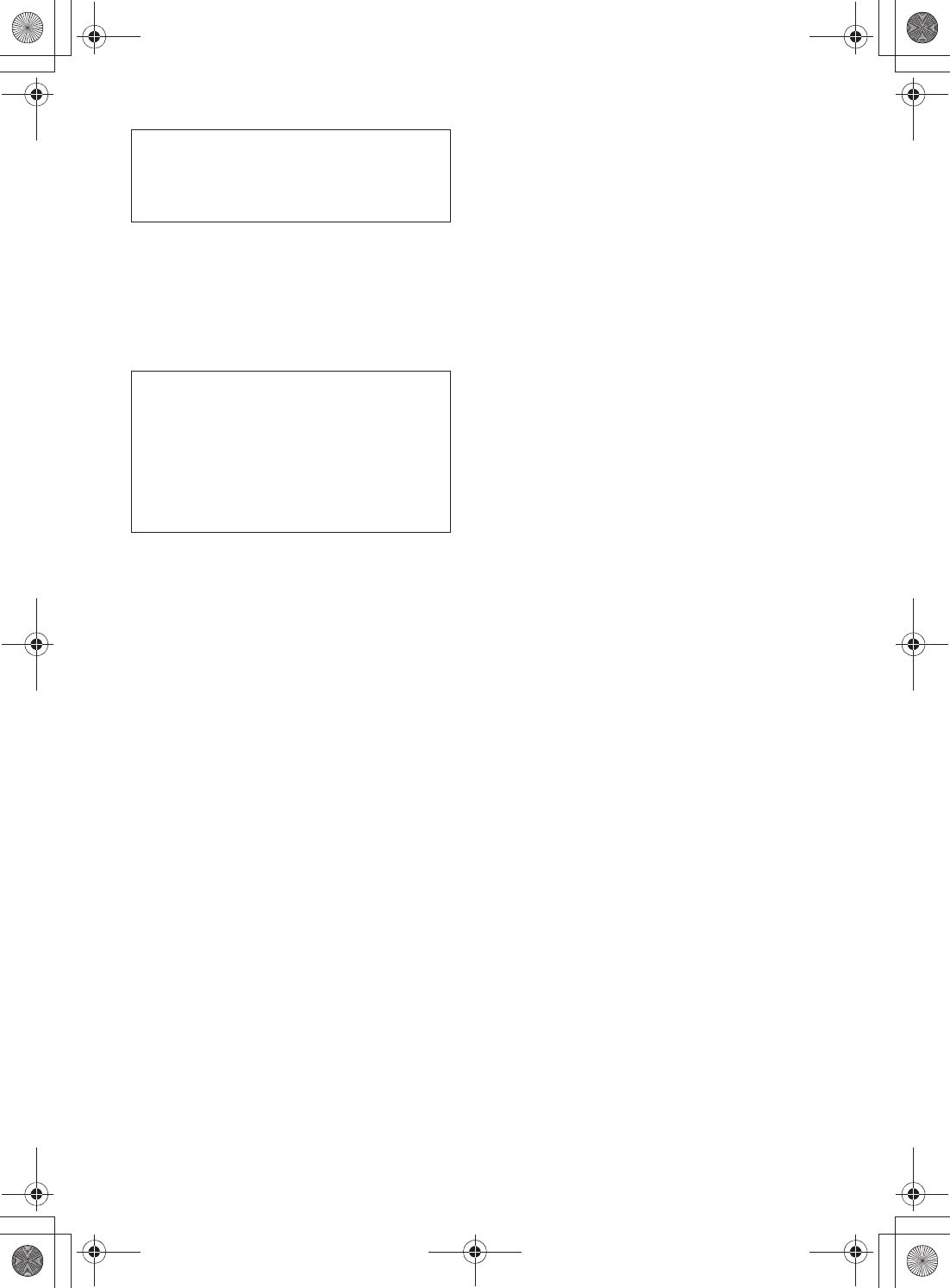
2ES
F:\yoshida\1115\4489688111\4489688111MEXN4000BTUC\02LaES-MEXN4000BTUC\020INT.fm masterpage: Left
MEX-N4000BT
4-489-688-11(1)
PRECAUCIÓN
El uso de instrumentos ópticos con este producto
aumenta el riesgo de sufrir daños oculares.
Nota sobre la pila de litio
No exponga la pila a fuentes de calor excesivo
como luz solar directa, fuego o similar.
Asegúrese de instalar esta unidad en el tablero
del automóvil por razones de seguridad.
Para realizar la instalación y las conexiones,
consulte el manual de instalación y conexiones
suministrado.
Advertencia: si el encendido del automóvil
no dispone de una posición ACC
Asegúrese de ajustar la función AUTO OFF
(página 18). La unidad se apagará completa y
automáticamente en el tiempo establecido
después de apagarla, lo cual evita que se agote
la batería. Si no ajusta la función AUTO OFF,
mantenga presionado OFF hasta que se apague
la pantalla cada vez que apague el motor.
010COV.book Page 2 Friday, November 15, 2013 11:49 AM
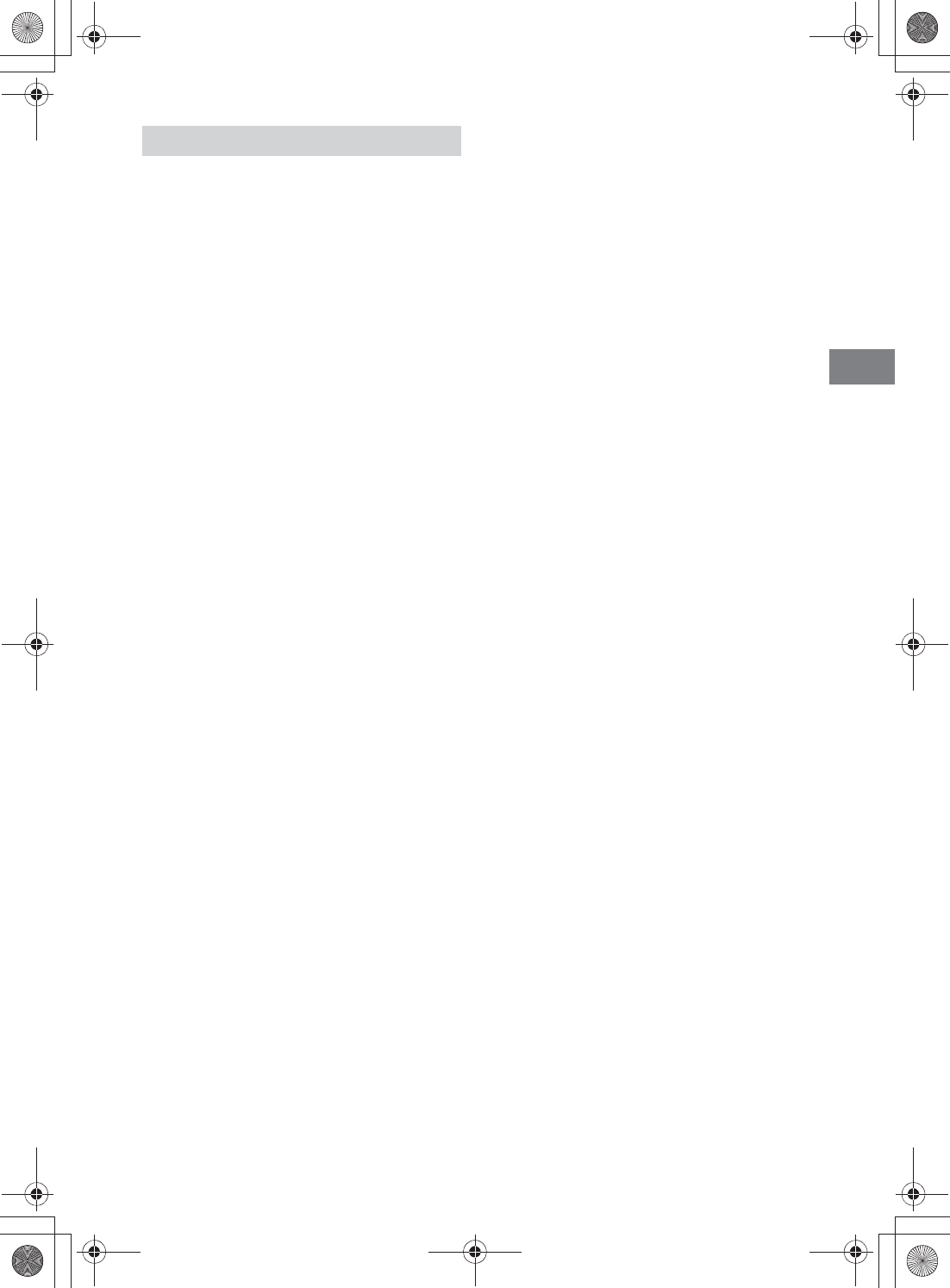
3ES
F:\yoshida\1115\4489688111\4489688111MEXN4000BTUC\02LaES-MEXN4000BTUC\020INT.fm masterpage: Right
MEX-N4000BT
4-489-688-11(1)
Precaución
SONY NO SERÁ RESPONSABLE DE NINGÚN DAÑO
INCIDENTAL, INDIRECTO O DERIVADO NI DE OTROS
DAÑOS QUE INCLUYEN, ENTRE OTROS, PÉRDIDA DE
GANANCIAS, PÉRDIDA DE INGRESOS, PÉRDIDA DE
DATOS, PÉRDIDA DE LA UTILIDAD DEL PRODUCTO O
DE CUALQUIER EQUIPO RELACIONADO, TIEMPO DE
INACTIVIDAD Y TIEMPO DEL COMPRADOR
RELACIONADO CON LA UTILIZACIÓN DE ESTE
PRODUCTO, SU HARDWARE Y SU SOFTWARE, O QUE
RESULTE DE DICHA UTILIZACIÓN.
AVISO IMPORTANTE
Utilización segura y eficaz
Los cambios o las modificaciones que se realicen en
esta unidad sin la aprobación de Sony pueden
anular la autorización del usuario para utilizar el
equipo.
Revise las excepciones, debido a requisitos
nacionales o limitaciones, en cuanto a la utilización
de los equipos BLUETOOTH antes de utilizar el
producto.
Manejo
Consulte las leyes y las normas acerca de la
utilización de teléfonos celulares y equipos de
manos libres en las áreas en las que maneja.
Preste siempre atención a la carretera y estacione el
automóvil antes de realizar o contestar una llamada
si las condiciones lo requieren.
Conexión a otros dispositivos
Al conectar el equipo a cualquier otro dispositivo,
lea el manual de instrucciones correspondiente
para obtener las instrucciones de seguridad.
Exposición a radiofrecuencia
Las señales de radiofrecuencia pueden afectar los
sistemas electrónicos que no hayan sido instalados
o protegidos correctamente en automóviles, como
los sistemas electrónicos de inyección de
combustible, sistemas electrónicos de frenado
antideslizante (antibloqueo), sistemas electrónicos
de control de velocidad o sistemas de airbag. Para
la instalación o el mantenimiento de este
dispositivo, consulte al fabricante de su automóvil o
su representante. La instalación o el
mantenimiento incorrectos podrían ser peligrosos e
invalidar cualquier garantía aplicada a este
dispositivo.
Consulte con el fabricante de su automóvil para
asegurarse de que el uso del teléfono celular en el
automóvil no afectará el sistema electrónico.
Controle regularmente que todos los equipos del
dispositivo inalámbrico de su automóvil estén
instalados y funcionen correctamente.
Llamadas de emergencia
El dispositivo de manos libres BLUETOOTH para
automóviles y el dispositivo electrónico conectados
al manos libres funcionan utilizando redes de
señales de radio, celulares y terrestres así como
también la función programada por el usuario, que
no puede garantizar la conexión en todas las
condiciones.
Por lo tanto, no dependa únicamente de un
dispositivo electrónico para las comunicaciones
esenciales (como las emergencias médicas).
Recuerde que, para realizar o recibir llamadas, el
dispositivo de manos libres y el dispositivo
electrónico conectado al manos libres deben operar
en una zona de servicio que tenga una intensidad
de señal para celulares adecuada.
Es posible que no se puedan realizar llamadas de
emergencia en todas las redes de teléfonos
celulares o cuando se estén utilizando ciertos
servicios de la red y características del teléfono.
Verifíquelo con su proveedor de servicio local.
Notas sobre la función BLUETOOTH
010COV.book Page 3 Friday, November 15, 2013 11:49 AM
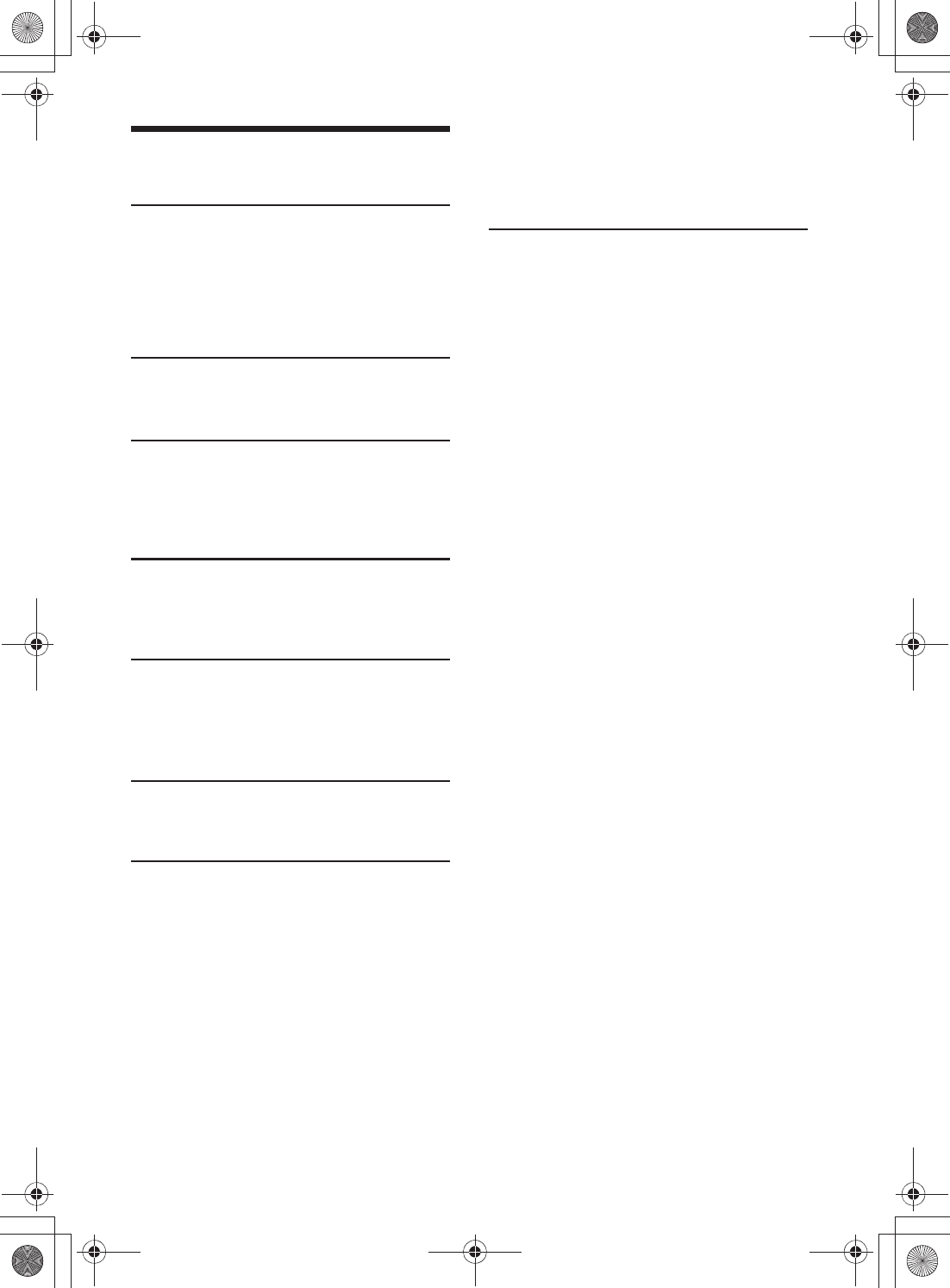
4ES
F:\yoshida\1115\4489688111\4489688111MEXN4000BTUC\02LaES-
MEXN4000BTUC\030TOC.fm
masterpage: Left
MEX-N4000BT
4-489-688-11(1)
Tabla de contenidos
Guía para las partes y los controles. . . . . . . . . . . . . 5
Procedimientos iniciales
Extracción del panel frontal . . . . . . . . . . . . . . . . . . . 7
Ajuste del reloj. . . . . . . . . . . . . . . . . . . . . . . . . . . . . . 7
Preparación del dispositivo BLUETOOTH . . . . . . . . 7
Conexión de un dispositivo iPod/USB. . . . . . . . . . . 9
Conexión de otro dispositivo de audio
portátil . . . . . . . . . . . . . . . . . . . . . . . . . . . . . . . . 10
Escuchar la radio
Escuchar la radio . . . . . . . . . . . . . . . . . . . . . . . . . . . 10
Usar el RDS (Sistema de datos de radio). . . . . . . . 11
Reproducción
Reproducción de un disco . . . . . . . . . . . . . . . . . . . 11
Reproducción de un dispositivo iPod/USB . . . . . . 11
Reproducción de un dispositivo BLUETOOTH. . . . 12
Búsqueda y reproducción de pistas . . . . . . . . . . . 12
Escuchar a Pandora®
Preparación para Pandora® . . . . . . . . . . . . . . . . . . 13
Transmisión de Pandora® . . . . . . . . . . . . . . . . . . . . 13
Operaciones disponibles en Pandora® . . . . . . . . . 14
Realización de llamadas con manos
libres
Rechazo de llamadas . . . . . . . . . . . . . . . . . . . . . . . 14
Realización de llamadas. . . . . . . . . . . . . . . . . . . . . 14
Tareas disponibles durante la llamada . . . . . . . . . 16
Funciones útiles
App Remote con iPhone/
teléfono con Android . . . . . . . . . . . . . . . . . . . . 16
Ajustes
Cancelación del modo DEMO . . . . . . . . . . . . . . . . 18
Operación básica de ajustes . . . . . . . . . . . . . . . . . 18
Configuración GENERAL . . . . . . . . . . . . . . . . . . . . . 18
Configuración SOUND. . . . . . . . . . . . . . . . . . . . . . . 18
EQ10 PRESET . . . . . . . . . . . . . . . . . . . . . . . . . . . 18
EQ10 SETTING . . . . . . . . . . . . . . . . . . . . . . . . . . 18
POSITION (posición de escucha) . . . . . . . . . . . 19
RB ENH (Potenciador posterior de sonidos
graves) . . . . . . . . . . . . . . . . . . . . . . . . . . . . . . . . 19
SW DIREC (Conexión directa al altavoz
potenciador de graves) . . . . . . . . . . . . . . . . . . 19
Configuración DISPLAY . . . . . . . . . . . . . . . . . . . . . 20
Configuración BT (BLUETOOTH). . . . . . . . . . . . . . . 20
BT INIT (Inicialización de la tecnología
BLUETOOTH) . . . . . . . . . . . . . . . . . . . . . . . . . . . 20
Configuración APP REM (App Remote). . . . . . . . . 20
Información complementaria
Precauciones. . . . . . . . . . . . . . . . . . . . . . . . . . . . . . 21
Mantenimiento . . . . . . . . . . . . . . . . . . . . . . . . . . . . 23
Especificaciones . . . . . . . . . . . . . . . . . . . . . . . . . . . 24
Solución de problemas . . . . . . . . . . . . . . . . . . . . . 25
010COV.book Page 4 Friday, November 15, 2013 11:49 AM
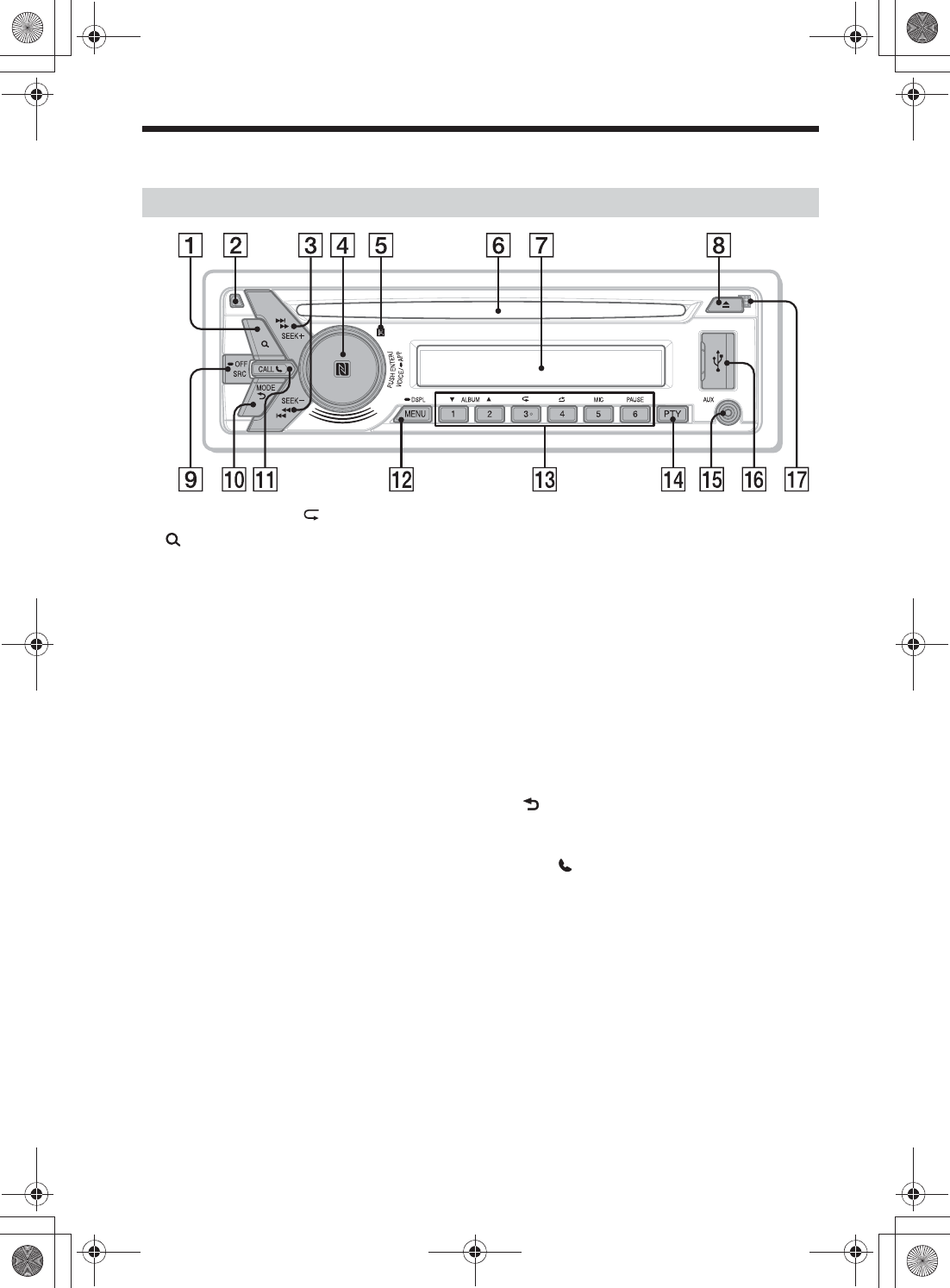
5ES
F:\yoshida\1115\4489688111\4489688111MEXN4000BTUC\02LaES-MEXN4000BTUC\040CD.fm masterpage: Right
MEX-N4000BT
4-489-688-11(1)
Guía para las partes y los controles
El botón con el número 3/ (repetir) tiene un punto sensible al tacto.
ȩ (navegar) (página 13, 14)
Para entrar al modo de navegación durante la
reproducción.
ȪBotón de liberación del panel frontal
ȫSEEK +/–
Para sintonizar emisoras de radio en forma
automática. Manténgalo presionado para
sintonizarlas en forma manual.
Ã/Ñ (anterior/siguiente)
ù/ß (retroceso rápido/avance rápido)
ȬSelector de control
Gírelo para ajustar el volumen.
ENTER
Ingresar el elemento seleccionado.
Presione SRC, gire y luego presione para
cambiar la fuente.
VOICE (página 15)
Activar el marcado por voz.
Cuando la función App Remote está encendida,
el reconocimiento de voz está activado (solo
para teléfonos Android™).
-APP
Presione durante 2 segundos para establecer la
función App Remote (conexión).
Marca N
Toque el selector del control con un teléfono
Android para establecer conexión BLUETOOTH.
ȭReceptor del control remoto
ȮRanura del disco
ȯVisualizador
Ȱì (expulsar disco)
ȱSRC (fuente)
Para encender la unidad.
Para cambiar la fuente.
-OFF
Manténgalo presionado durante 1 segundo para
apagar la unidad.
Manténgalo presionado durante más de 2
segundos para apagar la unidad y la pantalla.
Si la unidad está apagada y la pantalla
desaparece, no se puede operar con el control
remoto.
Ȳ (volver)
Para volver a la pantalla anterior.
MODE (página 10, 12, 14, 16)
ȳCALL
Acceda al menú de llamada. Recibe/finaliza una
llamada.
Presione y sostenga más de 2 segundos para
cambiar la señal de BLUETOOTH.
ȴMENU
Para abrir el menú de configuración.
-DSPL (pantalla)
Presione y aguarde, luego presione para
cambiar los elementos de la pantalla.
Unidad principal
010COV.book Page 5 Friday, November 15, 2013 11:49 AM

6ES
F:\yoshida\1115\4489688111\4489688111MEXN4000BTUC\02LaES-MEXN4000BTUC\040CD.fm masterpage: Left
MEX-N4000BT
4-489-688-11(1)
ȵBotones numéricos (de 1 a 6)
Para recibir las emisoras almacenadas.
Manténgalo presionado para almacenarlas en
forma manual.
Llame a un número almacenado. Manténgalo
apretado para guardar un número telefónico.
ALBUM è/Ă
Para saltearse un álbum en el dispositivo de
audio. Manténgalo apretado para saltear
álbumes en forma continua.
Presione Ă para subir, o è para bajar en
Pandora® (página 14).
(repetir)
(reproducción aleatoria)
MIC (página 16)
PAUSE
ȶPTY (Tipos de programa)
Para seleccionar los PTY en RDS.
ȷToma de entrada AUX
ȸPuerto USB
ȹMicrófono (en el panel interno)
Para que la función manos libres funcione
correctamente, no cubra el micrófono con cinta,
etc.
El botón VOL (volumen) + tiene un punto sensible al
tacto.
Retire la película de aislamiento antes del uso.
ȺR (Ã)/C (Ñ)
ȻVOL (volumen) +/–
ȼSOUND
Abra el menú SOUND directamente.
-MENU
Manténgalo presionado para abrir el menú de
configuración.
Ƚa (+)/{ (–)
ȾDSPL (pantalla)/-SCRL(desplazamiento)
Para moverse entre los elementos de pantalla.
Manténgalo apretado para desplazarse a un
elemento de pantalla.
Control remoto RM-X231
010COV.book Page 6 Friday, November 15, 2013 11:49 AM
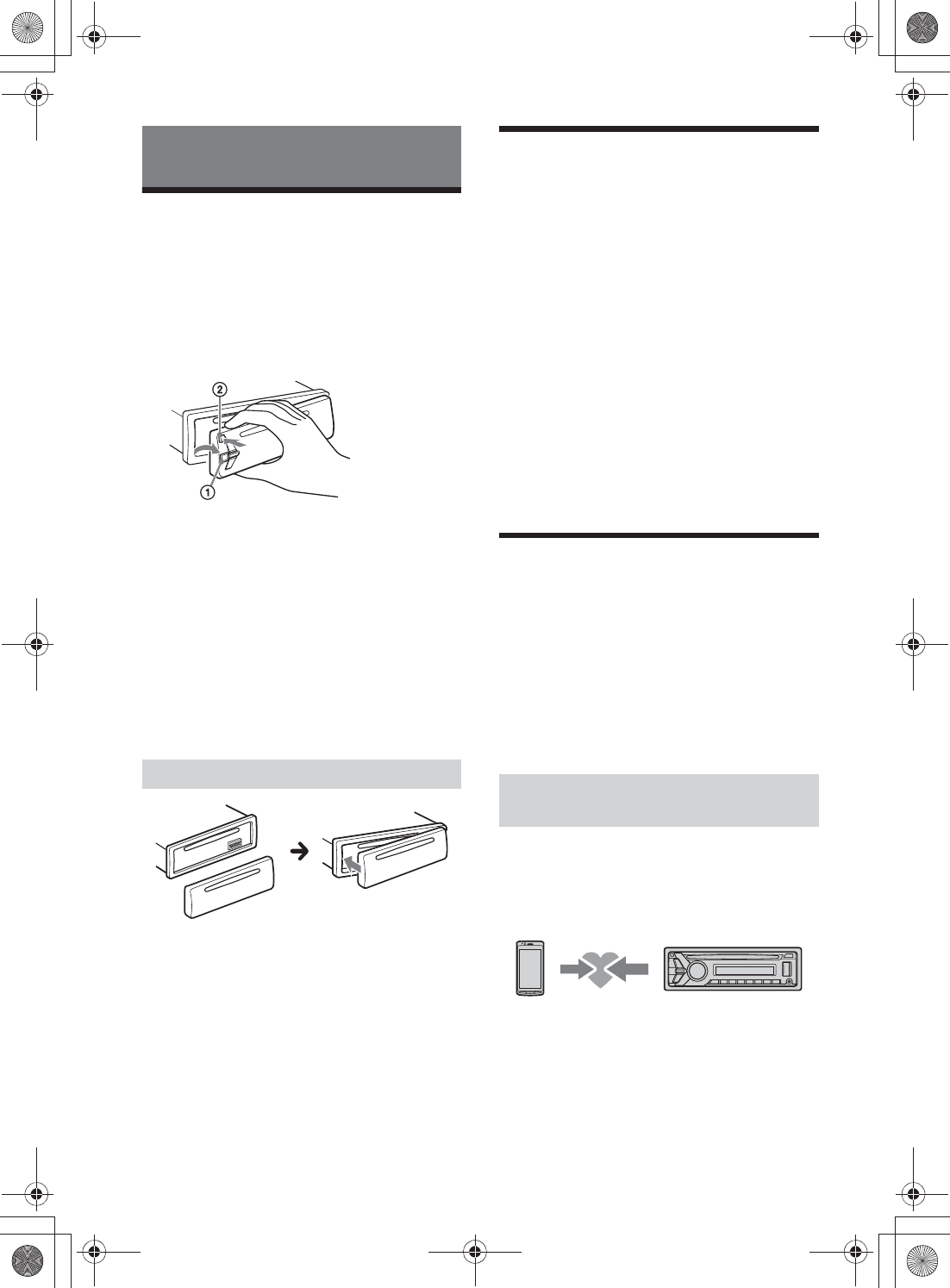
7ES
F:\yoshida\1115\4489688111\4489688111MEXN4000BTUC\02LaES-MEXN4000BTUC\040CD.fm masterpage: Right
MEX-N4000BT
4-489-688-11(1)
Extracción del panel frontal
Es posible extraer el panel frontal de la unidad para
evitar que la roben.
1Mantenga presionado OFF ʓ.
La unidad se apagará.
2Presione el botón de liberación del panel
frontal ʔ y, a continuación, extraiga el
panel tirando de él hacia usted.
Alarma de precaución
Si gira el interruptor de la llave de encendido hasta
la posición OFF sin haber extraído el panel frontal,
la alarma de precaución sonará durante unos
segundos. La alarma sonará solamente si se utiliza
el amplificador incorporado.
Números de serie
Asegúrese de que los números de serie al final de la
unidad coincidan correctamente con los de la parte
posterior del panel frontal. De lo contrario, no se
podrá emparejar, conectarse o desconectarse a
BLUETOOTH por NFC.
Ajuste del reloj
1Presione MENU, gire el selector de
control para seleccionar [GENERAL] y, a
continuación, presiónelo.
2Gire el selector de control para
seleccionar [CLOCK-ADJ] y, a
continuación, presiónelo.
La indicación de la hora parpadea.
3Gire el selector de control para ajustar la
hora y los minutos.
Para mover la indicación digital, presione
SEEK +/–.
4Una vez ajustados los minutos, presione
MENU.
El ajuste se completa y el reloj se pone en
funcionamiento.
Presione DSPL para mostrar el reloj.
Preparación del dispositivo
BLUETOOTH
Si conecta un dispositivo BLUETOOTH adecuado,
puede escuchar música o realizar llamadas con
manos libres. Para obtener más información acerca
de la conexión, consulte las instrucciones de
funcionamiento que se suministran con el
dispositivo.
Antes de conectar el dispositivo, apague el
volumen de esta unidad; si no lo hace, puede oírse
un sonido fuerte.
Cuando conecte un dispositivo BLUETOOTH
(teléfono celular, dispositivo de audio, etc.) por
primera vez es necesario el registro de ambos
dispositivos (denominado “emparejamiento”). El
emparejamiento permite que la unidad y otros
dispositivos se reconozcan entre sí.
1Coloque el dispositivo BLUETOOTH
dentro de 1 m de distancia respecto de la
unidad.
Procedimientos iniciales
Colocación del panel frontal Emparejamiento y conexión con otro
dispositivo BLUETOOTH
010COV.book Page 7 Friday, November 15, 2013 11:49 AM

8ES
F:\yoshida\1115\4489688111\4489688111MEXN4000BTUC\02LaES-MEXN4000BTUC\040CD.fm masterpage: Left
MEX-N4000BT
4-489-688-11(1)
2Presione CALL, gire el selector de control
para seleccionar [PAIRING] y, a
continuación, presiónelo.
parpadea.
La unidad entrará en modo de espera de
emparejamiento.
3Realice el emparejamiento en el
dispositivo BLUETOOTH para detectar
esta unidad.
4Seleccione [Sony Car Audio] que se
muestra en la pantalla del dispositivo de
BLUETOOTH.
Si [Sony Car Audio] no aparece, repita desde el
paso 2.
5Si se requiere una clave* en el dispositivo
BLUETOOTH, escriba [0000].
* La clave de paso puede denominarse “clave de
acceso”, “código PIN”, “número PIN” o
“contraseña” etc. en función del dispositivo.
Cuando se empareja, queda encendida.
6Seleccione esta unidad en el dispositivo
BLUETOOTH para establecer la conexión
BLUETOOTH.
o se enciende cuando la conexión está
establecida.
Nota
Mientras se conecta a un dispositivo BLUETOOTH, esta
unidad no puede detectarse desde otro dispositivo.
Para habilitar la detección, acceda al modo de
emparejamiento y busque esta unidad desde otro
dispositivo.
Para cancelar el emparejamiento
Realizar el paso 2 para cancelar el modo de
emparejamiento luego de que esta unidad y el
dispositivo BLUETOOTH estén emparejados.
Para utilizar un dispositivo emparejado, es
necesaria la conexión con esta unidad. Algunos
dispositivos emparejados se conectarán
automáticamente.
1Presione CALL, gire el selector de control
para seleccionar [BT SIGNL] y, a
continuación, presiónelo.
Asegúrese de que se encienda.
2Active la función BLUETOOTH en el
dispositivo BLUETOOTH.
3Inicie el dispositivo BLUETOOTH para
conectarlo a esta unidad.
o se enciende.
Iconos en la pantalla:
Para conectar el dispositivo que se conectó
por última vez en esta unidad
Active la función BLUETOOTH en el dispositivo
BLUETOOTH.
Presione SRC.
Seleccione [BT PHONE] o [BT AUDIO].
Presione ENTER para conectar con el teléfono
celular, o PAUSE para conectar con el dispositivo de
audio.
Nota
Mientras trasmite audio BLUETOOTH, no puede realizar
la conexión de esta unidad al teléfono celular. Realice
en cambio la conexión desde el teléfono celular a la
unidad.
Sugerencia
Con la señal BLUETOOTH activada: si el encendido se
ajusta en la posición ON, la unidad vuelve a conectarse
automáticamente al último teléfono celular conectado.
Para instalar el micrófono
La instalación del micrófono (no suministrado)
mejorará la calidad del audio mientras se habla por
esta unidad. Para obtener más detalles sobre cómo
conectar el micrófono, consulte el manual
suministrado con el micrófono.
[0000]
Introduzca la clave
Conexión con un dispositivo
BLUETOOTH emparejado
Se enciende cuando un teléfono celular
se conecta a la unidad.
Se enciende cuando un dispositivo de
audio se conecta a la unidad.
Indica la potencia de la señal del
teléfono celular al que se conecta.
010COV.book Page 8 Friday, November 15, 2013 11:49 AM
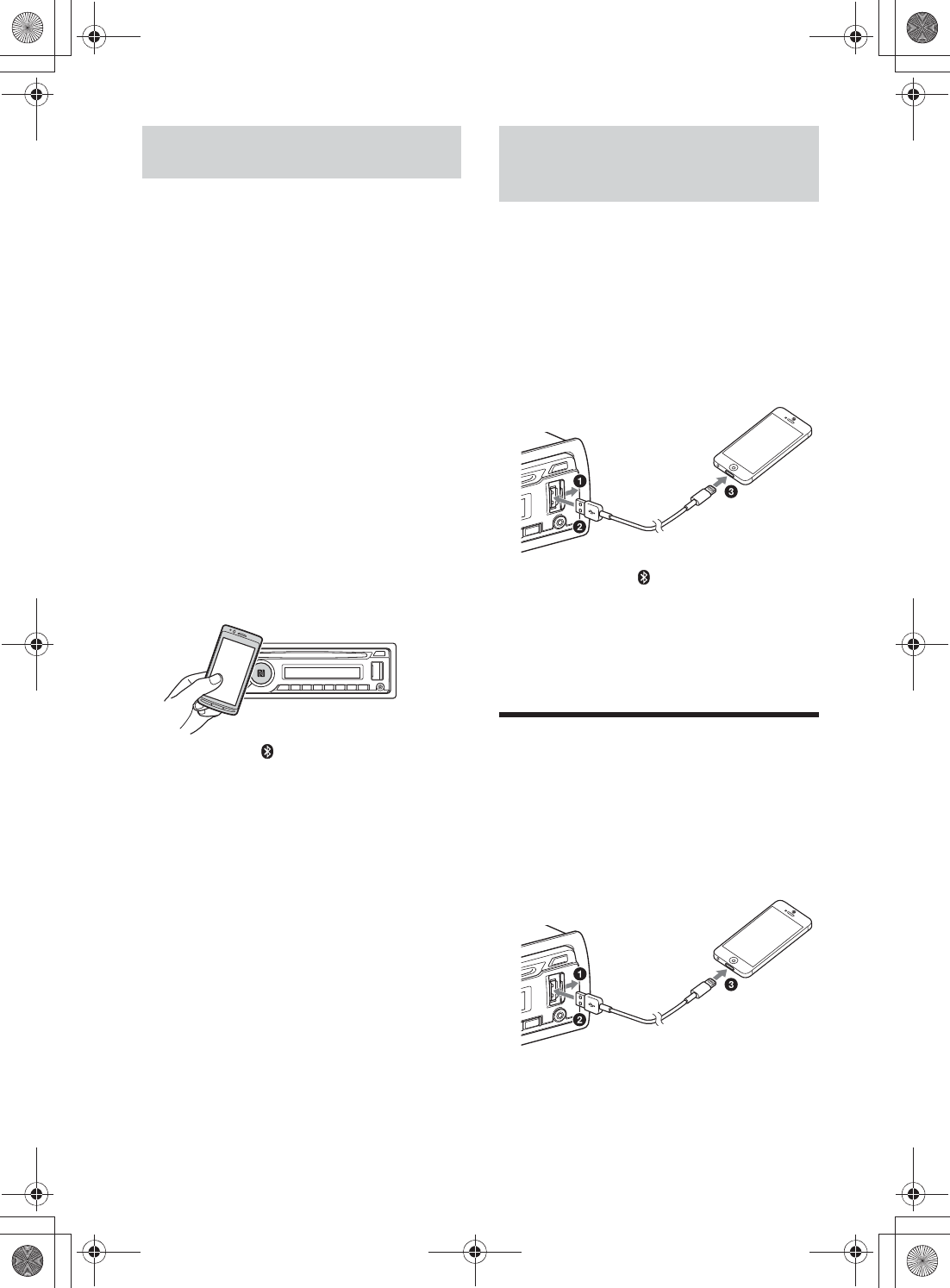
9ES
F:\yoshida\1115\4489688111\4489688111MEXN4000BTUC\02LaES-MEXN4000BTUC\040CD.fm masterpage: Right
MEX-N4000BT
4-489-688-11(1)
Al tocar el selector del control de la unidad con un
smartphone compatible con NFC*, la unidad está
emparejada y automáticamente conectada con el
smartphone.
* NFC (Transmisión de datos en proximidad) es una
tecnología que permite la comunicación inalámbrica
de corto rango entre varios dispositivos, como
teléfonos móviles y etiquetas de IC. Gracias a la
función de NFC, la comunicación de datos se puede
alcanzar fácilmente con solo tocar el símbolo o
ubicación señalados en dispositivos compatibles con
tecnología NFC.
Para un smartphone con Android OS 4.0 o inferior
instalado, se requiere descargar la aplicación “NFC
Easy Connect” disponibles en Google Play™. Es
posible que la aplicación no esté disponible para su
descarga en algunos países/regiones.
1Activación de la función NFC en un
smartphone.
Para obtener más información, consulte las
instrucciones de funcionamiento suministradas
con el smartphone.
2Toque la parte marca N de la unidad con
la parte marca N del smartphone.
Asegúrese que se encienda en la pantalla de
la unidad.
Para desconectar mediante One touch
Toque nuevamente la parte marca N de la unidad
con la parte marca N del smartphone.
Notas
ˎAl realizar la conexión, manipule el smartphone
cuidadosamente para evitar raspaduras.
ˎLa conexión One touch no es posible cuando la
unidad ya está conectada a otro dispositivo
compatible con tecnología NFC. En este caso,
desconecte el dispositivo y haga conexión con el
smartphone nuevo.
Cuando un iPhone/iPod con iOS5 o posterior está
conectado al puerto USB, la unidad se empareja y
conecta con el iPhone/iPod automáticamente.
Para habilitar el emparejamiento automático de
BLUETOOTH, asegúrese de que [AUTO PAIRING] en
la configuración BT esté marcado como [ON]
(página 20).
1Active la función BLUETOOTH en el
iPhone/iPod.
2Conecte un iPhone/iPod al puerto USB.
Asegúrese de que se encienda en la pantalla
de la unidad.
Nota
El emparejamiento automático de BLUETOOTH no será
posible si la unidad ya está conectada a otro equipo
BLUETOOTH. En este caso, desconecte el otro equipo y
luego vuelva a conectar el iPhone/iPod.
Conexión de un dispositivo
iPod/USB
1Baje el volumen de la unidad.
2Conecte el dispositivo iPod/USB a la
unidad.
Para conectar un iPod/iPhone, utilice el cable de
conexión USB para iPod (no suministrado).
Conectar con un Smartphone a través
de One touch (NFC)
Conexión de un dispositivo iPhone/
iPod (emparejamiento automático
BLUETOOTH)
Al conectar un iPhone 5
010COV.book Page 9 Friday, November 15, 2013 11:49 AM
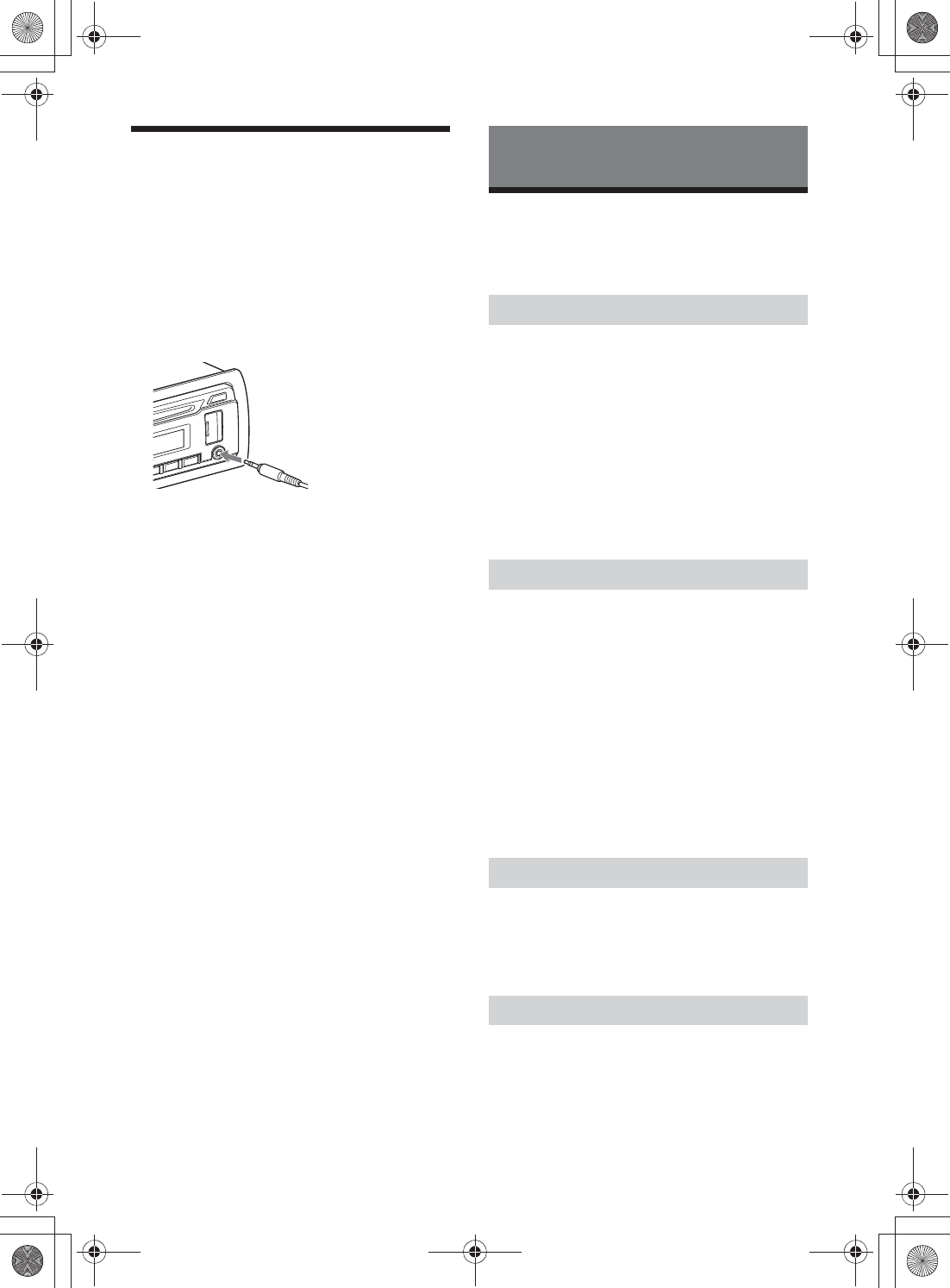
10ES
F:\yoshida\1115\4489688111\4489688111MEXN4000BTUC\02LaES-MEXN4000BTUC\040CD.fm masterpage: Left
MEX-N4000BT
4-489-688-11(1)
Conexión de otro dispositivo de
audio portátil
1Apague el dispositivo de audio portátil.
2Baje el volumen de la unidad.
3Conecte el dispositivo de audio portátil a
la toma de entrada AUX (minitoma
estéreo) en la unidad con un cable de
conexión (no suministrado)*.
* Asegúrese de utilizar una clavija recta.
4Presione SRC para seleccionar [AUX].
Coincidencia del nivel de volumen del
dispositivo conectado con otras fuentes
Comience la reproducción del dispositivo de audio
portátil en un nivel moderado y configure su nivel
habitual de volumen en la unidad.
Presione MENU y gire el selector de control.
Seleccione [SOUND] q [AUX VOL] (página 20).
Escuchar la radio
Para escuchar una estación de radio, presione SRC
para seleccionar [TUNER].
1Presione MODE para cambiar la banda
de radio (FM1, FM2, FM3, AM1 o AM2).
2Presione MENU, gire el selector de
control para seleccionar [GENERAL] y, a
continuación, presiónelo.
3Gire el selector de control para
seleccionar [BTM] y, a continuación,
presiónelo.
La unidad almacena las emisoras en el orden de
frecuencia en los botones numéricos.
1Presione MODE para cambiar la banda
de radio (FM1, FM2, FM3, AM1 o AM2).
2Realice la sintonización.
Para realizar la sintonización manual
Mantenga presionado SEEK +/– para ubicar la
frecuencia aproximada y, a continuación,
presiónelo repetidas veces para ajustar la
frecuencia deseada con mayor precisión.
Para realizar la sintonización automática
Presione SEEK +/–.
La búsqueda se detiene cuando la unidad
recibe una emisora. Repita este procedimiento
hasta recibir la emisora deseada.
1Mientras recibe la emisora que desea
almacenar, mantenga presionado un
botón numérico (de 1 a 6) hasta que
aparezca [MEM].
1Seleccione la banda y, a continuación,
presione un botón numérico (de 1 a 6).
Escuchar la radio
Almacenamiento automático (BTM)
Sintonización
Almacenamiento manual
Recepción de las emisoras almacenadas
010COV.book Page 10 Friday, November 15, 2013 11:49 AM
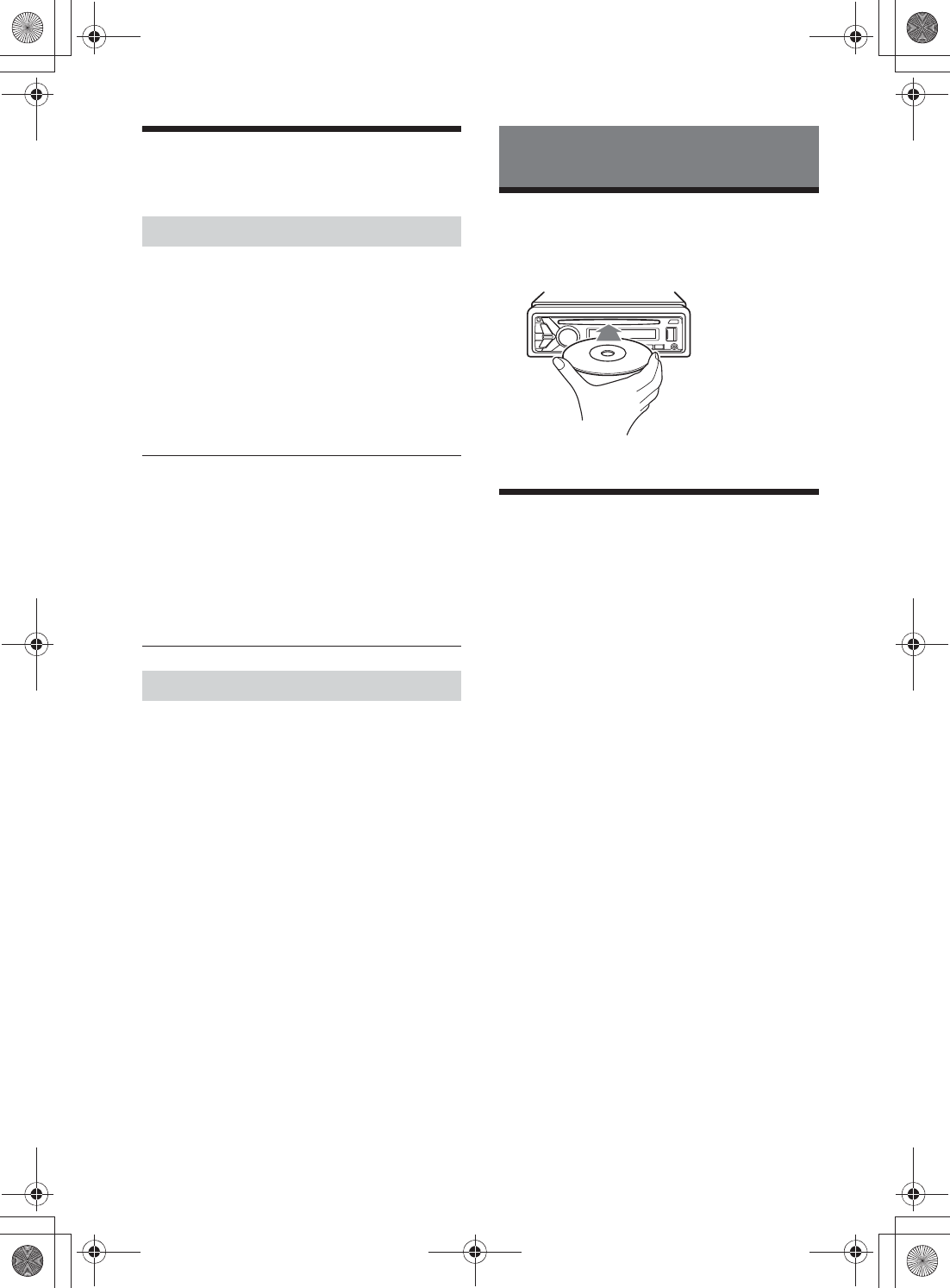
11ES
F:\yoshida\1115\4489688111\4489688111MEXN4000BTUC\02LaES-MEXN4000BTUC\040CD.fm masterpage: Right
MEX-N4000BT
4-489-688-11(1)
Usar el RDS (Sistema de datos
de radio)
Usar PTY para mostrar o buscar el tipo de programa
deseado.
1Presione PTY durante la recepción FM.
2Gire el selector de control hasta que
aparezca el tipo de programa deseado y,
a continuación, presiónelo.
La unidad comienza a buscar una estación que
emita el tipo de programa seleccionado.
Tipos de programas
Los datos CT de la transmisión RDS ajustan el reloj.
1Ajuste [CT-ON] en la configuración
GENERAL (página 18).
Reproducción de un disco
1Inserte el disco (con la etiqueta
orientada hacia arriba).
La reproducción se inicia automáticamente.
Reproducción de un dispositivo
iPod/USB
En este Manual de instrucciones, “iPod” se utiliza
como referencia general para las funciones del iPod
en un iPod y un iPhone, a menos que se
especifique lo contrario en el texto o en las
ilustraciones.
Para obtener más información acerca de la
compatibilidad de su iPod, consulte “Acerca de
iPod” (página 22) o visite el sitio web de soporte
técnico que figura en la cubierta posterior.
Es posible utilizar dispositivos USB de
almacenamiento masivo (MSC), como unidades
flash USB, reproductores multimedia y teléfonos
Android, que cumplan con el estándar USB.
Según el teléfono Android o reproductor
multimedia, se requiere que se le ajuste el modo de
conexión USB a MSC.
Notas
ˎPara obtener más información acerca de la
compatibilidad del dispositivo USB, visite el sitio web
de soporte técnico que figura en la cubierta posterior.
ˎNo es posible reproducir los archivos MP3/WMA/WAV
que se indican a continuación.
ˋarchivos con formato de compresión sin pérdida;
ˋarchivos protegidos por derechos de autor;
ˋarchivos DRM (Gestión de derechos digitales);
ˋarchivos de audio de canales múltiples.
Selección de tipos de programa (PTY)
NEWS (Noticias), INFORM (Información), SPORTS
(Deportes), TALK (Talk), ROCK (Rock), CLS ROCK
(Classic Rock), ADLT HIT (Adult Hits), SOFT RCK (Soft
Rock), TOP 40 (Top 40), COUNTRY (Country),
OLDIES (Oldies), SOFT (Suave), NOSTALGA
(Nostalgia), JAZZ (Jazz), CLASSICL (Clásica),
R AND B (Rhythm and Blues), SOFT R B (Soft
Rhythm and Blues), LANGUAGE (Foreign
Language), REL MUSC (Religious Music), REL TALK
(Religious Talk), PERSNLTY (Personality), PUBLIC
(Public), COLLEGE (College), WEATHER (El tiempo)
Ajuste de hora del reloj (CT)
Reproducción
010COV.book Page 11 Friday, November 15, 2013 11:49 AM
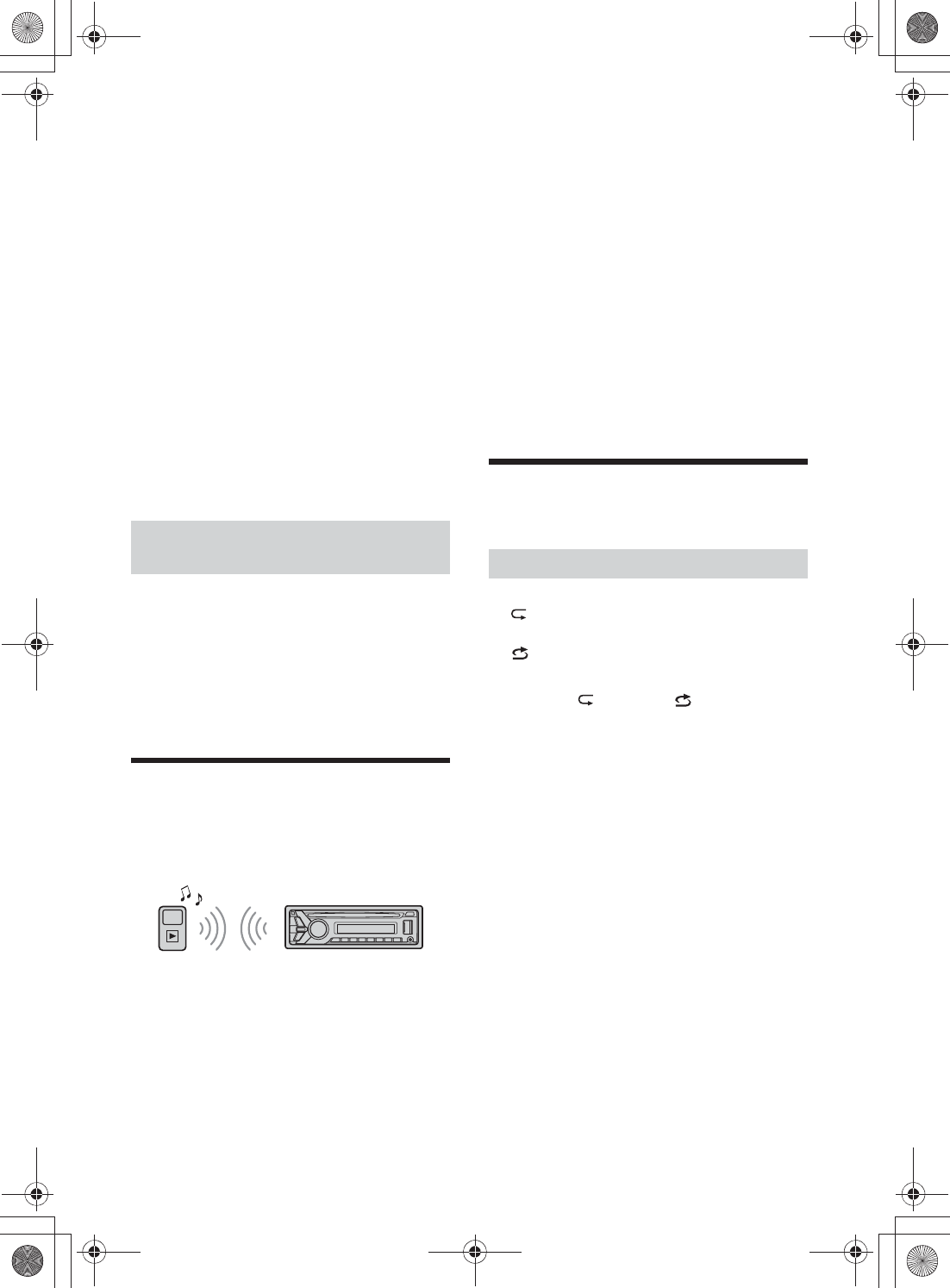
12ES
F:\yoshida\1115\4489688111\4489688111MEXN4000BTUC\02LaES-MEXN4000BTUC\040CD.fm masterpage: Left
MEX-N4000BT
4-489-688-11(1)
1Conecte el dispositivo iPod/USB al
puerto USB (página 9).
Se inicia la reproducción.
Si ya está conectado un dispositivo, para iniciar
la reproducción pulse SRC para seleccionar
[USB] ([IPD] aparece en la pantalla cuando se
reconoce el iPod).
2Ajuste el volumen de esta unidad.
Para detener la reproducción
Mantenga presionado OFF por un segundo.
Para extraer el dispositivo
Detenga la reproducción y extraiga el dispositivo.
Precaución para iPhone
Al conectar un iPhone mediante USB, el volumen
de las llamadas telefónicas es controlado por el
iPhone, y no por la unidad. Trate de no subir el
volumen de la unidad durante una llamada sin
darse cuenta, ya que puede producirse un sonido
fuerte y repentino al terminar la llamada.
Mantenga presionado MODE durante la
reproducción para que aparezca [MODE IPOD] y
habilitar la operación directamente en el iPod.
Tenga en cuenta que solamente es posible ajustar
el volumen en la unidad.
Para salir del modo de control de pasajero
Mantenga presionado MODE para que aparezca
[MODE AUDIO].
Reproducción de un dispositivo
BLUETOOTH
Puede reproducir contenido en un dispositivo
conectado que sea compatible con BLUETOOTH
A2DP (Perfil de distribución de audio avanzado).
1Haga una conexión BLUETOOTH con el
dispositivo de audio (página 7).
2Presione SRC para seleccionar
[BT AUDIO].
3Para comenzar la reproducción, utilice
las funciones del dispositivo de audio.
4Ajuste el volumen de esta unidad.
Notas
ˎEn función del dispositivo de audio, es posible que no
se muestre en esta unidad cierta información como,
por ejemplo, el título, el número de pista y la duración
y el estado de la reproducción.
ˎIncluso si se cambia la fuente en la unidad, la
reproducción de la señal del dispositivo de audio no
se interrumpe.
ˎ[BT AUDIO] no aparece en la pantalla mientras se
ejecuta la aplicación “App Remote” mediante la
función BLUETOOTH.
Para hacer coincidir el nivel de volumen del
dispositivo BLUETOOTH con otras fuentes
Comience la reproducción del dispositivo de audio
portátil BLUETOOTH en un nivel moderado y
configure su nivel habitual de volumen en la
unidad.
Presione MENU y gire el selector de control.
Seleccione [SOUND] q [BTA VOL] (página 20).
Búsqueda y reproducción de
pistas
1Durante la reproducción, presione
(repetir), para seleccionar
reproducción repetida, o
(reproducción aleatoria) para
reproducción aleatoria.
2Presione (repetir) o (repetición
aleatoria) varias veces para elegir el
modo deseado.
Es posible que la reproducción en el modo de
reproducción seleccionado se demore en iniciar.
Los modos de reproducción disponibles varían en
función de la fuente de sonido seleccionada.
Utilización directa del iPod (Control de
pasajero) Reproducción repetida y aleatoria
010COV.book Page 12 Friday, November 15, 2013 11:49 AM
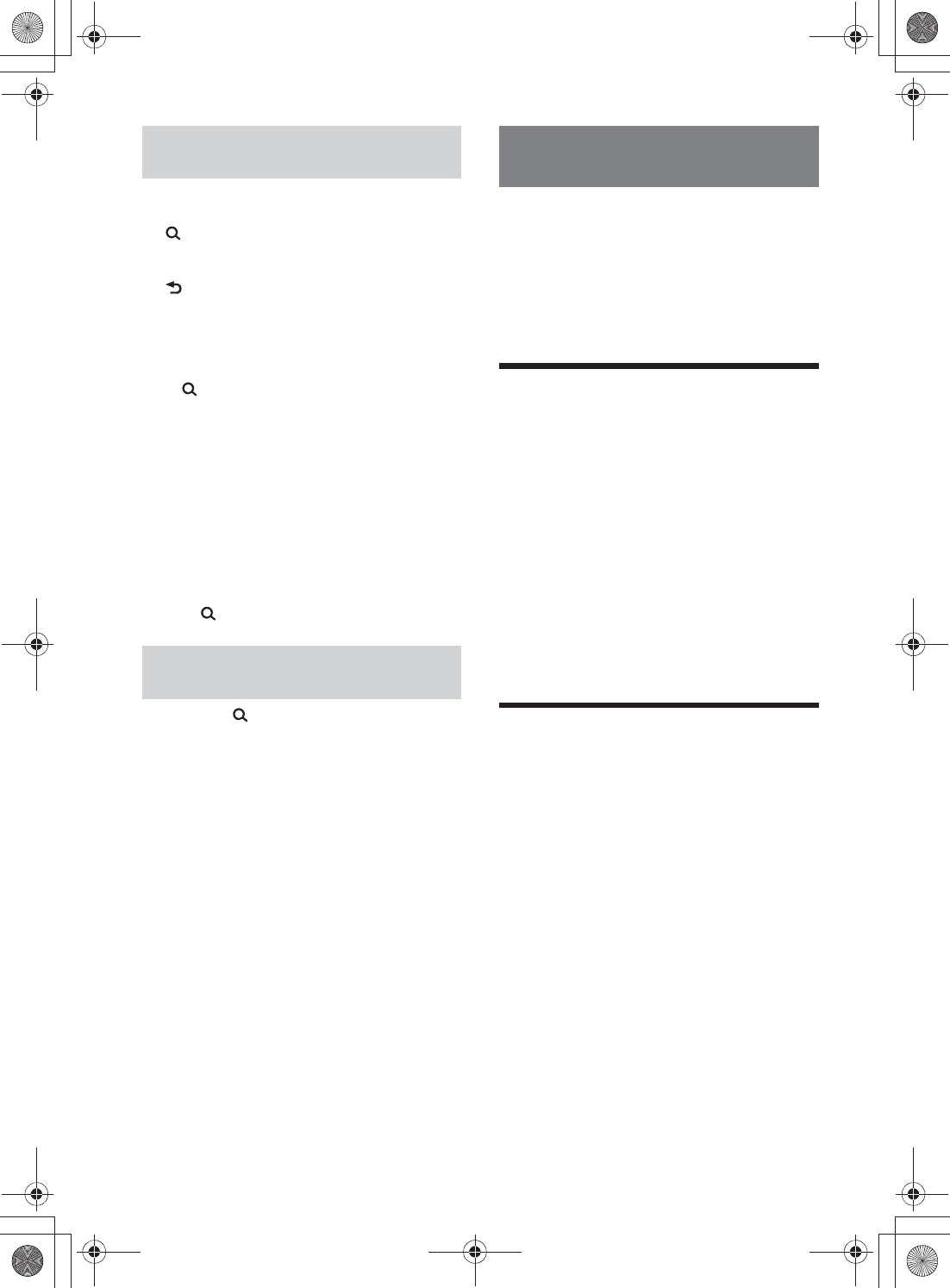
13ES
F:\yoshida\1115\4489688111\4489688111MEXN4000BTUC\02LaES-MEXN4000BTUC\040CD.fm masterpage: Right
MEX-N4000BT
4-489-688-11(1)
1Durante la reproducción de equipos de
audio de CD, USB o BT*1, presione
(navegar)*2 para mostrar la lista de
categorías de búsqueda.
Cuando aparece la lista de pistas, presione
(volver) repetidamente hasta que aparezca
la categoría de búsqueda deseada.
*1 Disponible solo para equipos de audio
compatibles con AVRCP (Perfil de control remoto
de audio y video) 1.4 o posteriores.
*2 Durante la reproducción USB, presione
(navegar) durante más de 2 segundos para
volver directamente al inicio de la lista de
categorías.
2Gire el selector de control para
seleccionar la categoría de búsqueda
deseada y, a continuación, presiónelo
para confirmarla.
3Repetir el paso 2 para buscar la pista
deseada.
Se inicia la reproducción.
Para salir del modo Quick-BrowZer
Presione (navegar).
1Presione (navegar).
2Presione SEEK +.
3Gire el selector de control para
seleccionar el elemento.
Se realizan omisiones en pasos del 10 % de la
cantidad total de elementos presentes en la
lista.
4Presione ENTER para volver al modo
Quick-BrowZer.
Aparecerá el elemento seleccionado.
5Gire el selector de control para
seleccionar el elemento deseado y, a
continuación, presiónelo.
Se inicia la reproducción.
Pandora® está disponible para reproducir música a
través de su Android™, teléfonos BlackBerry® y
iPhone. Podrá controlar Pandora® desde un iPhone
conectado por USB o desde un teléfono Android/
BlackBerry conectado por BLUETOOTH desde esta
unidad.
El servicio Pandora® no está disponible en algunos
países/regiones.
Preparación para Pandora®
1Para verificar los dispositivos
compatibles, visite el sitio de soporte
técnico en la contratapa.
2Descargue la última versión de la
aplicación Pandora® desde la tienda de
aplicaciones de su teléfono inteligente.
Puede encontrar una lista de los
dispositivos compatibles en
www.pandora.com/everywhere/mobile
Para teléfonos Android solamente
No puede controlar Pandora® a través de la función
BLUETOOTH mientras ejecuta la aplicación “App
Remote” a través de BLUETOOTH.
Transmisión de Pandora®
1Conecte esta unidad con el dispositivo
móvil.
ˎiPhone a través de USB (página 9)
ˎTeléfono Android/BlackBerry a través de la
función BLUETOOTH (página 7)
2Presione SRC para seleccionar
[PANDORA USB] o [BT PANDORA].
3Abra la aplicación Pandora® en el
dispositivo móvil.
4Presione PAUSE para comenzar la
reproducción.
Si aparece el número de dispositivo
Asegúrese de que aparezcan los mismos números
(por ejemplo, 123456) en esta unidad y en el
dispositivo móvil, luego presione ENTER en esta
unidad y seleccione [Sí] en el dispositivo móvil.
Búsqueda de una pista por nombre
(Quick-BrowZer™)
Búsqueda por salteo de elementos
(Modo de omisión)
Escuchar a Pandora®
010COV.book Page 13 Friday, November 15, 2013 11:49 AM
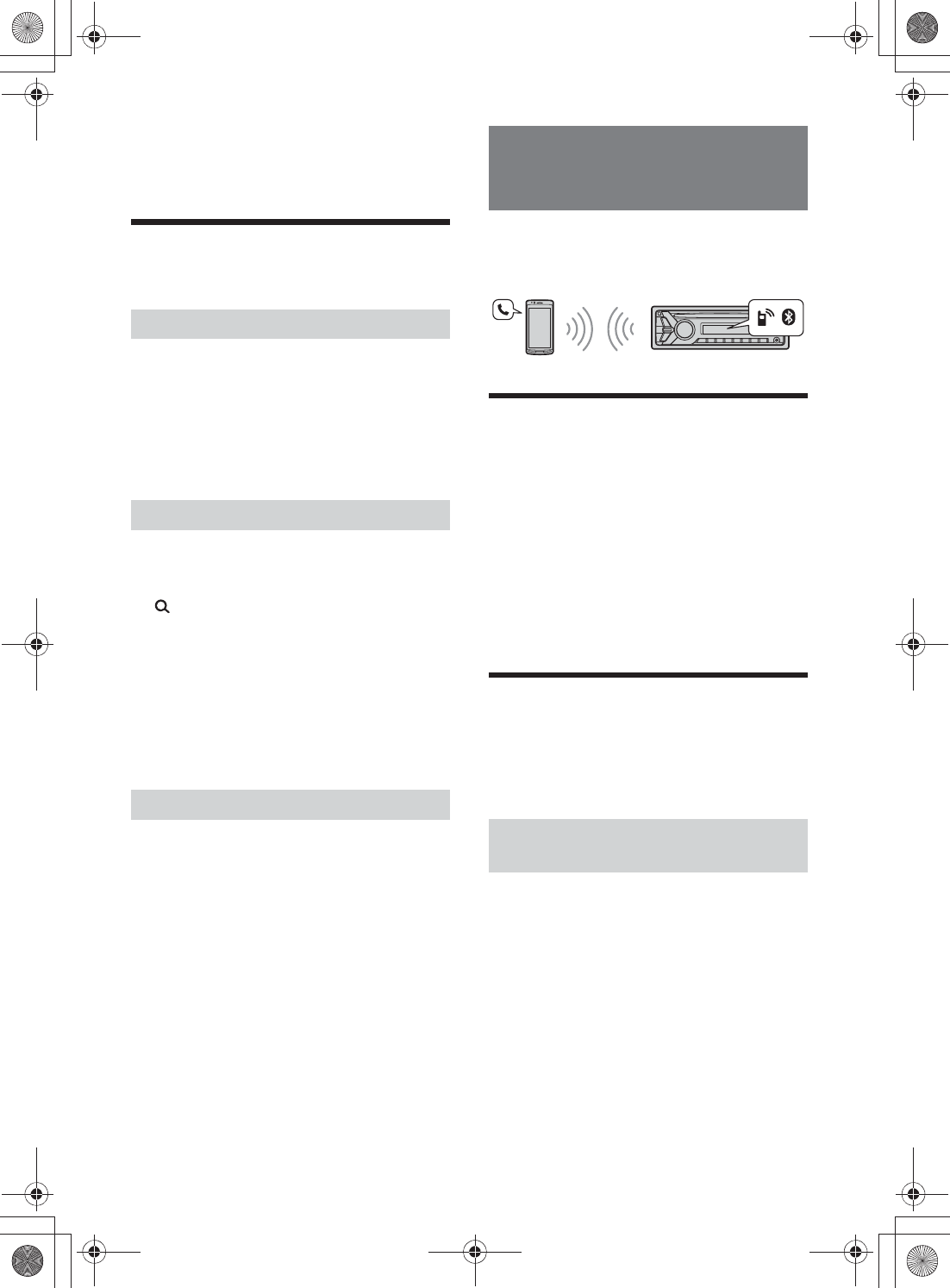
14ES
F:\yoshida\1115\4489688111\4489688111MEXN4000BTUC\02LaES-MEXN4000BTUC\040CD.fm masterpage: Left
MEX-N4000BT
4-489-688-11(1)
Cuando activa la función BLUETOOTH
Puede ajustar el nivel de volumen.
Presione MENU y gire el selector de control.
Seleccione [SOUND] q [BTA VOL] (página 20).
Operaciones disponibles en
Pandora®
Los comentarios de “pulgares arriba” o “pulgares
abajo” le permiten personalizar las emisoras.
Pulgares arriba
Durante la reproducción, toque Ă.
Pulgares abajo
Durante la reproducción, toque è.
La lista de emisoras le permite elegir con facilidad
la emisora deseada.
1Durante la reproducción, presione
(navegar).
2Presione SEEK + para seleccionar el
orden de clasificación [BY DATE] o
[A TO Z].
3Gire el selector de control para
seleccionar la estación deseada, luego
presiónelo.
Comienza la reproducción.
La pista o el artista que se esté reproduciendo en el
momento puede ser seleccionado como favorito y
almacenado en su cuenta Pandora®.
1Durante la reproducción, mantenga
presionado MODE hasta que aparezca
[BOOKMARK].
2Gire el selector de control para
seleccionar [TRK] (pista) o [ART] (artista),
luego presiónelo.
Para usar un teléfono celular, conéctelo a esta
unidad. Para obtener más información, consulte
“Preparación del dispositivo BLUETOOTH”
(página 7).
Rechazo de llamadas
1Presione CALL cuando reciba una
llamada con un tono de llamada.
Comienza la llamada telefónica.
Nota
El tono de llamada y la voz del auricular solo salen de
los altavoces frontales.
Para rechazar la llamada
Mantenga presionado OFF por un segundo.
Para finalizar una llamada
Presione CALL nuevamente.
Realización de llamadas
Puede realizar una llamada desde la libreta de
direcciones o desde el historial de llamadas cuando
un teléfono celular que sea compatible con PBAP
(Perfil de acceso a la agenda telefónica) esté
conectado.
1Presione CALL, gire el selector de control
para seleccionar [PHONEBOOK] y, a
continuación, presiónelo.
2Gire el selector de control para
seleccionar una inicial de la lista de
iniciales y, a continuación, presiónelo.
3Gire el selector de control para
seleccionar un nombre de la lista de
nombres y, a continuación, presiónelo.
Comentarios de “pulgares”
Uso de la lista de emisoras
Selección de favoritos
Realización de llamadas con manos
libres
Realización de llamadas desde la
agenda telefónica
010COV.book Page 14 Friday, November 15, 2013 11:49 AM
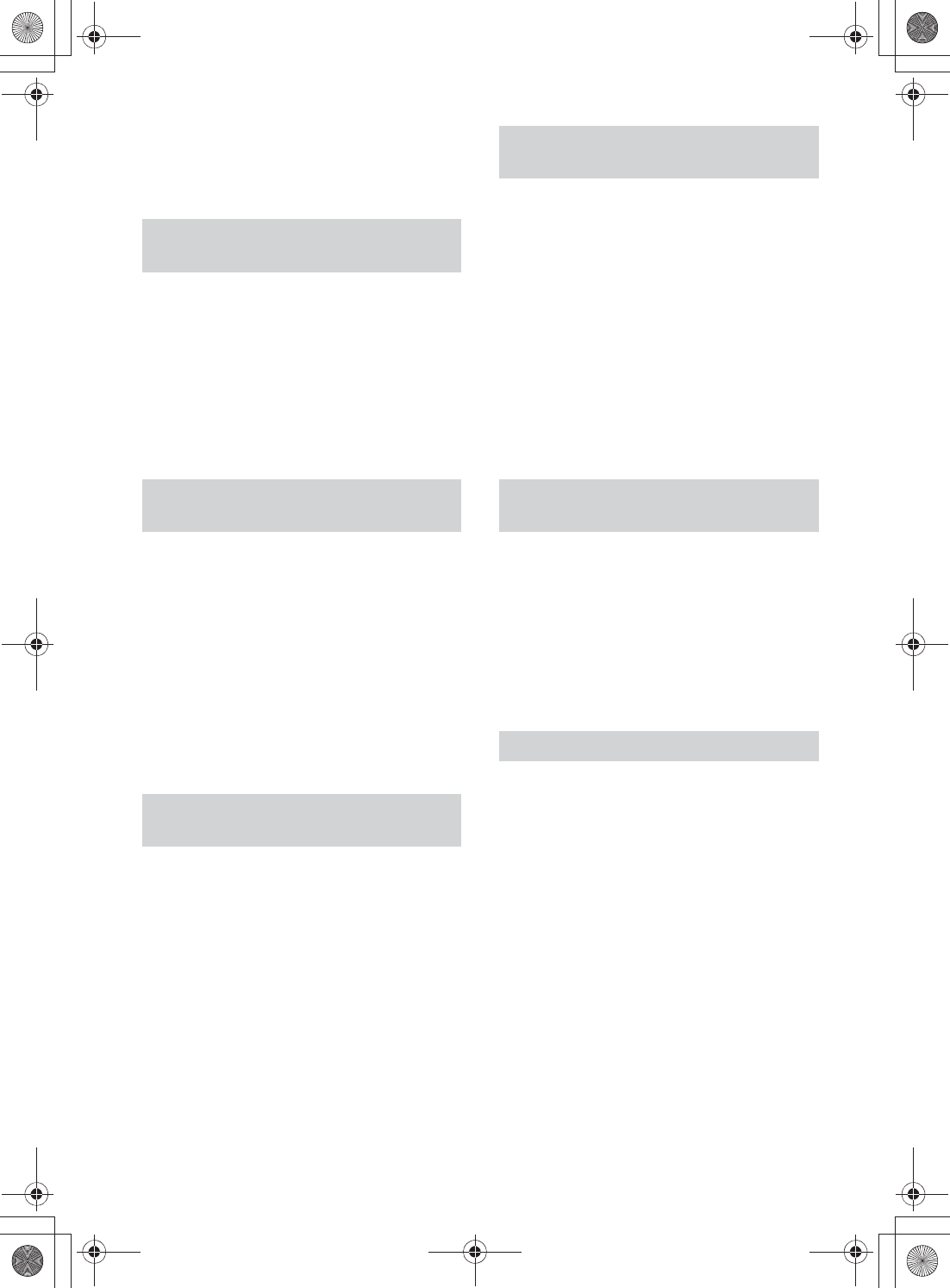
15ES
F:\yoshida\1115\4489688111\4489688111MEXN4000BTUC\02LaES-MEXN4000BTUC\040CD.fm masterpage: Right
MEX-N4000BT
4-489-688-11(1)
4Gire el selector de control para
seleccionar un número de la lista de
números y, a continuación, presiónelo.
Comienza la llamada telefónica.
1Presione CALL, gire el selector de control
para seleccionar [RECENT CALL] y, a
continuación, presiónelo.
Aparece una lista del historial de llamadas.
2Gire el selector de control para
seleccionar un nombre o un número
telefónico del historial de llamadas y, a
continuación, presiónelo.
Comienza la llamada telefónica.
1Presione CALL, gire el selector de control
para seleccionar [DIAL NUMBER] y, a
continuación, presiónelo.
2Gire el selector de control para ingresar
el número de teléfono y finalmente
seleccione [ ] (espacio), luego, presione
el botón ENTER*.
Comienza la llamada telefónica.
* Para mover la indicación digital, presione
SEEK +/–.
Nota
En la pantalla aparecerá [_] en lugar de [#] .
1Presione CALL, gire el selector de control
para seleccionar [REDIAL] y, a
continuación, presiónelo.
Comienza la llamada telefónica.
Es posible almacenar hasta 6 contactos en la
marcación preajustada.
1Seleccione un número de teléfono que
desee almacenar en la marcación
predefinida, de la agenda telefónica, el
historial de llamadas o bien ingresando
directamente el número.
El número de teléfono aparecerá en la pantalla
de esta unidad.
2Mantenga presionado un botón de
número (de 1 a 6) hasta que aparezca
[MEM].
El contacto se almacena en el número
preajustado que seleccione.
1Presione SRC, gire el selector de control
para seleccionar [BT PHONE], y, a
continuación, presiónelo.
2Presione un botón numérico (1 a 6) para
seleccionar el contacto al que desea
llamar.
3Presione ENTER.
Comienza la llamada telefónica.
Haga una llamada al decir la etiqueta de voz
almacenada en un teléfono celular conectado que
tenga una función de marcado por voz.
1Presione CALL, gire el selector de control
para seleccionar [VOICE DIAL] y, a
continuación, presiónelo.
Otra posibilidad es presionar ENTER mientras la
función App Remote se encuentra apagada.
2Mencione la etiqueta de voz almacenada
en el teléfono celular.
Se reconocerá su voz y se realizará la llamada.
Para cancelar el marcado por voz
Presione ENTER.
Realización de llamadas desde el
historial de llamadas
Realización de llamadas mediante la
introducción de un número de teléfono
Realización de llamadas mediante
repetición de marcado
Marcación predefinida de números
telefónicos
Realización de llamadas mediante
números preajustados
Llamada por etiquetas de voz
010COV.book Page 15 Friday, November 15, 2013 11:49 AM
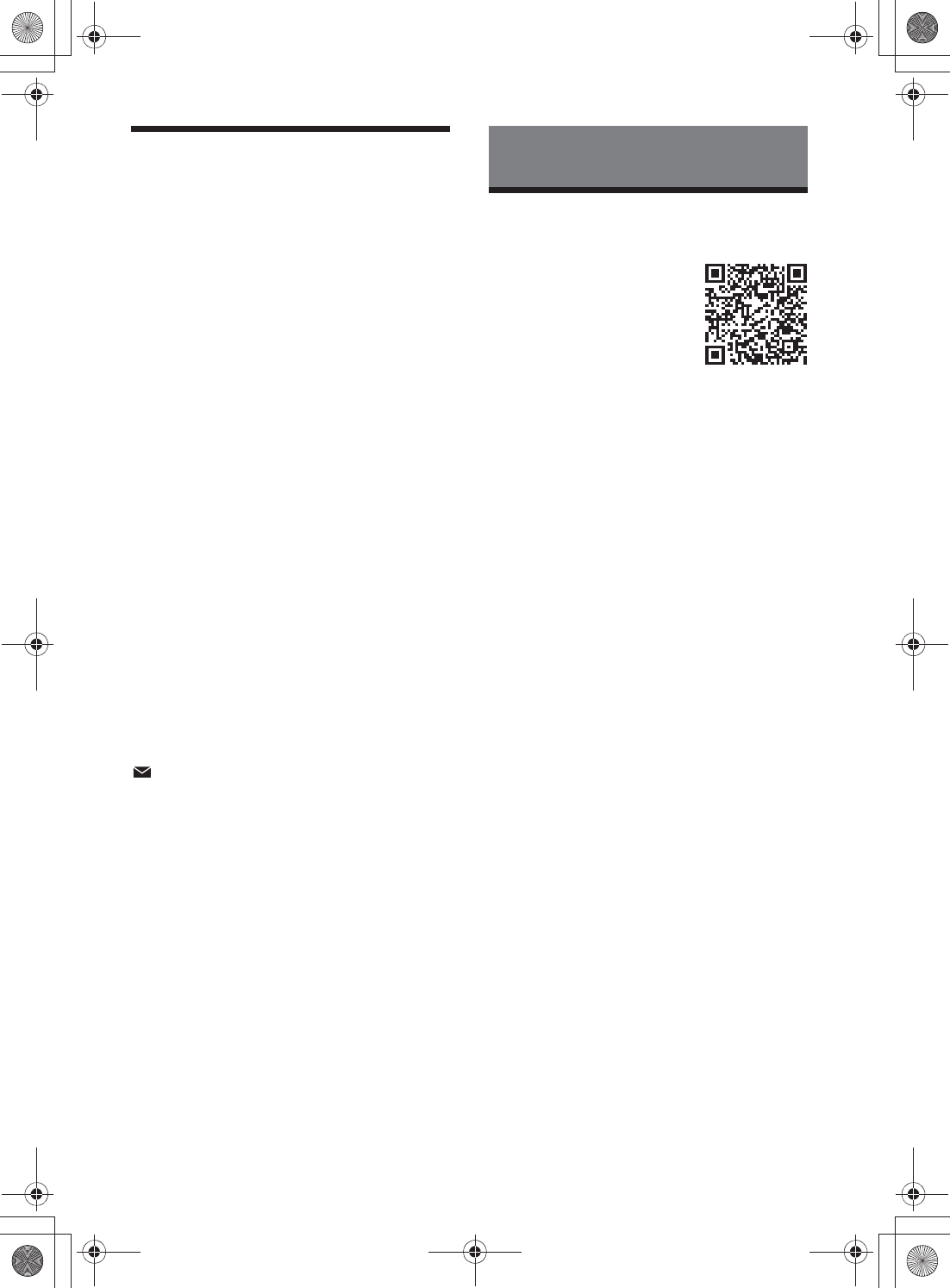
16ES
F:\yoshida\1115\4489688111\4489688111MEXN4000BTUC\02LaES-MEXN4000BTUC\040CD.fm masterpage: Left
MEX-N4000BT
4-489-688-11(1)
Tareas disponibles durante la
llamada
Para configurar previamente el volumen del
tono de llamada y del auricular
Puede configurar el volumen del tono de llamada y
del auricular.
Ajuste del volumen del tono de llamada:
Gire el selector de control mientras recibe la
llamada.
Ajuste del volumen del auricular:
Gire el selector de control durante una llamada.
Para ajustar el volumen para otra persona
(Ajuste de ganancia de micrófono)
Presione MIC.
Niveles de volumen ajustables: [MIC-LOW],
[MIC-MID], [MIC-HI].
Para reducir el eco y el ruido (Cancelador de
ecos/Modo cancelador de ruidos)
Mantenga presionado MIC.
Modo ajustable: [EC/NC-1], [EC/NC-2].
Para transferir una llamada
Para activar o desactivar el dispositivo correcto
(esta unidad o el teléfono celular), presione MODE o
use el teléfono celular.
Nota
En función del teléfono celular, es posible que la
conexión de manos libres se interrumpa al intentar
transferir una llamada.
Para revisar el estado de SMS y correo
electrónico*
parpadea cuando se recibe un nuevo mensaje
SMS o correo electrónico, y permanece iluminado
cuando hay mensajes no leídos.
* Solo disponible para teléfonos celulares compatibles
con MAP (Perfil de acceso a mensajes).
App Remote con iPhone/
teléfono con Android
Se requiere la descarga de la
aplicación “App Remote” desde
App Store para el iPhone o desde
Google Play para teléfonos
Android.
Mediante la aplicación “App
Remote”, las siguientes
características están disponibles:
ˋOperar la unidad para iniciar y controlar
aplicaciones compatibles en iPhone/teléfono
con Android.
ˋOperar el iPhone/teléfono con Android con
señales simples de dedos para controlar la
fuente de la unidad.
ˋIniciar una aplicación/fuente de audio o buscar
la palabra clave en la aplicación al decir una
palabra o frase en el micrófono (solo teléfonos
Android).
ˋLeer mensajes de texto entrantes, SMS, correo
electrónico, Twitter, Facebook, calendario, etc., y
se pueden responder los mensajes de texto, SMS
y correo electrónico automáticamente (solo
teléfonos Android).
ˋAjustar los parámetros del sonido (EQ10,
Balance/Fader, posición de escucha) de la
unidad a través de teléfonos iPhone/Android.
Notas
ˎPor su seguridad, cumpla con las regulaciones y leyes
de tráfico locales y no utilice la aplicación mientras
maneja.
ˎLas operaciones disponibles varían en función de la
aplicación. Para obtener más información sobre las
aplicaciones disponibles, visite el sitio web de
servicio técnico que se indica en la cubierta posterior.
ˎApp Remote ver. 2.0 mediante USB es compatible con
iPhones con iOS 5/iOS 6 instalados.
ˎApp Remote ver. 2.0 mediante BLUETOOTH es
compatible con dispositivos con Android que tengan
Android 2.2, 2.3, 3.*, 4.0, 4.1 o 4.2 instalados.
ˎEs posible que la función de reconocimiento de voz
no funcione dependiendo de su smartphone. En ese
caso, vaya a [Configuración], seleccione
[Reconocimiento de voz].
ˎLa lectura de SMS/correo electrónico/notificaciones
está disponible para dispositivos Android con motor
TTS instalado.
ˎLa aplicación “Smart Connect”, proporcionada por
Sony Mobile Communications, es necesaria para la
notificación de lectura de Twitter/Facebook/
calendario, etc.
Funciones útiles
010COV.book Page 16 Friday, November 15, 2013 11:49 AM
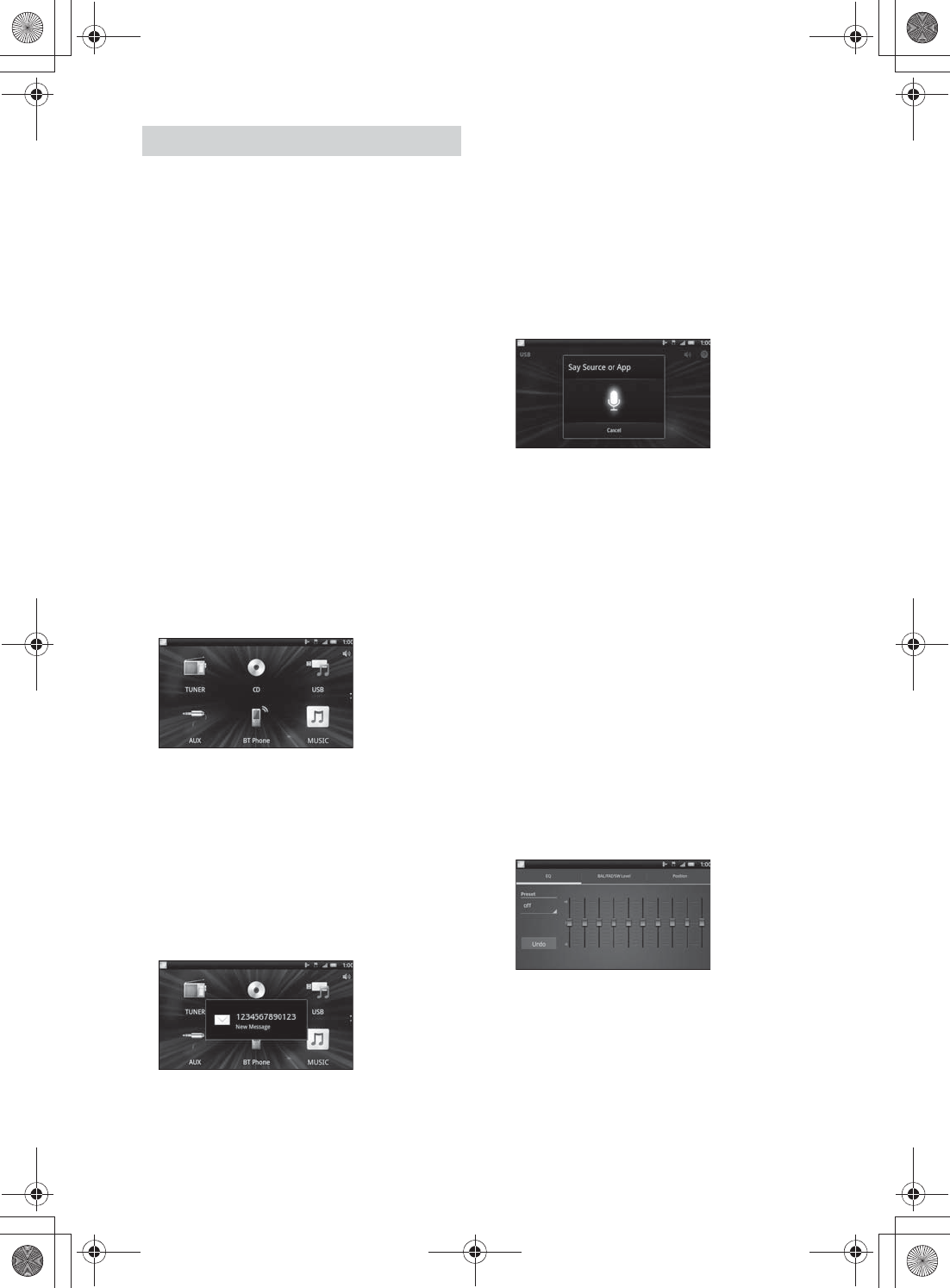
17ES
F:\yoshida\1115\4489688111\4489688111MEXN4000BTUC\02LaES-MEXN4000BTUC\040CD.fm masterpage: Right
MEX-N4000BT
4-489-688-11(1)
1Conecte el iPhone al puerto USB o el
teléfono Android con la función
BLUETOOTH.
2Inicie la aplicación “App Remote”.
3Mantenga presionado APP en la unidad
por más de 2 segundos.
Comienza la conexión con su iPhone/teléfono
con Android.
Para obtener más detalles acerca del
funcionamiento del iPhone/teléfono con
Android, consulte la ayuda de la aplicación.
Si aparece el número de dispositivo
Asegúrese de que se muestran los mismos
números (por ejemplo, 123456) en esta unidad y el
dispositivo móvil, luego presione ENTER en esta
unidad y seleccione [Sí] en el dispositivo móvil.
Para finalizar la conexión
Mantenga presionado APP.
Seleccionar la fuente o aplicación
Puede operar la unidad para seleccionar la fuente o
aplicación deseada en el smartphone.
1Gire el selector de control para seleccionar la fuente
o aplicación deseada, luego presiónela.
Para seleccionar otra fuente o aplicación, presione
SRC luego gire el selector de control para seleccionar
la fuente o aplicación deseada.
Anuncio de información variada a través
de guía de voz (solo para teléfono
Android)
Al recibir SMS/correo electrónico, notificaciones de
Twitter/Facebook/Calendario, etc., éstas se
anuncian automáticamente a través de los
parlantes del vehículo.
Para obtener más detalles acerca de las
configuraciones, consulte la ayuda de la aplicación.
Activar el reconocimiento de voz (solo
para teléfonos Android)
Al registrar las aplicaciones, puede controlarlas
mediante el comando de voz. Para obtener más
detalles, consulte la ayuda de la aplicación.
Para activar el reconocimiento de voz
1Presione ENTER para activar el reconocimiento de
voz.
2Cuando aparece [Say Source or App], en el teléfono
con Android, diga el comando de voz deseado en el
micrófono.
Notas
ˎEl reconocimiento de voz puede no encontrarse
disponible en algunos casos.
ˎEl reconocimiento de voz puede funcionar
incorrectamente según el rendimiento del teléfono
Android conectado.
ˎUtilizar en situaciones en las que ruido, como el de un
motor, sea mínimo durante el reconocimiento de voz.
ˎEl uso de un micrófono externo (no suministrado)
mejorará el reconocimiento de voz.
Al seleccionar una aplicación de música o
video*
Presione 1 o 2 para ingresar en modo HID, y
presione SEEK +/– para seleccionar un elemento de
reproducción, luego presione ENTER para comenzar
la reproducción.
* Solamente disponible para teléfono Android
compatible con HID (Perfil de dispositivo de interfaz
humana).
Establecer parámetros de sonido
Puede ajustar los parámetros de EQ, BAL/FAD/SW
Level y Position a través de su teléfono inteligente.
Para obtener más detalles acerca de las
configuraciones, consulte la ayuda de la aplicación.
Establecer la conexión App Remote
010COV.book Page 17 Friday, November 15, 2013 11:49 AM
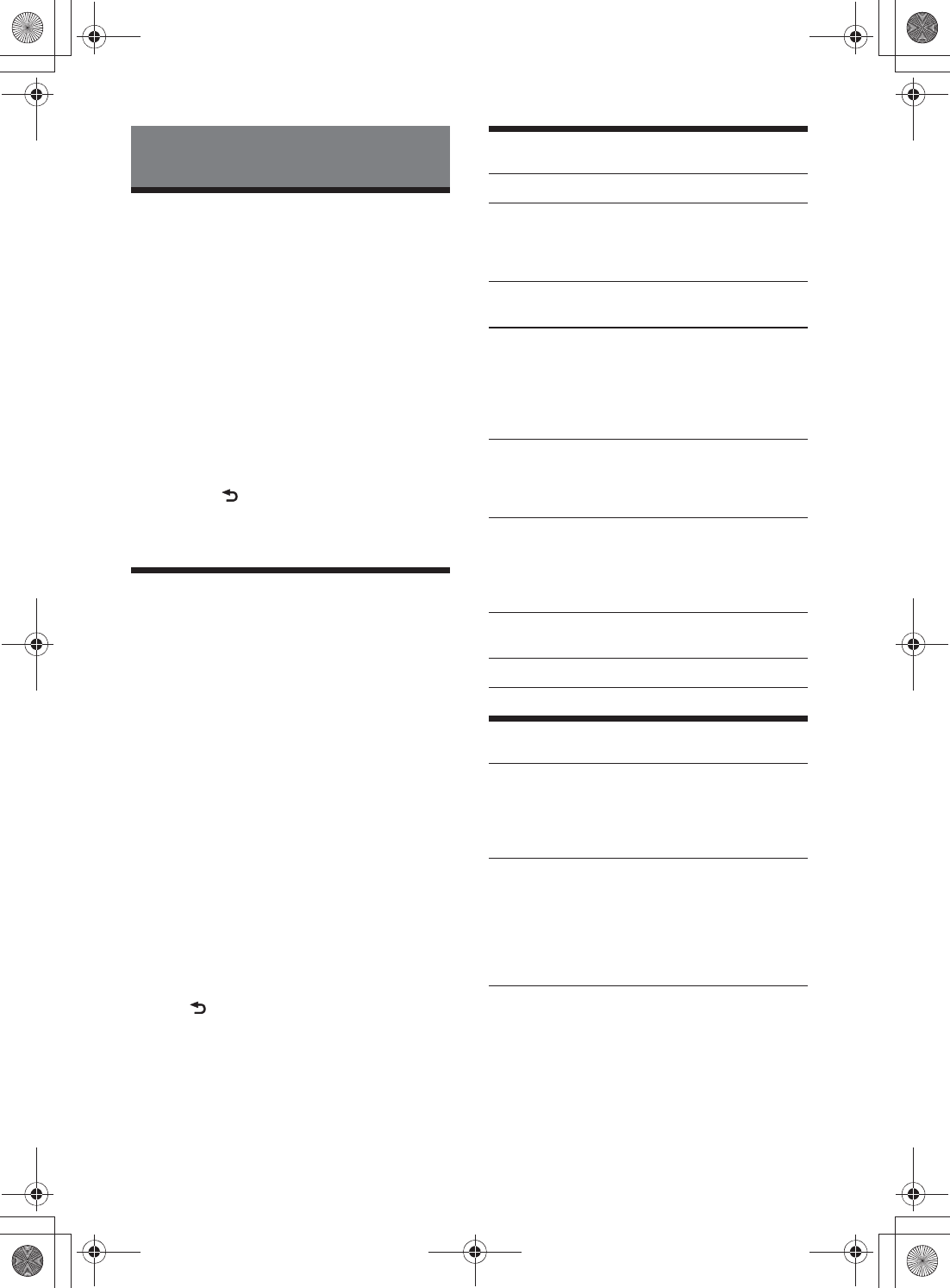
18ES
F:\yoshida\1115\4489688111\4489688111MEXN4000BTUC\02LaES-MEXN4000BTUC\040CD.fm masterpage: Left
MEX-N4000BT
4-489-688-11(1)
Cancelación del modo DEMO
Puede cancelar la pantalla de demostración que
aparece mientras la unidad está apagada.
1Presione MENU, gire el selector de
control para seleccionar [DISPLAY] y, a
continuación, presiónelo.
2Gire el selector de control para
seleccionar [DEMO] y, a continuación,
presiónelo.
3Gire el selector de control para
seleccionar [DEMO-OFF] y, a
continuación, presiónelo.
El ajuste finalizó.
4Presione (volver) dos veces.
La pantalla vuelve al modo de recepción/
reproducción normal.
Operación básica de ajustes
Puede ajustar los elementos en el menú con el
siguiente procedimiento.
Los siguientes elementos pueden ajustarse en
función de la fuente y de la configuración.
1Presione MENU.
2Gire el selector de control para
seleccionar la categoría de configuración
y, a continuación, presiónela.
Las categorías de configuración son las
siguientes:
ˎConfiguración GENERAL (página 18)
ˎConfiguración SOUND (página 18)
ˎConfiguración DISPLAY (página 20)
ˎConfiguración BT (BLUETOOTH) (página 20)
ˎConfiguración APP REM (App Remote)
(página 20)
3Gire el selector de control para
seleccionar las opciones y, a
continuación, presiónelas.
Para volver a la pantalla anterior
Presione (volver).
Configuración GENERAL
CLOCK-ADJ (Ajuste del reloj) (página 7)
CAUT ALM (Alarma de precaución) (página 7)
Activa la alarma de precaución: [ON], [OFF].
(Solamente está disponible cuando la unidad
está apagada.)
BEEP
Activa el sonido de los pitidos: [ON], [OFF].
AUTO OFF
Permite apagar la alimentación
automáticamente una vez transcurrido un
período deseado cuando la unidad está
apagada: [NO], [30S] (30 segundos), [30M]
(30 minutos), [60M] (60 minutos).
AUX-A (Audio AUX)
Activa la pantalla de fuente AUX: [ON], [OFF].
(Solamente está disponible cuando la unidad
está apagada.)
REAR/SUB
Permite cambiar la salida de audio: [SUB-OUT]
(altavoz potenciador de graves), [REAR-OUT]
(amplificador de potencia). (Solamente está
disponible cuando la unidad está apagada.)
CT (Hora del reloj) (página 11)
Activa la función CT: [ON], [OFF].
BTM (página 10)
Configuración SOUND
C.AUDIO+ (sonido nítido+)
Reproduce el sonido al optimizar la señal digital
con los ajustes de sonido recomendados por
Sony: [ON], [OFF]. (Se cambia automáticamente
a [OFF] cuando se modifica [EQ10 PRESET]).
EQ10 PRESET
Selecciona una curva ecualizadora de 10 curvas
ecualizadoras o de: [R AND B], [ROCK], [POP],
[DANCE], [HIP-HOP], [ELECTRONICA], [JAZZ],
[SOUL], [COUNTRY], [CUSTOM], [OFF].
El ajuste de la curva de ecualizador se puede
memorizar para cada fuente.
EQ10 SETTING
Ajuste [CUSTOM] de EQ10.
BASE
Selecciona una curva ecualizadora
preestablecida como base para futuros ajustes:
[BAND1] 32 Hz, [BAND2] 63 Hz, [BAND3] 125 Hz,
[BAND4] 250 Hz, [BAND5] 500 Hz, [BAND6] 1 kHz,
[BAND7] 2 kHz, [BAND8] 4 kHz, [BAND9] 8 kHz,
[BAND10] 16 kHz.
Ajustes
010COV.book Page 18 Friday, November 15, 2013 11:49 AM
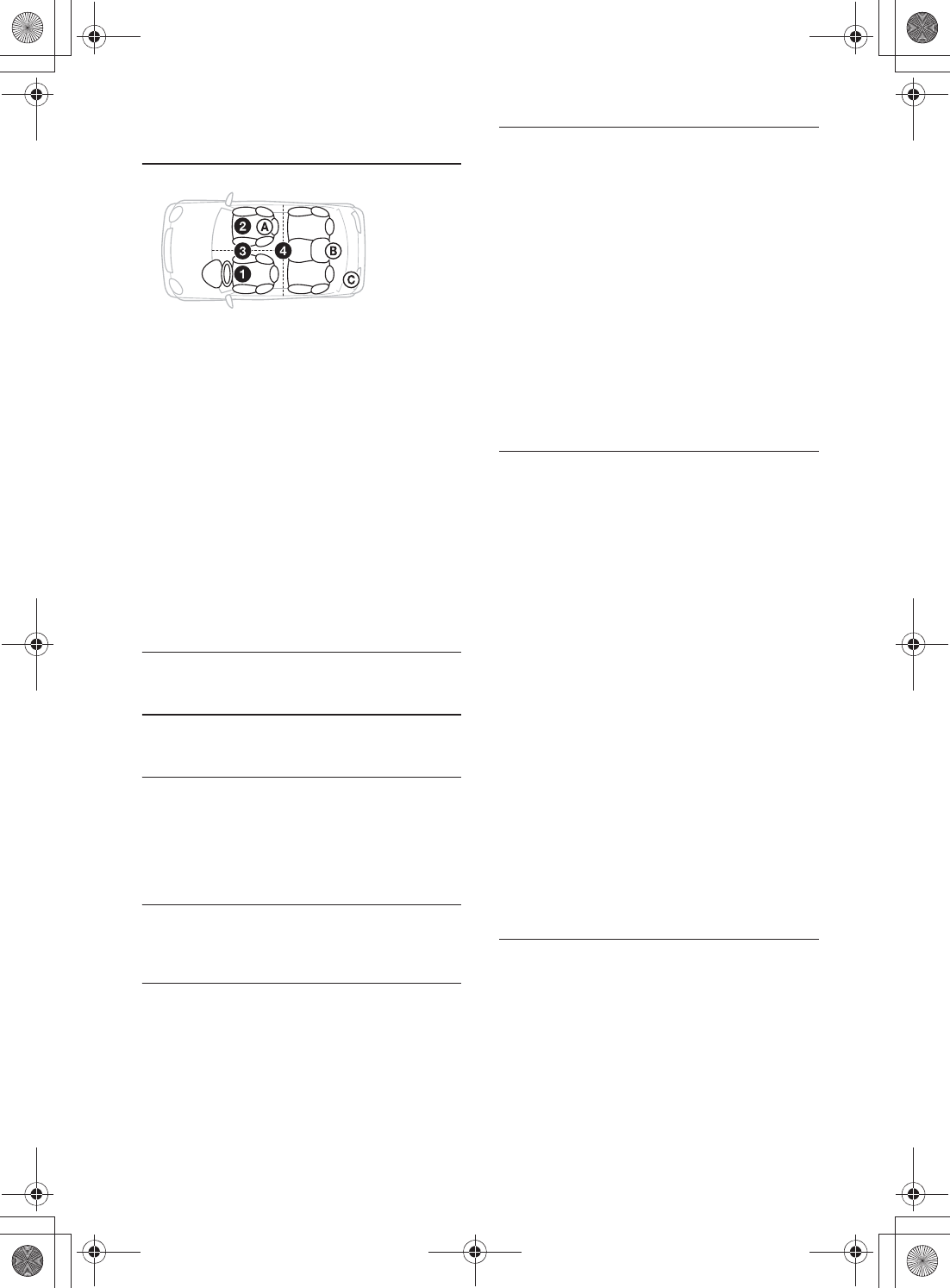
19ES
F:\yoshida\1115\4489688111\4489688111MEXN4000BTUC\02LaES-MEXN4000BTUC\040CD.fm masterpage: Right
MEX-N4000BT
4-489-688-11(1)
El nivel de volumen puede ajustarse en
intervalos de 1 dB entre -6 dB y +6 dB.
POSITION (posición de escucha)
SET F/R POS (configurar la posición frontal/
posterior)
Simula un campo de sonido natural mediante el
retardo de la salida de sonido desde los
altavoces frontales/posteriores para adecuarse
a su posición.
FRONT L (ɞ): izquierda delantera
FRONT R (ɟ): derecha delantera
FRONT (ɠ): delantera central
ALL (ɡ): en el centro del automóvil
CUSTOM: Posición configurada por App Remote
OFF: sin configuración de posición
ADJ POSITION* (ajustar posición)
Sintoniza con mayor precisión el ajuste de la
posición de escucha.
Rango ajustable: [+3] – [CENTER] – [-3].
SET SW POS* (ajuste de la posición subwoofer)
NEAR (ʭ): cerca
NORMAL (ʮ): normal
FAR (ʯ): lejos
BALANCE
Permite ajustar el balance de sonido: [RIGHT-15]
– [CENTER] – [LEFT-15].
FADER
Permite ajustar el nivel relativo: [FRONT-15] –
[CENTER] – [REAR-15].
DSEE (motor potenciador de sonido digital)
Mejora el sonido comprimido digitalmente, ya
que restaura las altas frecuencias que se pierden
en el proceso de compresión.
Este ajuste se puede memorizar para cada
fuente diferente al sintonizador.
Selecciona el modo DSEE: [ON], [OFF].
LOUDNESS
Refuerza los graves y agudos para obtener un
sonido claro a niveles de volumen bajos: [ON],
[OFF].
AAV (volumen automático avanzado)
Ajuste el nivel de volumen de reproducción de
todas las fuentes de reproducción al nivel
óptimo: [ON], [OFF].
RB ENH (Potenciador posterior de sonidos graves)
El Potenciador de sonidos graves posteriores
mejora los sonidos graves, ya que aplica el
ajuste del filtro de paso bajo a los altavoces
posteriores. Esta función permite que los
altavoces posteriores funcionen como altavoces
potenciadores de graves si uno de ellos no está
conectado. (Disponible solo cuando [SW DIRECT]
está configurado en [OFF]).
RBE MODE (modo Potenciador posterior de
sonidos graves)
Selecciona el potenciador posterior de sonidos
graves: [1], [2], [3], [OFF].
LPF FREQ (Frecuencia de filtro de bajo paso)
Selecciona la frecuencia de corte del altavoz
potenciador de graves: [50Hz], [60Hz], [80Hz],
[100Hz], [120Hz].
LPF SLOP (Pendiente de filtro de bajo paso)
Selecciona la pendiente LPF: [1], [2], [3].
SW DIREC (Conexión directa al altavoz potenciador
de graves)
Puede utilizar el altavoz potenciador de graves
sin un amplificador de potencia cuando está
conectado al cable del altavoz posterior.
(Disponible solo cuando [RBE MODE] está
configurado en [OFF]).
Asegúrese de conectar un altavoz potenciador
de graves de 4 a 8 Ω a cualquiera de los cables
del altavoz posterior. No conecte un altavoz al
otro cable de altavoz posterior.
SW MODE (Modo del altavoz potenciador de
graves)
Selecciona el modo del altavoz potenciador de
graves: [1], [2], [3], [OFF].
SW PHASE (Fase de altavoz potenciador de
graves)
Selecciona la fase del altavoz potenciador de
graves: [NORM], [REV].
SW POS* (Posición del altavoz potenciador de
graves)
Selecciona la posición del altavoz potenciador
de graves: [NEAR], [NORMAL], [FAR].
LPF FREQ (Frecuencia de filtro de bajo paso)
Selecciona la frecuencia de corte del altavoz
potenciador de graves: [50Hz], [60Hz], [80Hz],
[100Hz], [120Hz].
LPF SLOP (Pendiente de filtro de bajo paso)
Selecciona la pendiente LPF: [1], [2], [3].
S.WOOFER (altavoz potenciador de graves)
SW LEVEL (Nivel del altavoz potenciador de
graves)
Permite ajustar el nivel de volumen del altavoz
potenciador de graves: [+10 dB] – [0 dB] –
[-10 dB].
([ATT] aparece en pantalla con el ajuste más
bajo).
SW PHASE (Fase de altavoz potenciador de
graves)
Selecciona la fase del altavoz potenciador de
graves: [NORM], [REV].
010COV.book Page 19 Friday, November 15, 2013 11:49 AM
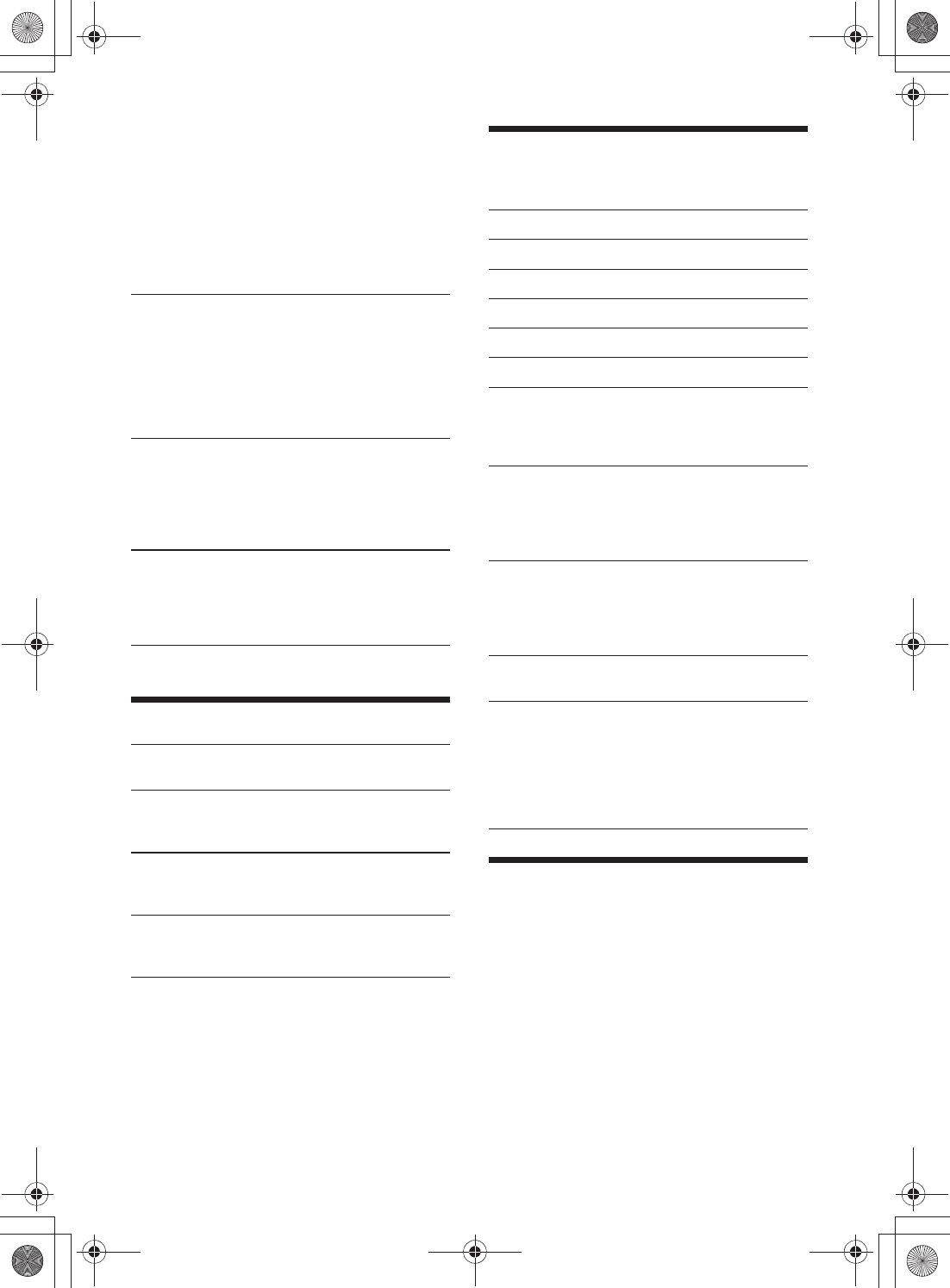
20ES
F:\yoshida\1115\4489688111\4489688111MEXN4000BTUC\02LaES-MEXN4000BTUC\040CD.fm masterpage: Left
MEX-N4000BT
4-489-688-11(1)
SW POS* (Posición del altavoz potenciador de
graves)
Selecciona la posición del altavoz potenciador
de graves: [NEAR], [NORMAL], [FAR].
LPF FREQ (Frecuencia de filtro de bajo paso)
Selecciona la frecuencia de corte del altavoz
potenciador de graves: [50Hz], [60Hz], [80Hz],
[100Hz], [120Hz].
LPF SLOP (Pendiente de filtro de bajo paso)
Selecciona la pendiente LPF: [1], [2], [3].
HPF (Filtro de paso alto)
HPF FREQ (Frecuencia de filtro de paso alto)
Permite seleccionar la frecuencia de corte: [OFF],
[50Hz], [60Hz], [80Hz], [100Hz], [120Hz].
HPF SLOP (Pista del filtro de paso alto)
Selecciona la pendiente HPF (efectivo solamente
cuando [HPF FREQ] se ajusta en un valor
diferente a [OFF]): [1], [2], [3].
AUX VOL (Nivel de volumen AUX)
Permite ajustar el nivel de volumen de cada
dispositivo auxiliar conectado: [+18 dB] – [0 dB] –
[-8 dB].
Este ajuste elimina la necesidad de ajustar el
nivel de volumen entre fuentes.
BTA VOL (nivel de volumen de audio BLUETOOTH)
Ajusta el nivel de volumen de cada equipo
BLUETOOTH conectado: [+6 dB] – [0 dB] – [-6 dB].
Este ajuste elimina la necesidad de ajustar el
nivel de volumen entre fuentes.
* No aparece cuando [SET F/R POS] se ajusta en [OFF].
Configuración DISPLAY
DEMO (Demostración)
Activa la demostración: [ON], [OFF].
DIMMER
Permite cambiar el brillo de la pantalla: [ON],
[OFF].
ILLUM (Iluminación)
Permite cambiar el color de la iluminación: [1],
[2].
AUTO SCR (Desplazamiento automático)
Permite desplazarse por los elementos de la
pantalla automáticamente: [ON], [OFF].
Configuración BT (BLUETOOTH)
Esta configuración también se puede abrir
presionando CALL.
PAIRING (página 7)
PHONEBOOK (página 14)
REDIAL (página 15)
RECENT CALL (página 15)
VOICE DIAL (página 15)
DIAL NUMBER (página 15)
RINGTONE
Selecciona si esta unidad o el teléfono celular
conectado emite el tono de llamadas: [1] (esta
unidad), [2] (teléfono celular).
AUTO ANS (respuesta automática)
Ajusta la unidad para que responda
automáticamente una llamada entrante: [OFF],
[1] (aproximadamente 3 segundos), [2]
(aproximadamente 10 segundos).
AUTO PAIRING
Enciende el BLUETOOTH emparejándose
automáticamente cuando el dispositivo iOS
versión 5.0, o posterior, está conectado
mediante USB: [ON], [OFF].
BT SIGNL (Señal BLUETOOTH) (página 8)
Activa la función BLUETOOTH: [ON], [OFF].
BT INIT (Inicialización de la tecnología BLUETOOTH)
Inicia todos los ajustes relacionados con
BLUETOOTH (información de emparejamiento,
número predefinido, información de dispositivo,
etc.).
Cuando se desecha la unidad, se inicializan
todos los ajustes.
Configuración APP REM (App
Remote)
Establece y termina la función App Remote
(conexión).
010COV.book Page 20 Friday, November 15, 2013 11:49 AM
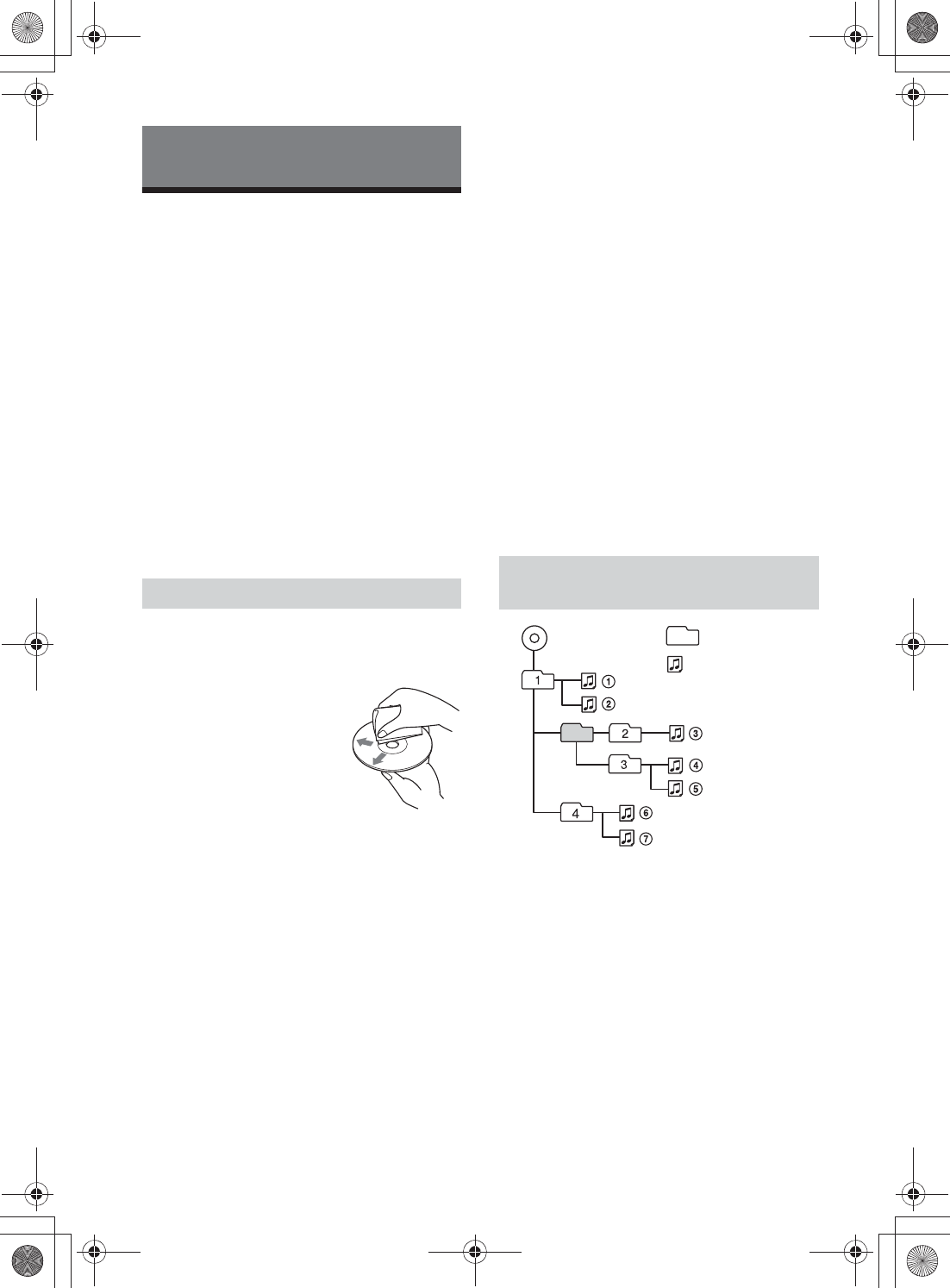
21ES
F:\yoshida\1115\4489688111\4489688111MEXN4000BTUC\02LaES-MEXN4000BTUC\040CD.fm masterpage: Right
MEX-N4000BT
4-489-688-11(1)
Precauciones
ˎDeje que la unidad se enfríe antes de usarla si el
automóvil ha estado estacionado bajo la luz
directa del sol.
ˎNo deje el panel frontal o los dispositivos de
audio dentro del vehículo o podría causar fallas
en el funcionamiento debido a las altas
temperaturas bajo la luz directa del sol.
ˎLa antena de alimentación se extiende
automáticamente.
Condensación de humedad
Si se produce condensación de humedad en el
interior de la unidad, extraiga el disco y espere una
hora aproximadamente hasta que se haya secado
por completo la unidad. De lo contrario, la unidad
no funcionará correctamente.
Para mantener sonido de alta calidad
No derrame ningún tipo de líquido sobre la unidad
o los discos.
ˎNo exponga los discos a la luz solar directa ni a
fuentes de calor como, por ejemplo, conductos
de aire caliente, ni los deje en el automóvil
estacionado bajo la luz solar directa.
ˎAntes de reproducir los
discos, límpielos con un paño.
Hágalo desde el centro hacia
los bordes. No utilice
disolventes como bencina,
diluyentes ni productos de
limpieza disponibles en el
mercado.
ˎEsta unidad se diseñó para
reproducir discos que cumplen con el estándar
Compact disc (CD). Los DualDisc y otros discos de
música codificados con tecnologías de protección
de derechos de autor no cumplen el estándar
Compact disc (CD), por lo que no podrán
reproducirse con esta unidad.
ˎDiscos que NO se pueden reproducir en esta
unidad
ˋDiscos con etiquetas, autoadhesivos o cinta
adhesiva o papeles adheridos. Si utiliza este
tipo de discos, puede provocar una falla de
funcionamiento o dañar el disco.
ˋDiscos con formas no estandarizadas (por
ejemplo, formas de corazón, cuadrado o
estrella). Si lo intenta, puede dañar la unidad.
ˋDiscos de 8 cm.
Notas sobre los discos CD-R/CD-RW
ˎNúmero máximo de: (solamente CD-R/CD-RW)
ˋcarpetas (álbumes): 150 (incluida la carpeta
raíz)
ˋarchivos (pistas) y carpetas: 300 (si los nombres
de carpeta o archivo contienen muchos
caracteres, este número puede ser inferior a
300)
ˋcaracteres que se pueden visualizar en el
nombre de una carpeta o archivo: 32 (Joliet)/
64 (Romeo)
ˎSi un disco multisesión empieza con una sesión
CD-DA, se reconoce como un disco CD-DA y las
otras sesiones no se reproducen.
ˎDiscos que NO se pueden reproducir en esta
unidad
ˋCD-R/CD-RW de calidad de grabación
deficiente.
ˋCD-R/CD-RW grabados con un dispositivo de
grabación no compatible.
ˋCD-R/CD-RW no finalizados correctamente.
ˋCD-R/CD-RW que no se hayan grabado en
formato CD de música o en formato MP3 que
cumpla la norma ISO9660 Nivel 1/Nivel 2, Joliet/
Romeo o multisesión.
Información complementaria
Notas sobre los discos
Orden de reproducción de los archivos
MP3/WMA
MP3/WMA Carpeta (álbum)
Archivo MP3/WMA
(pista)
010COV.book Page 21 Friday, November 15, 2013 11:49 AM
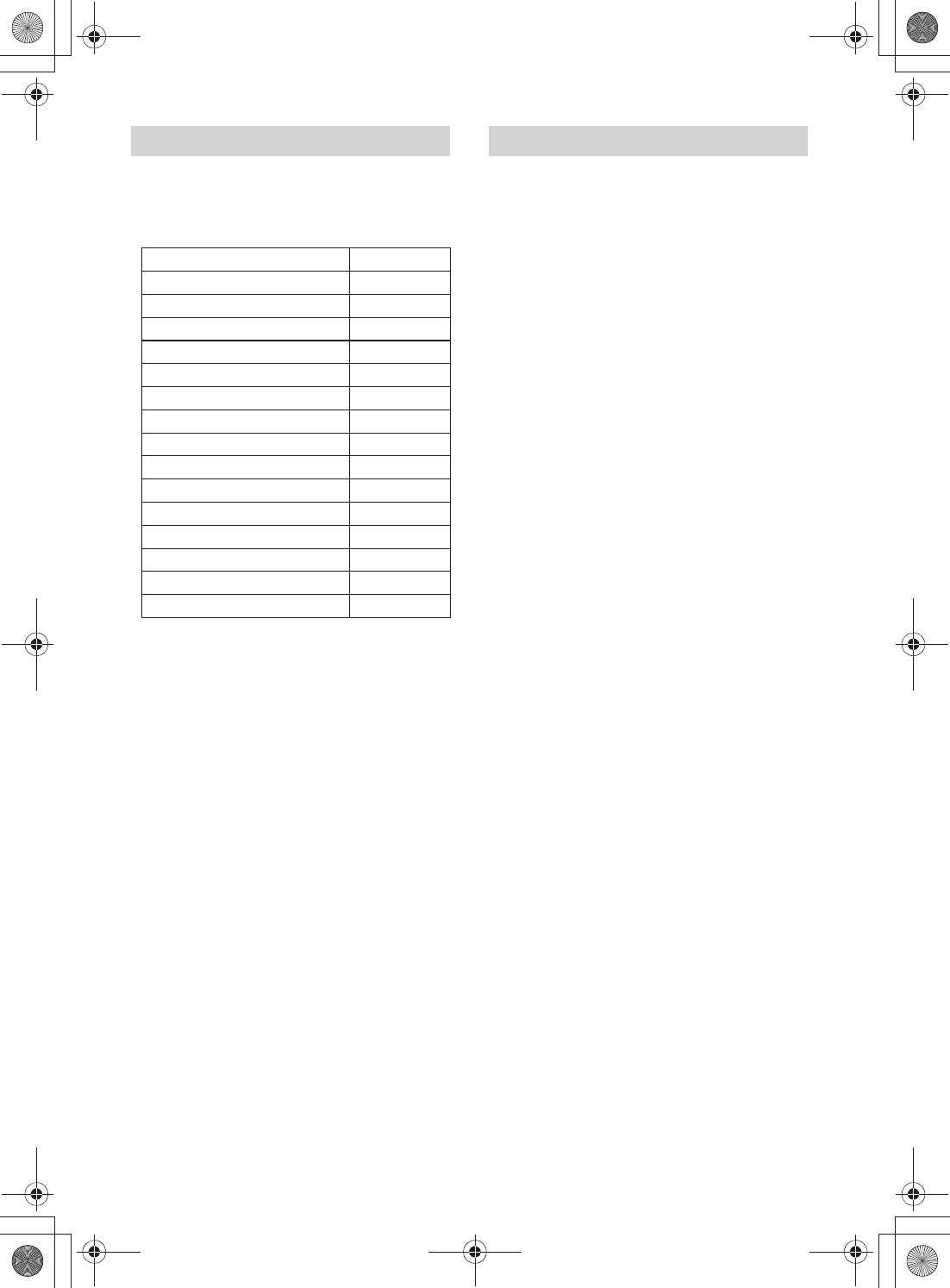
22ES
F:\yoshida\1115\4489688111\4489688111MEXN4000BTUC\02LaES-MEXN4000BTUC\040CD.fm masterpage: Left
MEX-N4000BT
4-489-688-11(1)
ˎPuede conectarse a los siguientes modelos de
iPod. Actualice sus dispositivos iPod a la última
versión de software antes de utilizarlos.
Modelos compatibles de iPhone/iPod
ˎ“Made for iPod” y “Made for iPhone” indican que
un accesorio electrónico se diseñó para
conectarse específicamente a los dispositivos
iPod o iPhone respectivamente, y que el
fabricante obtuvo la certificación necesaria para
que cumpla con los estándares de rendimiento de
Apple. Apple no se hace responsable del
funcionamiento de este dispositivo en
cumplimiento de los estándares de seguridad y
normativa. Tenga en cuenta que el uso de este
accesorio con el iPod o el iPhone puede afectar al
rendimiento inalámbrico.
¿Qué es la tecnología BLUETOOTH?
ˎLa tecnología inalámbrica BLUETOOTH es una
tecnología de corto alcance que permite la
comunicación inalámbrica de datos entre
dispositivos digitales, como un teléfono celular y
un auricular. La tecnología inalámbrica
BLUETOOTH tiene una cobertura de
aproximadamente 10 m. Lo habitual es conectar
dos dispositivos, aunque algunos dispositivos
pueden conectarse a varios dispositivos al mismo
tiempo.
ˎNo es necesario utilizar un cable para realizar la
conexión ya que la tecnología BLUETOOTH es
inalámbrica. Tampoco es necesario que los
dispositivos estén orientados entre sí, como
sucede con la tecnología infrarroja. Por ejemplo,
puede utilizar este tipo de dispositivos dentro de
una bolsa o un bolsillo.
ˎLa tecnología BLUETOOTH es un estándar
internacional admitido por millones de empresas
en todo el mundo y que utilizan varias compañías
a escala internacional.
Acerca de la comunicación BLUETOOTH
ˎLa tecnología inalámbrica BLUETOOTH tiene una
cobertura de aproximadamente 10 m.
El rango máximo de comunicación puede variar
de acuerdo con los obstáculos (personas,
metales, paredes, etc.) o el entorno
electromagnético.
ˎLas siguientes condiciones pueden afectar la
sensibilidad de la comunicación BLUETOOTH.
ˋLa existencia de obstáculos como, una persona,
un objeto metálico o una pared, entre esta
unidad y el dispositivo BLUETOOTH.
ˋEl uso de dispositivos que utilicen una
frecuencia de 2,4 GHz, como un dispositivo LAN
inalámbrico, un teléfono inalámbrico o un
microondas cerca de la unidad.
ˎComo los dispositivos BLUETOOTH y las redes LAN
inalámbricas (IEEE802.11b/g) utilizan la misma
frecuencia, pueden producirse interferencias de
microondas que provoquen el deterioro de la
velocidad de comunicación, la aparición de ruido
o una conexión no válida si la unidad se utiliza
cerca de un dispositivo LAN inalámbrico. En este
caso, realice el procedimiento siguiente.
ˋUtilice esta unidad a una distancia mínima de
10 m del dispositivo LAN inalámbrico.
ˋSi utiliza esta unidad a menos de 10 m de un
dispositivo LAN inalámbrico, apague el
dispositivo LAN inalámbrico.
ˋInstale esta unidad y el dispositivo BLUETOOTH
a la distancia más corta posible entre sí.
Acerca de iPod
Modelo compatible USB
iPhone 5 í
iPhone 4S í
iPhone 4 í
iPhone 3GS í
iPhone 3G í
iPod touch (5ª generación) í
iPod touch (4ª generación) í
iPod touch (3ª generación) í
iPod touch (2ª generación) í
iPod classic í
iPod nano (7ª generación) í
iPod nano (6ª generación) í
iPod nano (5ª generación) í
iPod nano (4ª generación) í
iPod nano (3ª generación) í
Acerca de la función BLUETOOTH
010COV.book Page 22 Friday, November 15, 2013 11:49 AM

23ES
F:\yoshida\1115\4489688111\4489688111MEXN4000BTUC\02LaES-MEXN4000BTUC\040CD.fm masterpage: Right
MEX-N4000BT
4-489-688-11(1)
ˎLas microondas que emite un dispositivo
BLUETOOTH pueden afectar el funcionamiento de
dispositivos médicos electrónicos. Apague esta
unidad y los demás dispositivos BLUETOOTH en
los lugares siguientes ya que podrían provocar un
accidente.
ˋLugares con presencia de gas inflamable,
hospitales, trenes, aviones o gasolineras
ˋLugares cerca de puertas automáticas o
alarmas de incendios
ˎEsta unidad admite recursos de seguridad que
cumplen con el estándar BLUETOOTH para
proporcionar una conexión segura al utilizar la
tecnología inalámbrica BLUETOOTH, pero es
posible que la seguridad sea insuficiente según el
ajuste. Tenga cuidado al realizar una
comunicación con la tecnología inalámbrica
BLUETOOTH.
ˎNo se aceptan responsabilidades por la pérdida
de información que pudiera producirse durante
una comunicación BLUETOOTH.
ˎNo se garantiza la comunicación con todos los
dispositivos BLUETOOTH.
ˋUn dispositivo que disponga de la función
BLUETOOTH debe cumplir el estándar
BLUETOOTH SIG y estar autenticado.
ˋIncluso en el caso de que el dispositivo
conectado cumpla el estándar BLUETOOTH
mencionado anteriormente, es posible que
algunos dispositivos no puedan conectarse o
funcionar correctamente, según las
características o las especificaciones del
dispositivo.
ˋMientras esté hablando con el manos libres del
teléfono, puede producirse ruido, según el
dispositivo o el entorno de comunicación.
ˎEn función del dispositivo que vaya a conectarse,
es posible que transcurra cierto tiempo antes de
que se inicie la comunicación.
Otros
ˎEs posible que el dispositivo BLUETOOTH no
funcione en teléfonos celulares según las
condiciones de las ondas de radio y la ubicación
en la que se utilice el equipo.
ˎSi no se siente cómodo después de utilizar el
dispositivo BLUETOOTH, deje de utilizarlo
inmediatamente. Si el problema persiste,
consulte con el distribuidor Sony más cercano.
Si desea realizar alguna consulta o solucionar algún
problema relativo a la unidad que no se trate en
este manual, póngase en contacto con el
distribuidor Sony más cercano.
Mantenimiento
Sustitución de la pila de litio del control
remoto
El alcance del control remoto disminuye a medida
que se agota la pila. Sustitúyala por una pila de litio
CR2025 nueva. El uso de cualquier otra pila podría
provocar un incendio o una explosión.
Notas sobre la pila de litio
ˎMantenga la pila de litio fuera del alcance de los
niños. Si se ingiriese, póngase en contacto
inmediatamente con un médico.
ˎLimpie la pila con un paño seco para garantizar un
contacto óptimo.
ˎAsegúrese de respetar la polaridad al instalarla.
ˎNo sujete la pila con pinzas metálicas, ya que podría
producirse un cortocircuito.
Limpieza de los conectores
Es posible que la unidad no funcione
correctamente si los conectores entre ésta y el
panel frontal están sucios. Para evitar esta
situación, extraiga el panel frontal (página 7) y
limpie los conectores con un hisopo de algodón.
Realice esta operación con suavidad. De lo
contrario, los conectores podrían resultar dañados.
Notas
ˎPor razones de seguridad, apague el motor antes de
limpiar los conectores y extraiga la llave del
interruptor de la llave de encendido.
ˎNo toque nunca los conectores directamente con los
dedos ni con ningún dispositivo metálico.
ADVERTENCIA
La pila puede explotar si no se emplea
adecuadamente.
No recargue la pila; tampoco la desmonte ni la
arroje al fuego.
Lado + hacia arriba
010COV.book Page 23 Friday, November 15, 2013 11:49 AM
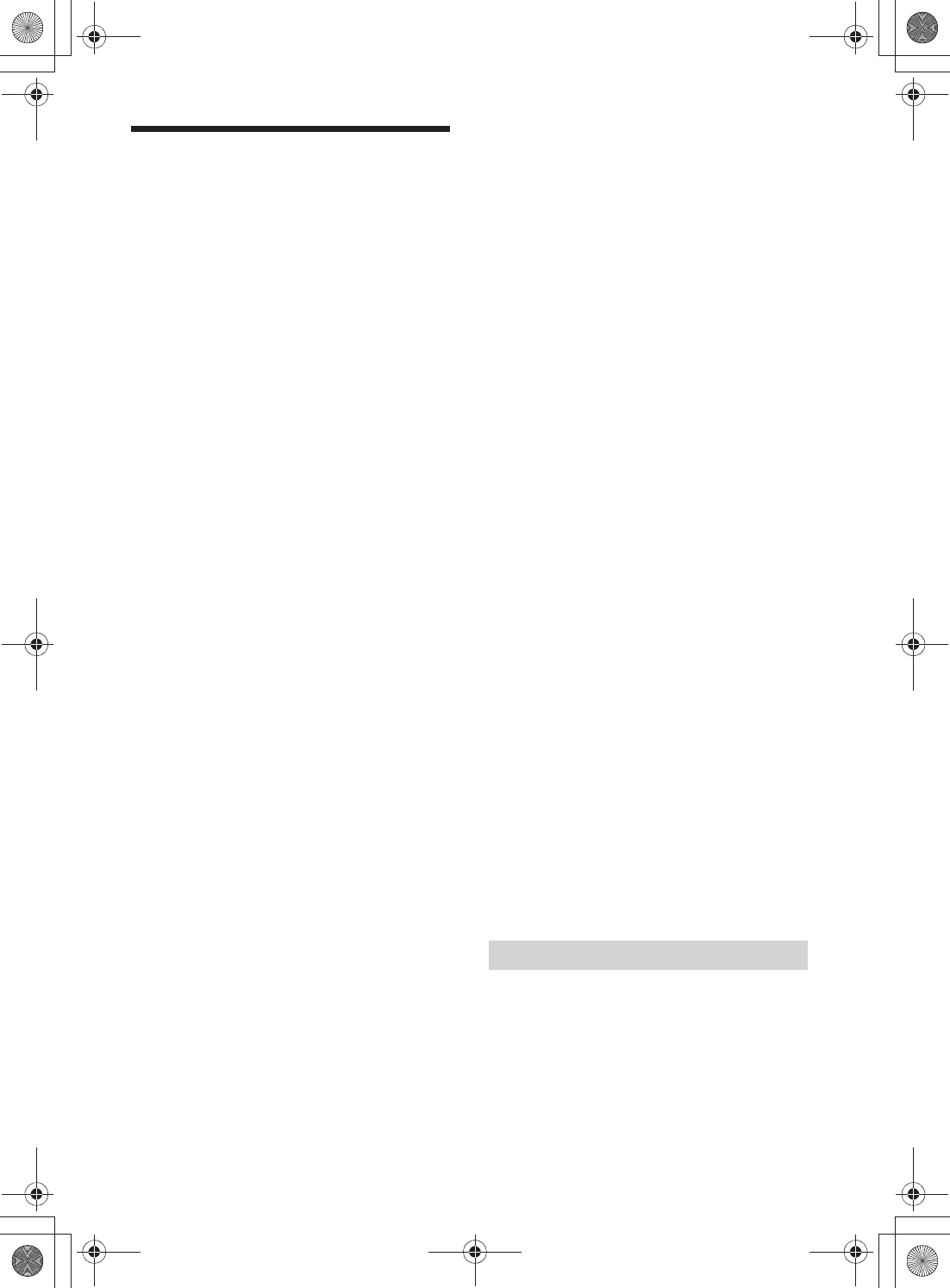
24ES
F:\yoshida\1115\4489688111\4489688111MEXN4000BTUC\02LaES-MEXN4000BTUC\040CD.fm masterpage: Left
MEX-N4000BT
4-489-688-11(1)
Especificaciones
Sección del sintonizador
FM
Rango de sintonización: De 87,5 a 107,9 MHz
Terminal de antena:
Conector de antena externa
Frecuencia intermedia: 25 kHz
Sensibilidad útil: 8 dBf
Selectividad: de 75 dB a 400 kHz
Relación señal-ruido: 80 dB (estéreo)
Separación: de 50 dB a 1 kHz
Respuesta de frecuencia: 20 – 15 000 Hz
AM
Rango de sintonización: De 530 a 1 710 kHz
Terminal de antena:
Conector de antena externa
Frecuencia intermedia:
9 115 kHz o 9 125 kHz/5 kHz
Sensibilidad: 26 μV
Sección del reproductor de CD
Relación señal-ruido: 120 dB
Respuesta de frecuencia: 10 – 20 000 Hz
Fluctuación y trémolo: inferior al límite medible
Códec correspondiente: MP3 (.mp3) y WMA (.wma)
Sección del reproductor USB
Interfaz: USB (alta velocidad)
Corriente máxima: 1 A
Cantidad máxima de pistas reconocibles: 10 000
Códices correspondientes:
MP3 (.mp3), WMA (.wma) y WAV (.wav)
Comunicación inalámbrica
Sistema de comunicación:
BLUETOOTH versión estándar 3.1
Salida:
BLUETOOTH potencia estándar clase 2
(Máx. +4 dBm)
Rango máximo de comunicación:
Línea de visión aprox. 10 m*1
Banda de frecuencia:
Banda 2,4 GHz (2,4000 – 2,4835 GHz)
Método de modulación: FHSS
Perfiles compatibles con la tecnología
BLUETOOTH*2:
A2DP (Perfil de distribución de audio avanzado)
1.3
AVRCP (Perfil de control remoto de audio y
video) 1.5
HFP (Perfil manos libres) 1.6
PBAP (Perfil de acceso a la agenda telefónica)
SPP (Perfil de puerto serie)
MAP (Perfil de acceso a mensajes)
HID (Perfil de dispositivo de interfaz humana)
*1 El alcance real variará según factores, como los
obstáculos entre los dispositivos, los campos
magnéticos alrededor de un horno de microondas,
la electricidad estática, la sensibilidad de recepción,
el funcionamiento de la antena, el sistema
operativo, la aplicación del software, etc.
*2 Los perfiles estándar BLUETOOTH indican el
propósito de la comunicación BLUETOOTH entre
dispositivos.
Sección del amplificador de potencia
Salida: salidas de altavoz
Impedancia de altavoz: 4 – 8 Ω
Salida de potencia máxima: 55 W × 4 (a 4 Ω)
Generales
Salidas:
Terminal de salidas de audio (frontal,
intercambiable entre altavoz potenciador de
graves y posterior)
Antena de alimentación/Terminal de control del
amplificador de potencia (REM OUT)
Entradas:
Terminal de entrada del control remoto
Terminal de entrada de la antena
Terminal de entrada MIC
Toma de entrada AUX (minitoma estéreo)
Puerto USB
Requisitos de alimentación: batería de automóvil
de cc 12 V (masa negativa [tierra])
Dimensiones:
Aprox.: 178 mm × 50 mm × 177 mm (an./al./prf.)
Dimensiones de montaje:
Aprox.: 182 mm × 53 mm × 160 mm (an./al./prf.)
Peso: aprox. 1,2 kg
Contenidos del paquete:
Unidad principal (1)
Control remoto (1): RM-X231
Componentes de instalación y conexiones
(1 juego)
Equipo y accesorios opcionales:
Micrófono: XA-MC10
Es posible que su distribuidor no comercialice
algunos de los accesorios que figuran en la lista
anterior. Solicite información detallada.
El diseño y las especificaciones están sujetos a
cambios sin previo aviso.
La marca de la palabra y logotipos Bluetooth® son
marcas comerciales registradas y son propiedad de
Bluetooth SIG, Inc., y Sony Corporation posee
licencia para utilizar cualquiera de dichas marcas.
Otras marcas registradas y nombres comerciales
pertenecen a sus respectivos propietarios.
Derechos de autor
010COV.book Page 24 Friday, November 15, 2013 11:49 AM
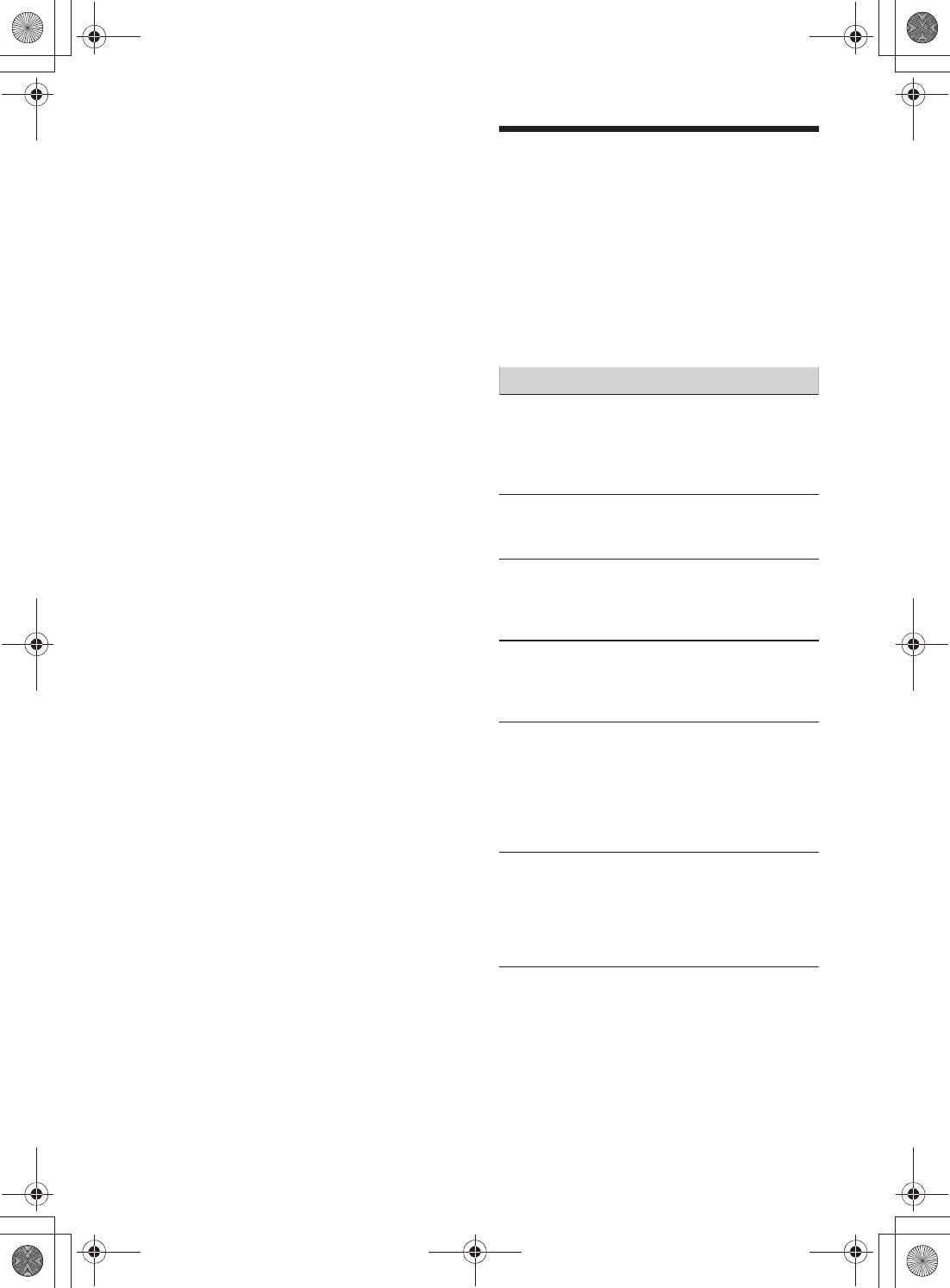
25ES
F:\yoshida\1115\4489688111\4489688111MEXN4000BTUC\02LaES-MEXN4000BTUC\040CD.fm masterpage: Right
MEX-N4000BT
4-489-688-11(1)
La marca N es una marca comercial o marca
registrada de NFC Forum, Inc. en los Estados Unidos
y en otro países.
Windows Media es una marca comercial registrada
o una marca comercial de Microsoft Corporation en
los EE. UU. y otros países.
Este producto está protegido por los derechos de
propiedad intelectual de Microsoft Corporation.
Queda prohibido el uso o la distribución de esta
tecnología fuera de este producto si no se dispone
de una licencia de Microsoft o una división
autorizada de Microsoft.
iPhone, iPod, iPod classic, iPod nano, y iPod touch
son marcas comerciales de Apple Inc., registradas
en los Estados Unidos y otros países. App Store es
una marca de servicio de Apple Inc.
Tecnología de codificación de audio MPEG Layer-3 y
patentes bajo licencia de Fraunhofer IIS y Thomson.
Pandora, el logotipo de Pandora y la imagen de la
marca Pandora son marcas comerciales o marcas
comerciales registradas de Pandora Media, Inc.,
utilizadas con autorización.
Google, Google Play y Android son marcas
comerciales de Google Inc.
BlackBerry® es propiedad de Research In Motion
Limited y está registrada y/o se utiliza en los EE.UU.
y en países de todo el mundo. Se utiliza bajo
licencia de Research In Motion Limited.
Solución de problemas
La siguiente lista de comprobación le ayudará a
solucionar los problemas que puedan producirse
con la unidad.
Antes de consultarla, revise los procedimientos de
conexión y de funcionamiento.
Para obtener más detalles acerca de cómo utilizar el
fusible y cómo retirar la unidad del tablero, consulte
el manual de instalación y de conexiones
suministrado con esta unidad.
Si el problema no se resuelve, visite el sitio web de
soporte técnico que figura en la cubierta posterior.
Generales
La unidad no recibe alimentación.
qSi la unidad está apagada y la pantalla
desaparece, no se puede operar con el control
remoto.
ˋEncienda la unidad.
No se emite el sonido.
qLa posición del control de equilibrio [FADER] no
está ajustada para un sistema de 2 altavoces.
No se escuchan pitidos.
qSe encuentra conectado un amplificador de
potencia opcional y no está usando el
amplificador integrado.
El contenido de la memoria se borró.
qSe desconectó la batería o el cable de fuente de
alimentación, o no están conectados
correctamente.
Las emisoras almacenadas y la hora correcta se
borraron.
El fusible se fundió.
Se escucha un ruido cuando se cambia la
posición de la llave de encendido.
qLos cables no se conectaron de forma correcta al
conector de alimentación auxiliar del automóvil.
Durante la reproducción o la recepción, el modo
demostración se inicia.
qSi no se realiza ninguna operación durante
5 minutos y la opción [DEMO-ON] está ajustada,
se iniciará el modo de demostración.
ˋAjuste [DEMO-OFF] (página 20).
Las indicaciones desaparecen del visualizador o
no aparecen en él.
qEl atenuador está ajustado en [DIM-ON]
(página 20).
qLa pantalla se apaga si mantiene presionado OFF.
ˋPresione OFF en la unidad hasta que se ilumine
la pantalla.
qLos conectores están sucios (página 23).
010COV.book Page 25 Friday, November 15, 2013 11:49 AM

26ES
F:\yoshida\1115\4489688111\4489688111MEXN4000BTUC\02LaES-MEXN4000BTUC\040CD.fm masterpage: Left
MEX-N4000BT
4-489-688-11(1)
Los botones de operación no funcionan.
El disco no se expulsa.
qPresionar PTY y (volver)/MODE por más de
2 segundos para realizar la restauración de la
unidad.
Los contenidos almacenados en la memoria son
eliminados.
Por su seguridad, no realice la restauración de la
unidad mientras maneja.
Recepción de radio
No es posible recibir emisoras.
Hay ruidos que obstaculizan el sonido.
qLa conexión no es correcta.
ˋSi su automóvil cuenta con una antena de radio
incluida en el vidrio lateral o posterior, conecte
un cable REM OUT (con rayas azules y blancas)
o un cable de fuente de alimentación accesorio
(rojo) al cable de fuente de alimentación del
amplificador de señal de la antena del
automóvil.
ˋCompruebe la conexión de la antena del
automóvil.
ˋSi la antena del automóvil no se extiende,
compruebe la conexión del cable de control de
la antena motorizada.
No es posible utilizar la sintonización
programada.
qLa señal de emisión es demasiado débil.
RDS
PTY muestra [- - - - - - - -].
qLa emisora actual no es una emisora RDS.
qNo se recibieron datos RDS.
qLa emisora no especifica el tipo de programa.
Reproducción de CD
No se inicia la reproducción.
qDisco defectuoso o sucio.
qLos discos CD-R/CD-RW no son para audio
(página 21).
No es posible reproducir archivos MP3/WMA.
qEl disco no es compatible con el formato y la
versión de MP3/WMA. Para obtener más
información acerca de los discos y formatos que
se pueden reproducir, visite el sitio web de
soporte técnico en línea.
Los archivos MP3/WMA tardan más tiempo en
reproducirse que los demás.
qEl inicio de la reproducción de los siguientes
discos tarda algo más de tiempo.
ˋDisco grabado con una estructura de árbol
complicada.
ˋDisco grabado en Multi Session.
ˋDisco al que es posible añadir datos.
Se producen saltos de sonido.
qDisco defectuoso o sucio.
Reproducción USB
No es posible reproducir elementos a través de
un concentrador USB.
qEsta unidad no puede reconocer dispositivos USB
a través de un concentrador USB.
El dispositivo USB tarda en reproducirse.
qEl dispositivo USB contiene archivos con una
estructura de árbol compleja.
El sonido es discontinuo.
qEs posible que la discontinuidad del sonido se
deba a una tasa alta de bits de más de 320 kbps.
No es posible la conexión Pandora®.
qCierre la aplicación Pandora® en el dispositivo
móvil, y luego inicie nuevamente.
El nombre de la aplicación no coincide con la
aplicación real en App Remote.
qInicie la aplicación nuevamente desde la
aplicación “App Remote”.
Función NFC
La conexión One touch (NFC) no es posible.
qSi el smartphone no responde al tacto.
ˋRevise que la función NFC del smartphone esté
encendida.
ˋMueva la parte marca N del smartphone de
modo de acercarla a la parte marca N de esta
unidad.
ˋSi el smartphone se encuentra dentro de un
estuche, quítelo.
qLa sensibilidad de recepción NFC depende del
dispositivo.
Si la conexión One touch con el smartphone falla
varias veces, haga la conexión a BLUETOOTH en
forma manual.
Función BLUETOOTH
El dispositivo de conexión no puede detectar
esta unidad.
qAntes de realizar el emparejamiento, configure
esta unidad en el modo de espera del
emparejamiento.
qMientras se conecta al otro dispositivo
BLUETOOTH, esta unidad no puede detectarse
desde otro dispositivo.
ˋDesconecte la conexión actual y busque esta
unidad desde otro dispositivo.
qUna vez realizado el emparejamiento del
dispositivo, active la salida de señal de
BLUETOOTH (página 8).
010COV.book Page 26 Friday, November 15, 2013 11:49 AM

27ES
F:\yoshida\1115\4489688111\4489688111MEXN4000BTUC\02LaES-MEXN4000BTUC\040CD.fm masterpage: Right
MEX-N4000BT
4-489-688-11(1)
No es posible realizar la conexión.
qLa conexión se controla de un solo lado (esta
unidad o dispositivo BLUETOOTH) pero no de
ambos lados.
ˋConecte esta unidad a un dispositivo
BLUETOOTH o viceversa.
No aparece el nombre del dispositivo detectado.
qSegún el estado del otro dispositivo, es posible
que no se pueda obtener el nombre.
No se emite ningún tono de llamada.
qAjuste el volumen girando el selector de control
mientras recibe una llamada.
qSegún el dispositivo de conexión, es posible que
el tono de llamada no se emita correctamente.
ˋAjuste [RINGTONE] en [1] (página 20).
qLos altavoces frontales no están conectados a la
unidad.
ˋConecte los altavoces frontales a la unidad. El
tono de llamada suena solamente desde los
altavoces frontales.
No se puede ajustar el volumen de la voz de la
persona que habla.
qLos altavoces frontales no están conectados a la
unidad.
ˋConecte los altavoces frontales a la unidad. La
voz del que habla y la voz del auricular solo
salen de los altavoces frontales.
El interlocutor de una llamada le notifica que el
volumen es demasiado bajo o demasiado alto.
qAjuste el volumen según corresponda mediante
la ganancia de micrófono (página 16).
Se producen ecos o ruidos durante las
conversaciones telefónicas.
qBaje el volumen.
qAjuste el modo EC/NC en [EC/NC-1] o [EC/NC-2]
(página 16).
qSi el sonido ambiente que no sea el sonido de la
llamada de teléfono es alto, intente reducir el
ruido.
Por ej.: si una ventana está abierta y se oye ruido
de la calle, etc., fuerte, cierre la ventana. Si el aire
acondicionado está alto, bájelo.
El teléfono no está conectado.
qDurante la reproducción de audio BLUETOOTH, el
teléfono no está conectado aunque presione
CALL.
ˋRealice la conexión desde el teléfono.
La calidad de sonido del teléfono es baja.
qLa calidad del sonido del teléfono depende de las
condiciones de recepción del teléfono celular.
ˋMueva el automóvil a un lugar en el que pueda
mejorar la señal del teléfono celular si la
recepción es de mala calidad.
El volumen del dispositivo de audio conectado es
bajo (alto).
qEl nivel de volumen cambiará dependiendo del
dispositivo de audio.
ˋAjuste el volumen del dispositivo de audio
conectado o de esta unidad.
El sonido salta durante la reproducción de un
dispositivo de audio BLUETOOTH.
qReduzca la distancia entre la unidad y el
dispositivo de audio BLUETOOTH.
qSi el dispositivo de audio BLUETOOTH está
guardado en un estuche que interrumpe la señal,
retírelo mientras lo utilice.
qEn los alrededores se están utilizando varios
dispositivos BLUETOOTH u otros dispositivos que
emiten ondas de radio.
ˋApague los otros dispositivos.
ˋAumente la distancia entre la unidad y los otros
dispositivos.
qEl sonido de reproducción se detiene
momentáneamente mientras se establece la
conexión entre esta unidad y el teléfono celular.
No se trata de una falla de funcionamiento.
No es posible controlar el dispositivo de audio
BLUETOOTH conectado.
qCompruebe que el dispositivo de audio
BLUETOOTH conectado sea compatible con
AVRCP.
Algunas funciones no están disponibles.
qCompruebe que el dispositivo de conexión sea
compatible con las funciones en cuestión.
Se contesta una llamada accidentalmente.
qEl teléfono conectado está configurado para
responder una llamada automáticamente.
El emparejamiento ha fallado porque se ha
superado el tiempo establecido.
qSegún el dispositivo de conexión, es posible que
el tiempo para el emparejamiento sea escaso.
ˋIntente completar el emparejamiento en el
tiempo establecido.
No es posible utilizar la función BLUETOOTH.
qApague la unidad presionando OFF durante más
de 2 segundos, luego vuelva a encender la
unidad.
Durante la llamada con manos libres, los
altavoces del automóvil no emiten ningún
sonido.
qSi el sonido de salida viene del teléfono celular,
ajuste el teléfono para que el sonido se emita por
los altavoces del automóvil.
No es posible la conexión Pandora®.
qInicie la aplicación Pandora® en el dispositivo
móvil, y luego inicie nuevamente.
010COV.book Page 27 Friday, November 15, 2013 11:49 AM
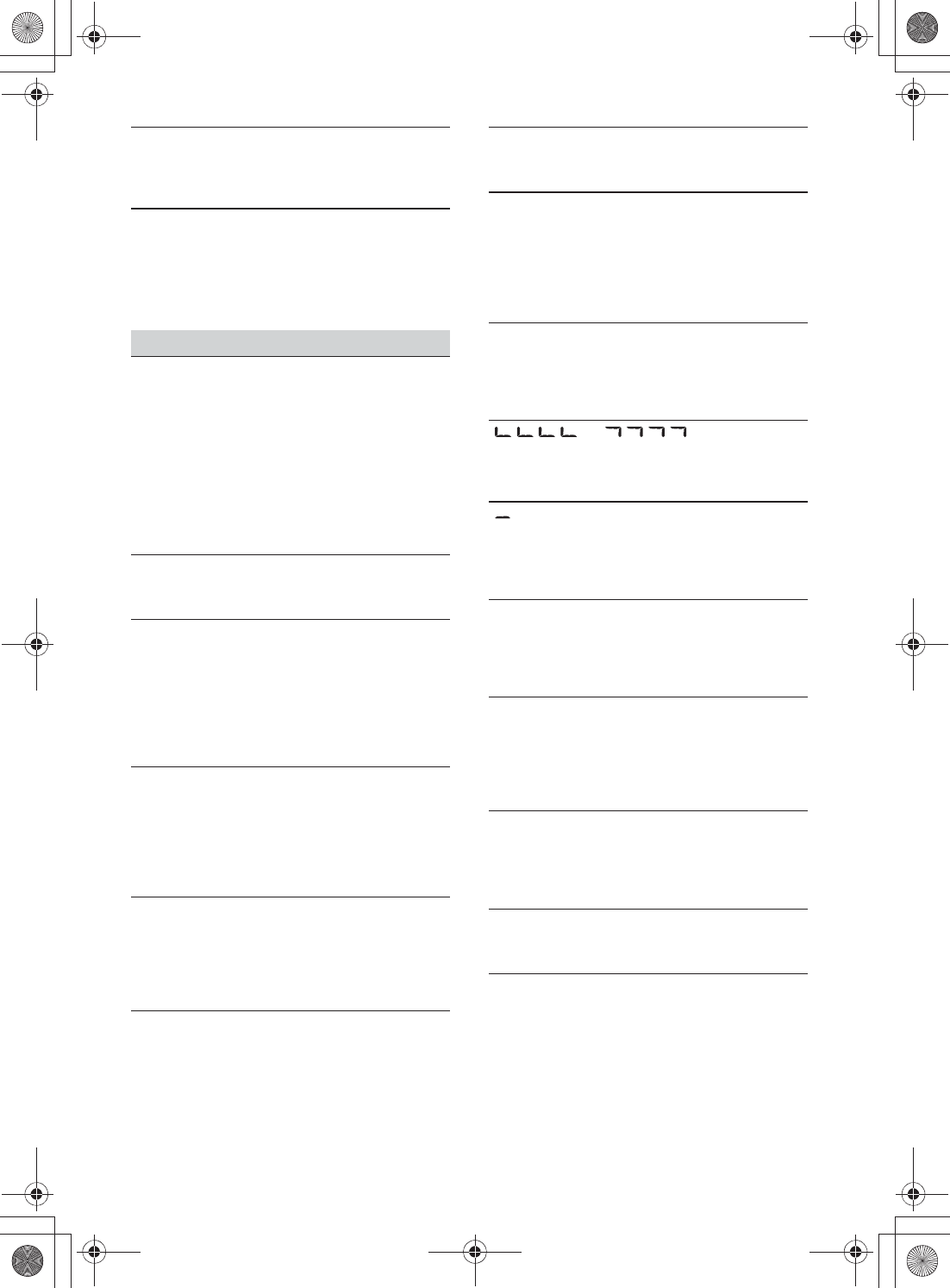
28ES
F:\yoshida\1115\4489688111\4489688111MEXN4000BTUC\02LaES-MEXN4000BTUC\040CD.fm masterpage: Left
MEX-N4000BT
4-489-688-11(1)
El nombre de la aplicación no coincide con la
aplicación real en App Remote.
qInicie la aplicación nuevamente desde la
aplicación “App Remote”.
Cuando ejecute la aplicación “App Remote”
mediante BLUETOOTH, la pantalla cambia
automáticamente a [BT AUDIO].
qLa aplicación “App Remote” o la función
BLUETOOTH han fallado.
ˋEjecute la aplicación nuevamente.
Mensajes/indicaciones de error
ERROR
qEl disco está sucio o se insertó al revés.
ˋLímpielo o insértelo de forma correcta.
qSe insertó un disco vacío.
qNo es posible reproducir el disco debido a un
problema.
ˋInserte otro disco.
qEl dispositivo USB no ha sido reconocido
automáticamente.
ˋConéctelo nuevamente.
qPresione ì para extraer el disco.
HUB NO SUPRT (No admite concentradores)
qEl concentrador USB no es compatible con esta
unidad.
IPD STOP (Detener iPod)
qCuando no se selecciona la reproducción
repetida, la reproducción termina con la última
pista del álbum.
Se finaliza la aplicación de música del iPod/
iPhone.
ˋPresione PAUSE para volver a comenzar la
reproducción.
NO DEV (No hay dispositivo)
q[USB] se selecciona como fuente sin que esté
conectado un dispositivo USB. Se ha
desconectado un dispositivo USB o un cable USB
durante la reproducción.
ˋAsegúrese de conectar un dispositivo USB y un
cable USB.
NO MUSIC
qEl disco o dispositivo USB no contiene ningún
archivo de música.
ˋInserte un CD de música.
ˋConecte un dispositivo USB que contenga
algún archivo de música.
OVERLOAD
qEl dispositivo USB está sobrecargado.
ˋDesconecte el dispositivo USB y, a
continuación, presione SRC para cambiar la
fuente.
ˋEl dispositivo USB tiene una falla, o se ha
conectado un dispositivo incompatible.
PUSH EJT (Presione expulsar)
qNo es posible expulsar el disco.
ˋPresione ì (expulsar).
READ
qLa unidad está leyendo toda la información de
pistas y de álbumes del disco.
ˋEspere hasta que finalice la lectura y se inicie la
reproducción automáticamente. Es posible que
demore más de un minuto en función de la
estructura del disco.
USB NO SUPRT (USB no compatible)
qEl dispositivo USB conectado no es compatible.
ˋPara obtener más información acerca de la
compatibilidad del dispositivo USB, visite el
sitio web de soporte técnico.
[] o []
qDurante la operación de avance o retroceso
rápido, llegó al principio o al final del disco, por lo
que no es posible continuar.
[]
qNo se puede mostrar el carácter.
Acerca de la función BLUETOOTH:
BT BUSY (BLUETOOTH no disponible)
qLa agenda telefónica y el historial de llamadas
del teléfono celular no son accesibles mediante
esta unidad.
ˋEspere un momento e inténtelo nuevamente.
ERROR
qFalló BT Initialize.
qFalló el acceso a la agenda telefónica.
qEl contenido de la agenda telefónica ha sido
modificado durante el acceso al teléfono celular.
ˋAcceda a la agenda telefónica nuevamente.
MEM FAILURE (Error de memoria)
qLa unidad no pudo almacenar el contacto en la
marcación predefinida.
ˋAsegúrese de que el número que desea
almacenar sea correcto (página 15).
MEMORY BUSY
qEsta unidad está almacenando datos.
ˋEspere a que termine el almacenamiento.
NO DEV (No hay dispositivo)
qLa fuente de audio BLUETOOTH se selecciona sin
que esté conectado un dispositivo BLUETOOTH.
El dispositivo de audio BLUETOOTH se ha
desconectado durante una llamada.
ˋAsegúrese de conectar un dispositivo de audio
BLUETOOTH.
010COV.book Page 28 Friday, November 15, 2013 11:49 AM
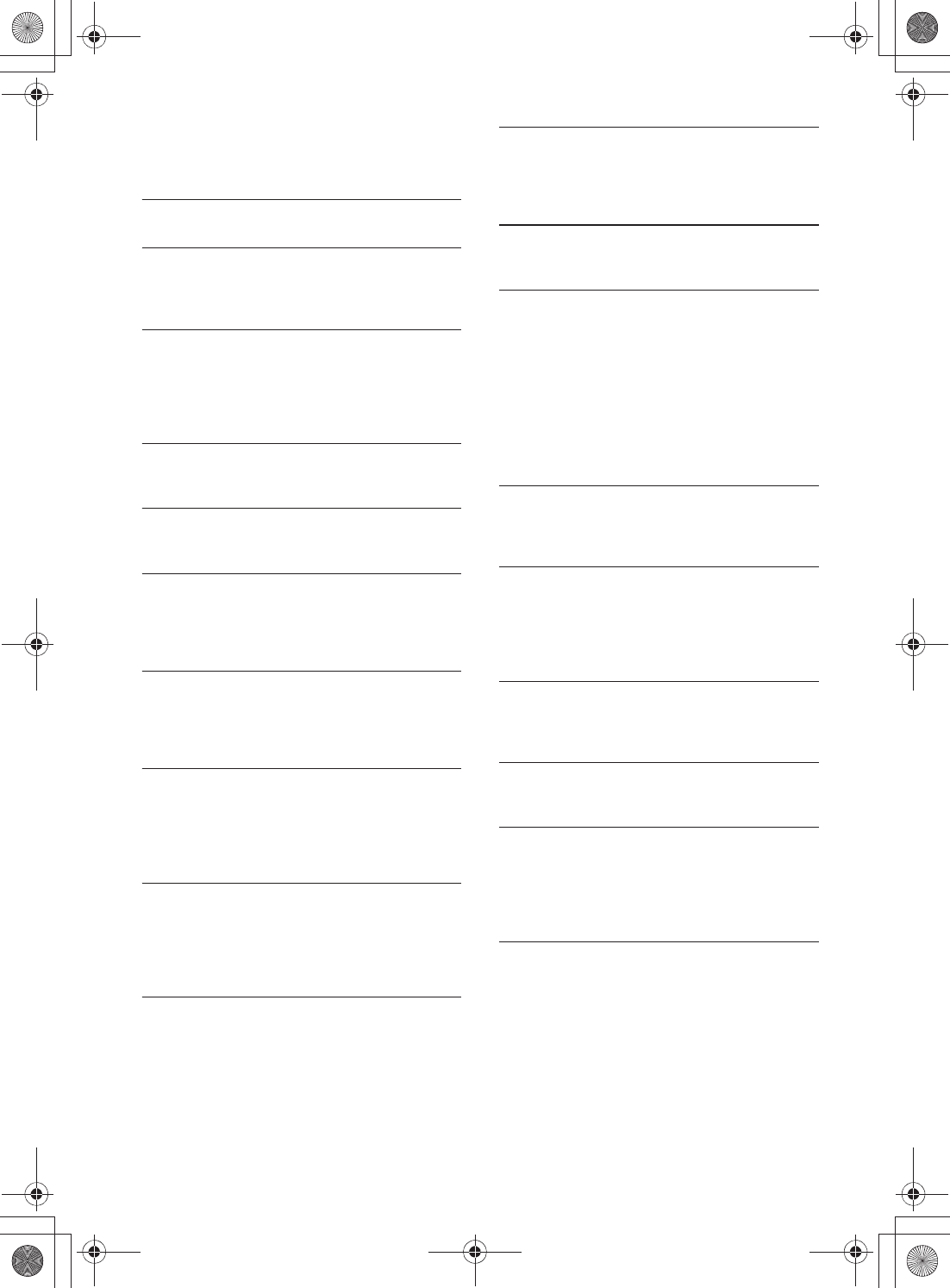
29ES
F:\yoshida\1115\4489688111\4489688111MEXN4000BTUC\02LaES-MEXN4000BTUC\040CD.fm masterpage: Right
MEX-N4000BT
4-489-688-11(1)
qLa fuente del teléfono BLUETOOTH se selecciona
sin un teléfono celular conectado. El teléfono
celular se ha desconectado durante una llamada.
ˋAsegúrese de conectar un teléfono celular.
P EMPTY (número predefinido)
qLa marcación preajustada está vacía.
UNKNOWN
qEl nombre o el número de teléfono no se pueden
visualizar al explorar una agenda telefónica o un
historial de llamadas.
WITHHELD
qLa persona que llama oculta el número de
teléfono.
Para el funcionamiento de App Remote:
APP -------- (Aplicación)
qNo se logró la conexión con la aplicación.
ˋEstablezca la conexión de iPhone nuevamente.
APP DISCNCT (Aplicación desconectada)
qLa conexión App Remote no se pudo establecer.
ˋEstablecer la conexión App Remote (página 17).
APP MENU (Menú de aplicaciones)
qLa operación de los botones no puede realizarse
mientras haya algún menú abierto en el iPhone/
teléfono Android.
ˋSalga del menú en el iPhone/teléfono Android.
APP NO DEV (Aplicación sin dispositivo)
qEl dispositivo con la aplicación instalada no está
conectado.
ˋConecte el dispositivo y luego establezca la
conexión del iPhone.
APP SOUND (Sonido de la aplicación)
qLa operación de los botones no puede realizarse
mientras haya algún menú de sonidos abierto en
el iPhone/teléfono Android.
ˋSalga del menú de sonidos en el iPhone/
teléfono Android.
OPEN APP (Abrir aplicación)
qLa aplicación “App Remote” no está funcionando.
ˋInicie la aplicación del iPhone.
Para la utilización de Pandora®:
CANNOT SKIP
qNo se permite saltear pistas en Pandora®.
ˋEspere hasta que finalice el comercial.
ˋPandora® limita la cantidad de salteos
permitidos en su servicio. Espere a que
comience la siguiente pista o seleccione otra
emisora de la lista.
ERROR
qFallaron los comentarios de “Pulgares”.
ˋIntente “Pulgares arriba/abajo” nuevamente.
qFalló la marcación como favorito.
ˋIntente marcar como favorito nuevamente.
NO STATION
qNo hay emisoras en su cuenta de Pandora®.
ˋCree una emisora en el dispositivo móvil.
NOT ALLOWED
qNo se permiten los comentarios de “Pulgares”.
ˋEspere hasta que finalice el comercial.
ˋAlgunas funciones, tales como Emisora
compartida, no permiten comentarios. Espere
a que comience la siguiente pista o seleccione
otra emisora de la lista.
qNo se permite marcar como favorito.
ˋEspere hasta que finalice el comercial.
ˋSeleccione otra pista o emisora y vuelva a
intentarlo.
OPEN APP (abrir aplicación)
Cuando se conecta a través del puerto USB.
qPandora® no inicia.
ˋInicie la aplicación Pandora® en el iPhone.
OPEN APP (abrir aplicación), PRESS PAUSE
Cuando se conecta a través de la función
BLUETOOTH.
qPandora® no inicia.
ˋInicie la aplicación Pandora® en el dispositivo
móvil, luego presione PAUSE.
PAN NO SUPRT (Pandora® no compatible)
qEl dispositivo conectado no es compatible.
ˋPara obtener detalles sobre los dispositivos
compatibles, visite el sitio de soporte técnico.
PAN RESTRICT (restricción de licencias Pandora®)
qPandora® no se encuentra disponible fuera de su
país.
PLEASE LOGIN, PANDORA APP (aplicación
Pandora®)
qNo inició sesión en su cuenta Pandora®.
ˋDesconecte el dispositivo e inicie sesión en su
cuenta Pandora®, luego vuelva a conectar el
dispositivo.
--:--
qSe perdió la conexión de red o esta es inestable.
ˋRealice nuevamente la conexión de red en el
dispositivo.
ˋEspere hasta que se establezca la conexión de
red.
Si estas soluciones no ayudan a solucionar el
problema, póngase en contacto con el distribuidor
Sony más cercano.
010COV.book Page 29 Friday, November 15, 2013 11:49 AM

30ES
F:\yoshida\1115\4489688111\4489688111MEXN4000BTUC\02LaES-MEXN4000BTUC\040CD.fm masterpage: Left
MEX-N4000BT
4-489-688-11(1)
Si entrega la unidad para su reparación a causa de
problemas en la reproducción de CD, lleve el disco
que se utilizó cuando se produjo el problema.
010COV.book Page 30 Friday, November 15, 2013 11:49 AM

F:\yoshida\1115\4489688111\4489688111MEXN4000BTUC\02LaES-MEXN4000BTUC\040CD.fm masterpage: Blank.R
MEX-N4000BT
4-489-688-11(1)
010COV.book Page 31 Friday, November 15, 2013 11:49 AM

F:\yoshida\1115\4489688111\4489688111MEXN4000BTUC\02LaES-MEXN4000BTUC\040CD.fm masterpage: Blank.L
MEX-N4000BT
4-489-688-11(1)
010COV.book Page 32 Friday, November 15, 2013 11:49 AM

F:\yoshida\1115\4489688111\4489688111MEXN4000BTUC\02LaES-MEXN4000BTUC\040CD.fm masterpage: Blank.R
MEX-N4000BT
4-489-688-11(1)
010COV.book Page 33 Friday, November 15, 2013 11:49 AM

F:\yoshida\1115\4489688111\4489688111MEXN4000BTUC\01GB-MEXN4000BTUC\050BCO.fm masterpage: BCO
MEX-N4000BT
4-489-688-11(1)
http://www.sony.net/
©2013 Sony Corporation Printed in Thailand
http://esupport.sony.com
http://www.sony.com/caraudio
If you have any questions/problems
regarding this product, try the following:
1
Read Troubleshooting in these
Operating Instructions.
2
Please contact (U.S.A. only);
Call 1-800-222-7669
URL http://www.SONY.com
010COV.book Page 28 Friday, November 15, 2013 11:49 AM